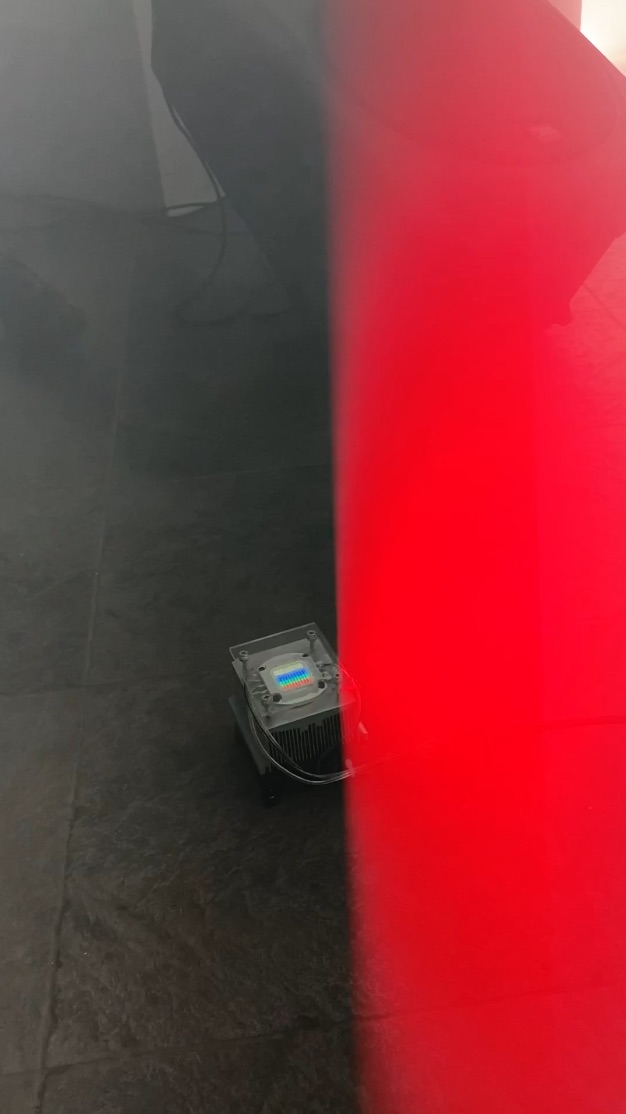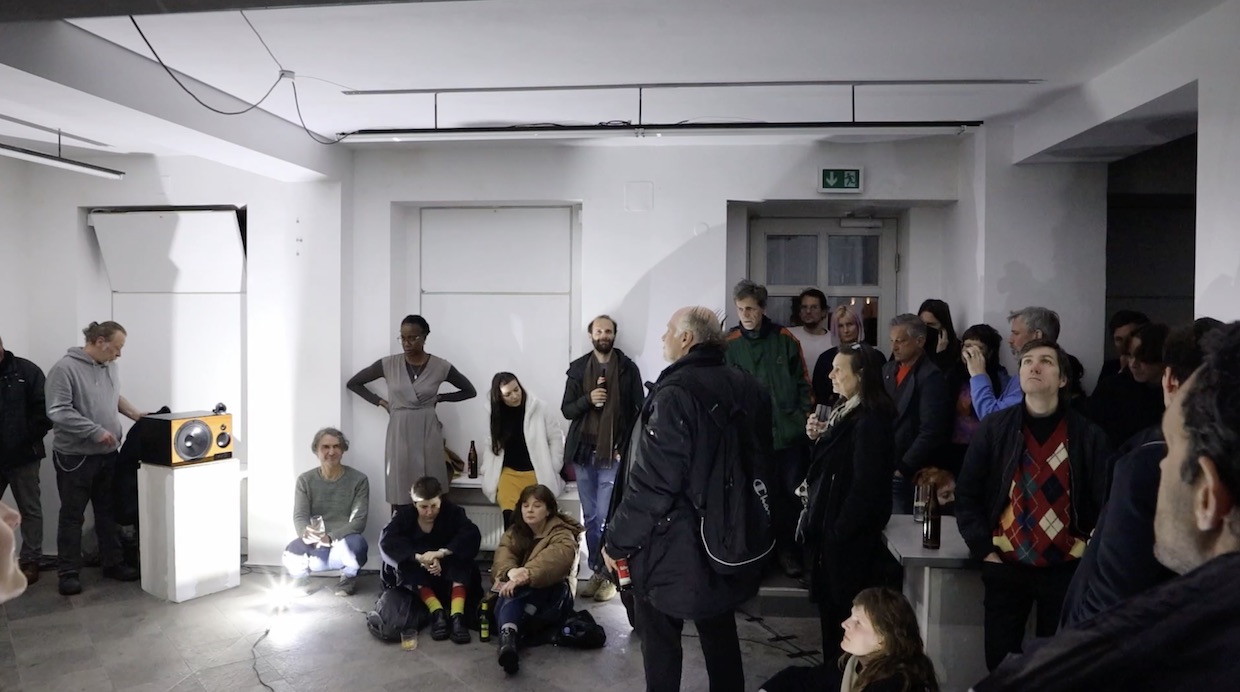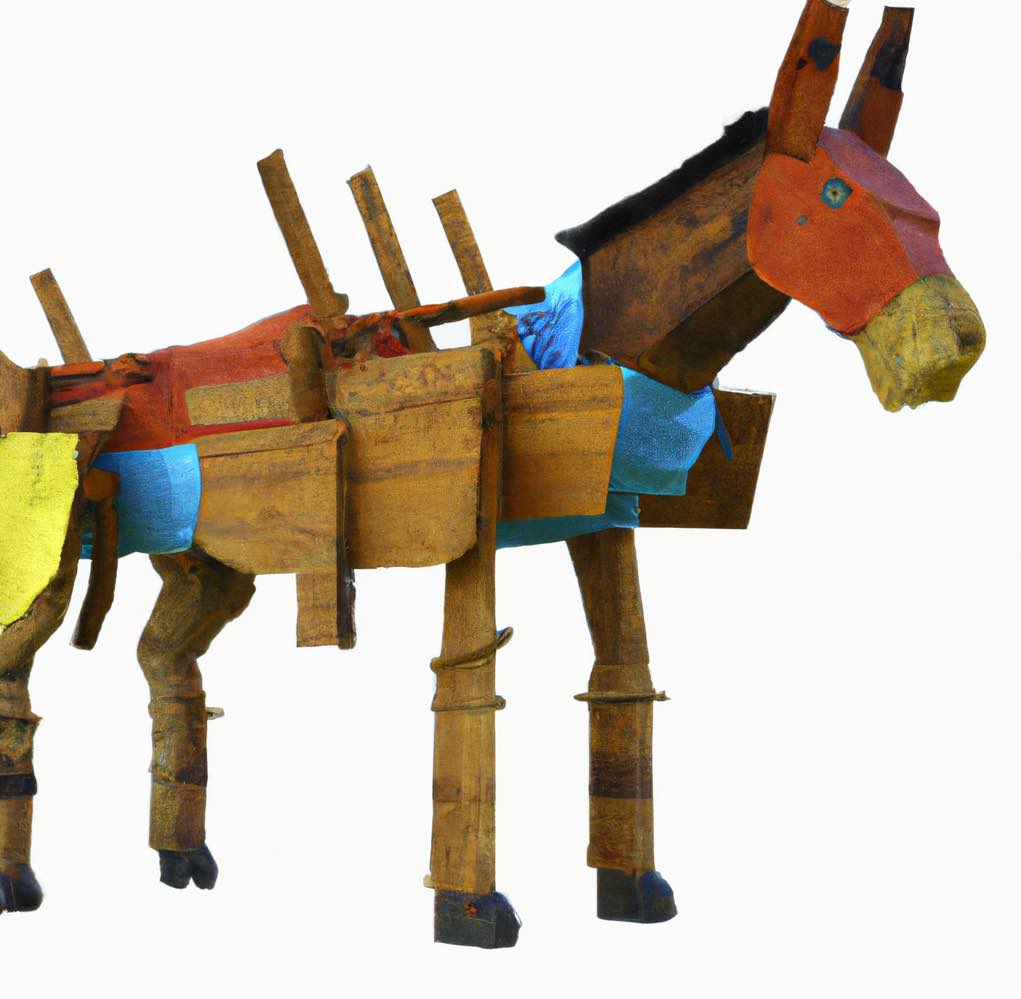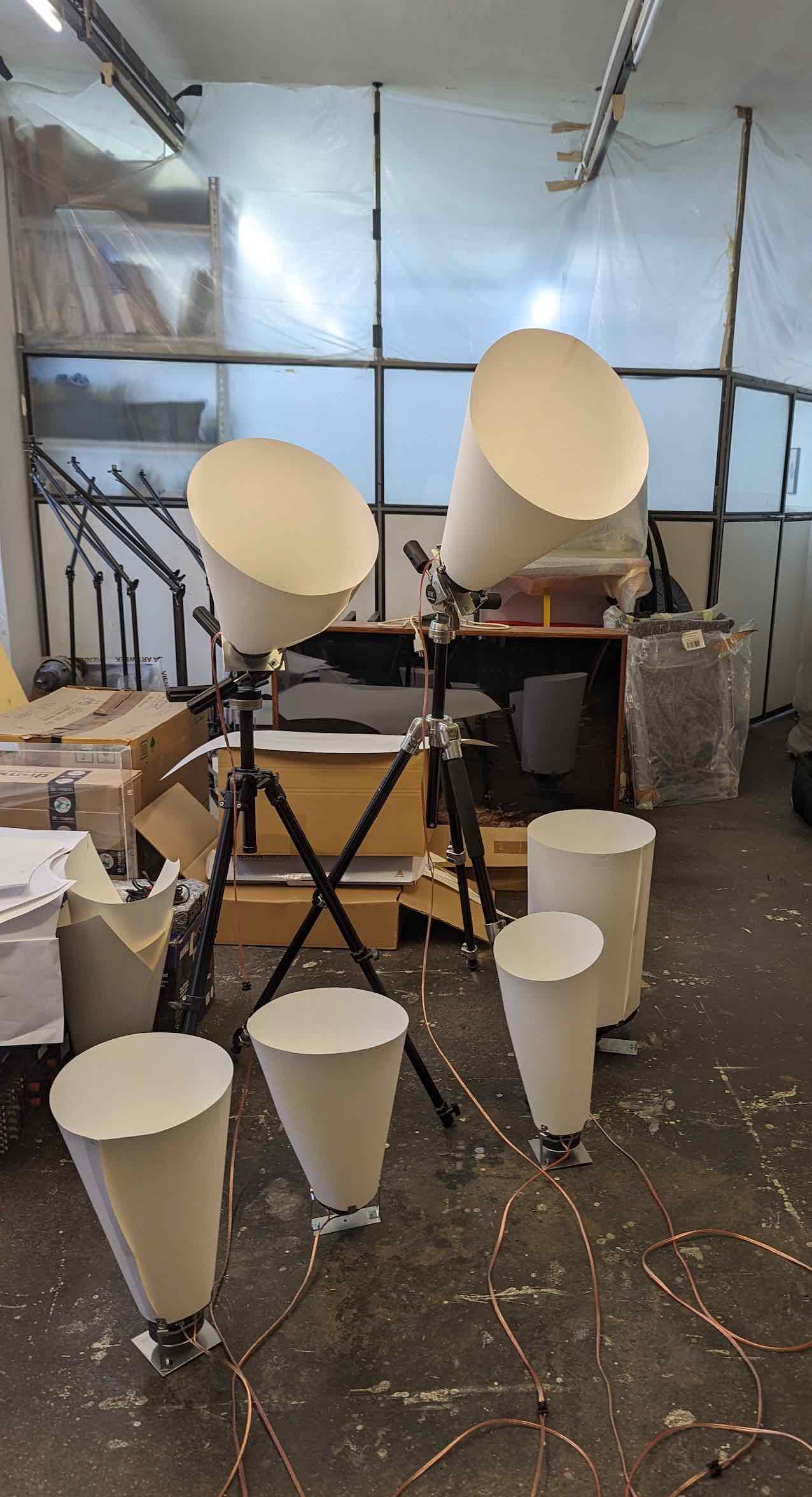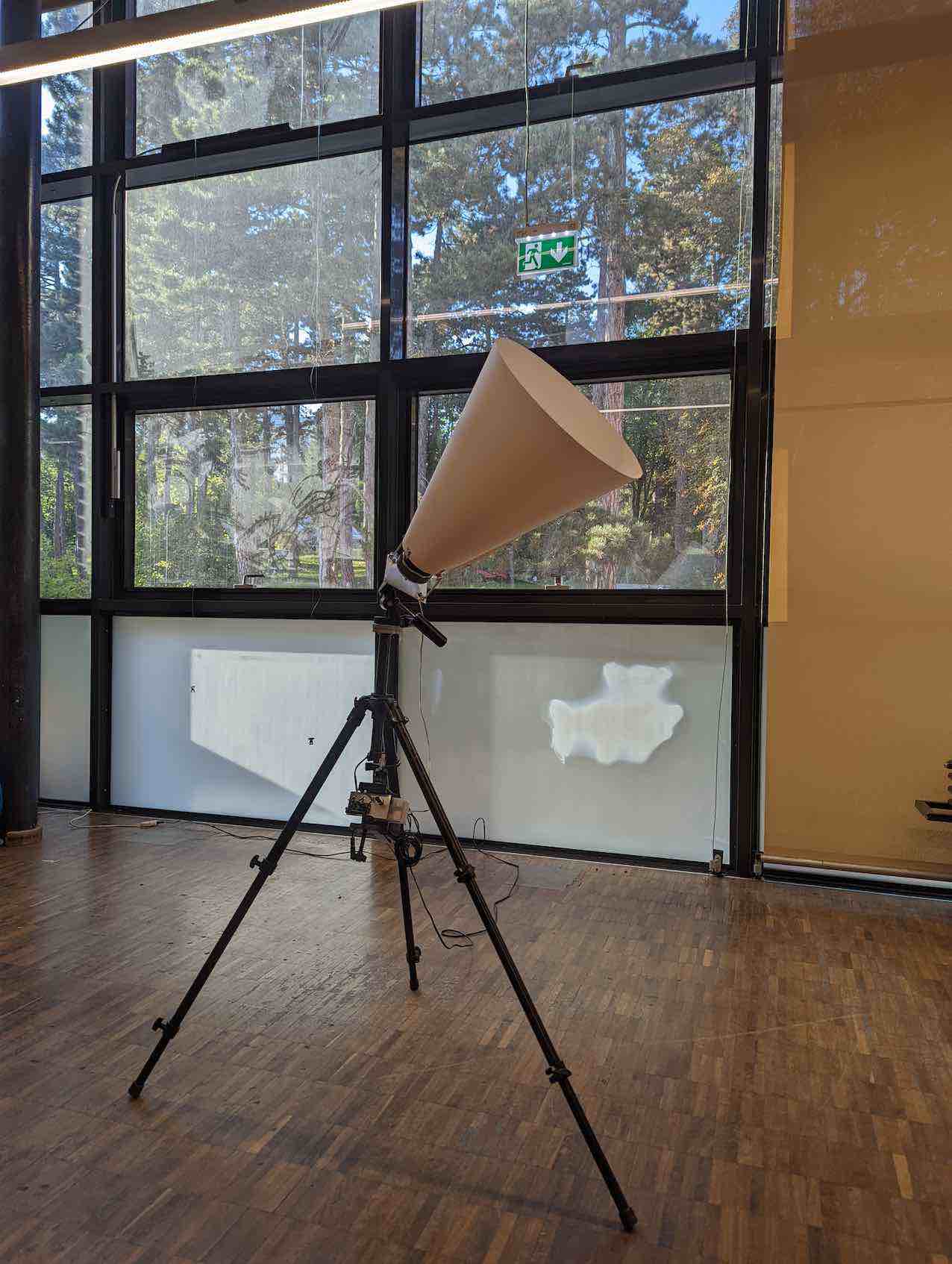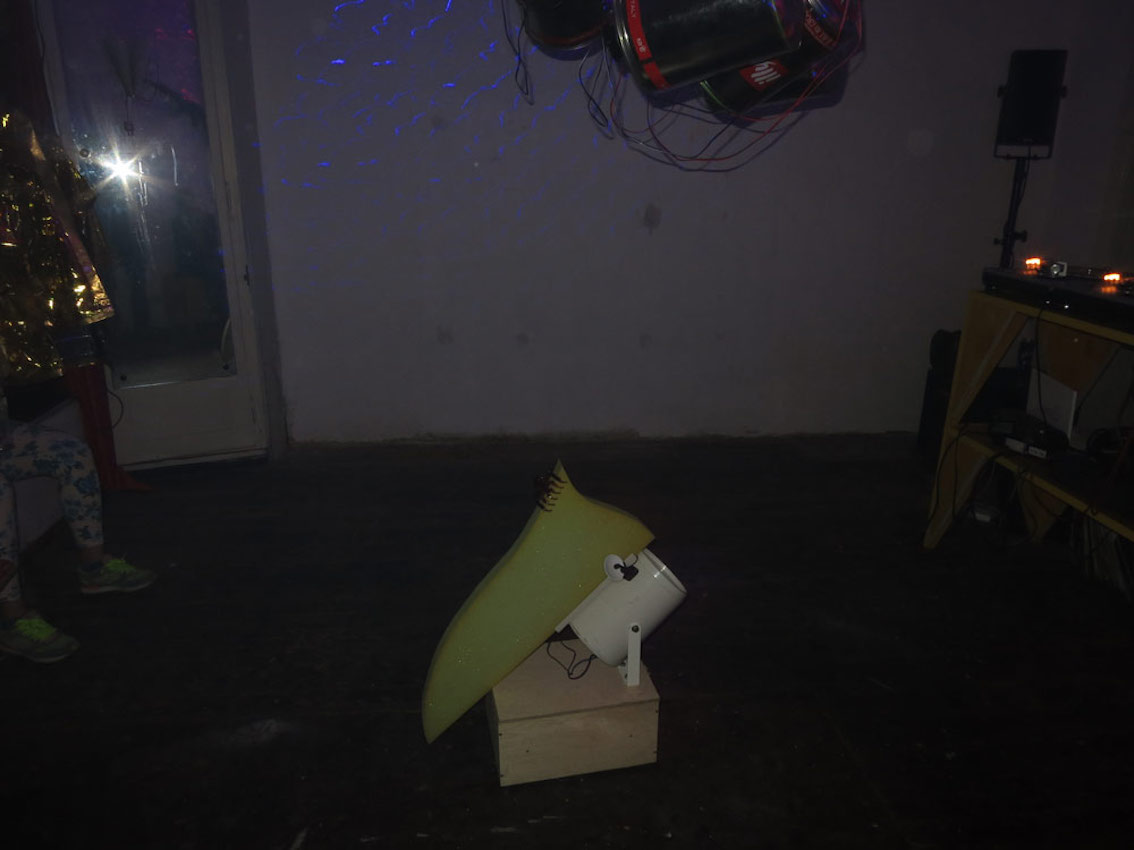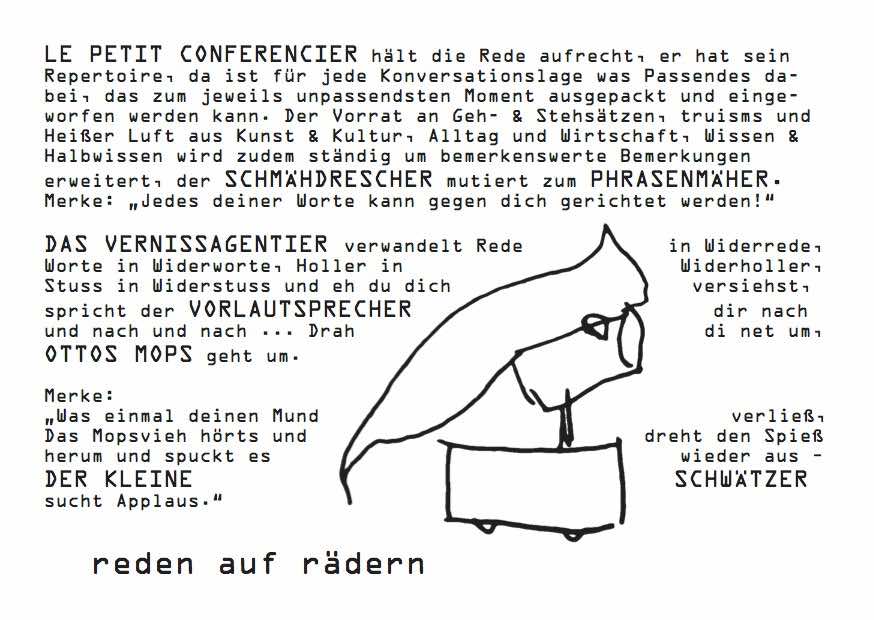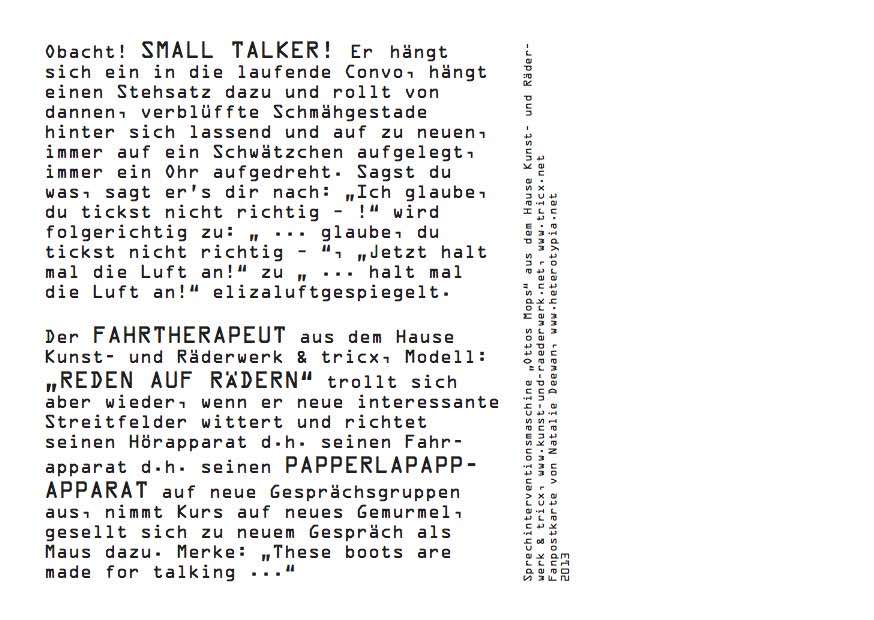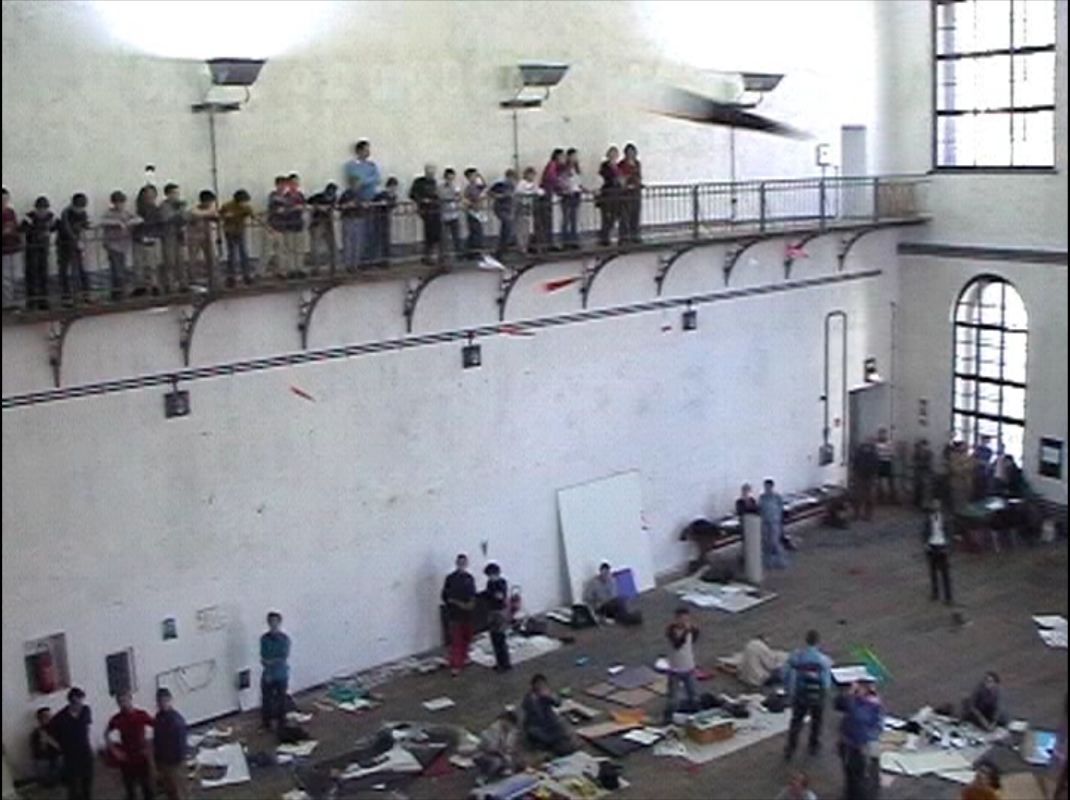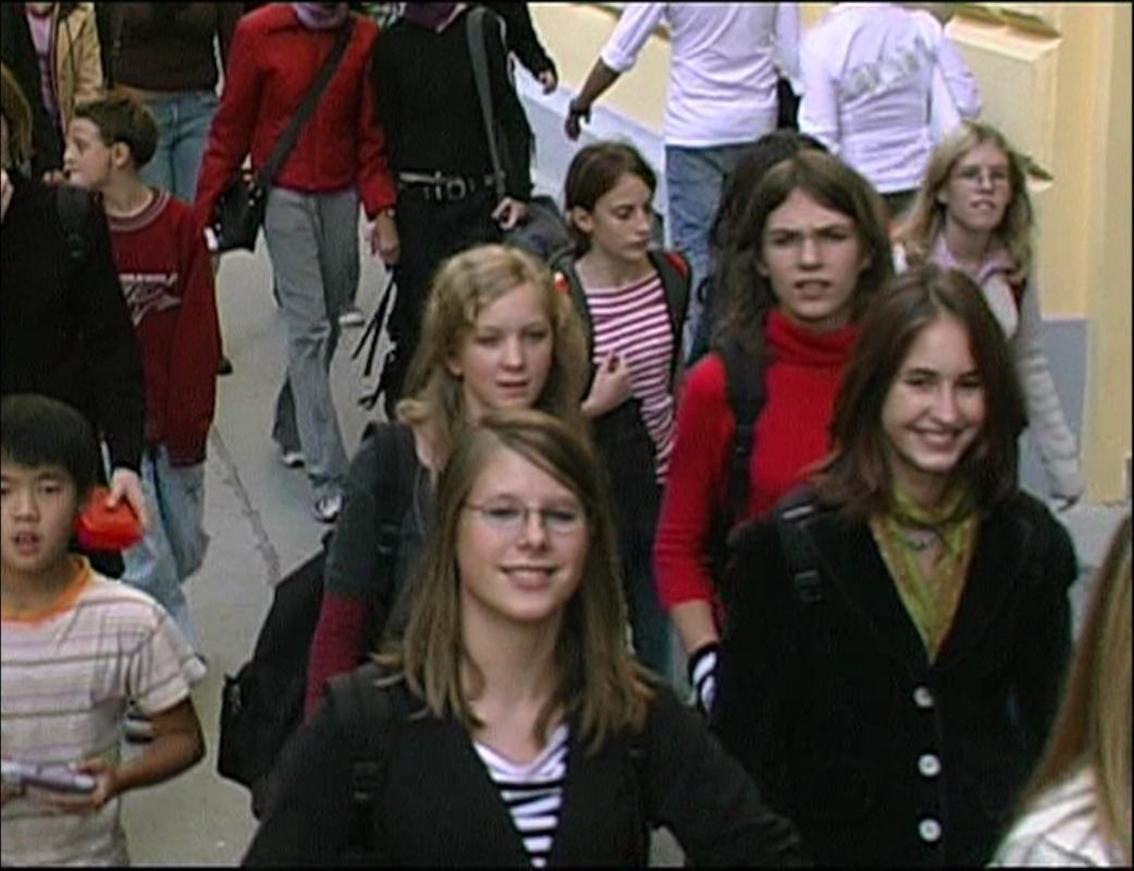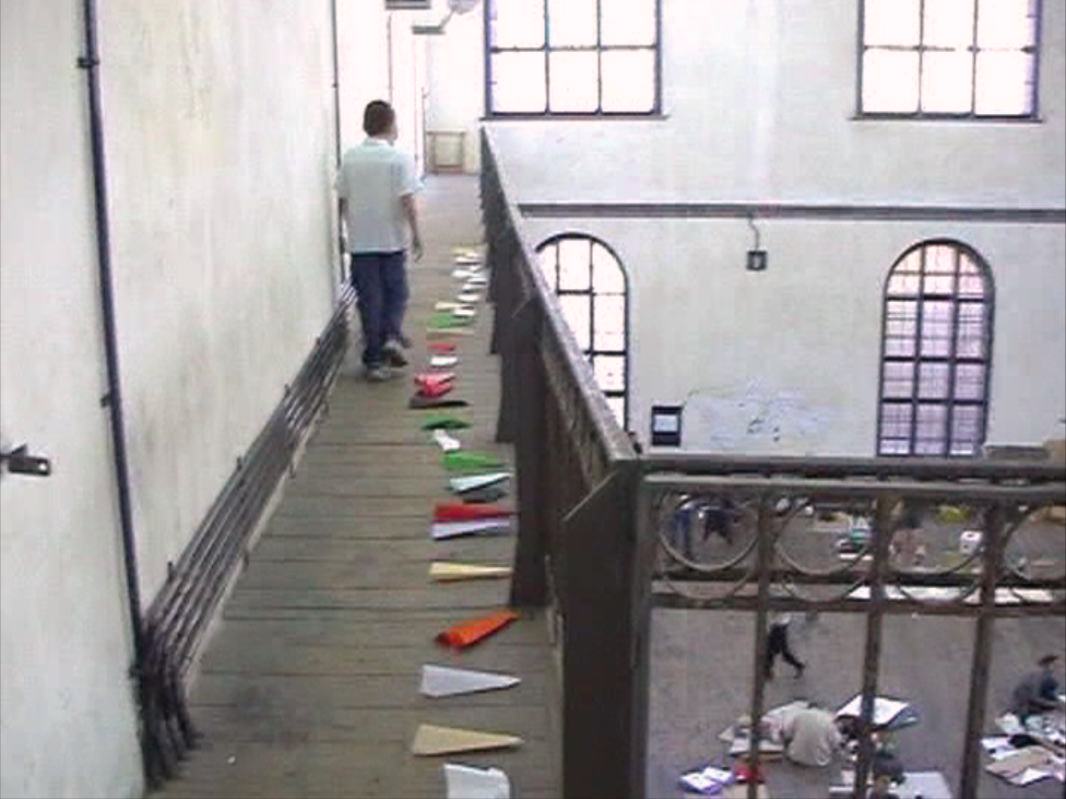Plapper-la-papp
commissioned by 'der blöde dritte Mittwoch' for Phonomuseum Wien, oct 2025
'talking machine', generative system, pd, raspberry-pi, transducers, loudspeaker, Hexentrichter
Plapper-la-papp is an onomatopoetic homage to the phonograph, the first machines for recording voices and sounds. The phonographs from the collection of the Phonomuseum Vienna were taken up as a starting point to explore the processes of recording and playing back and reproducing vocal fragments. The work examines how signals are manipulated in the space of digital sound processing and become perceptible events again in real acoustic space.
Plapper-la-papp is an attention-grabbing machine that processes and generates vocal fragments, or 'essential' sound information, and occasionally develops an entertaining life of its own. In the middle of the phonograph collection, he does not primarily want to appear as a troublemaker, but rather, similar to the first models, tries to reproduce language fragments and essential information in order to interact with the visitors.
Further background details and fun facts:
'Plappern' (babbling) are the first sounds that small children make during language acquisition in the so-called 'Plapper' phase. In German, 'Plappern' means to speak without any particular depth, often quickly and without thinking, or to babble like a child. It can have both positive and negative connotations, depending on whether it expresses joy in talking or empty talk.
The generation of motor patterns is reinforced and supported by imitation and positive feedback. The little ones try out a variety of different sounds and sound combinations and in this way test the possibilities of their articulation organs. (from https://de.wikipedia.org/wiki/Kanonisches_Lallen)
In some cases, 'Plappern' is used pejoratively to describe someone who talks stupid things or doesn't express themselves clearly.
'Papperlapapp' is an interjection used as a dismissive exclamation to reject stupid or nonsensical chatter.
'Papperlapapp' first appeared in the Duden in 1880 and therefore seems to fall into the same period as the invention of the first phonograph in 1877. However, the only connection between the phonograph and babbling activity seems to be the first attempts to reproduce speech sounds.
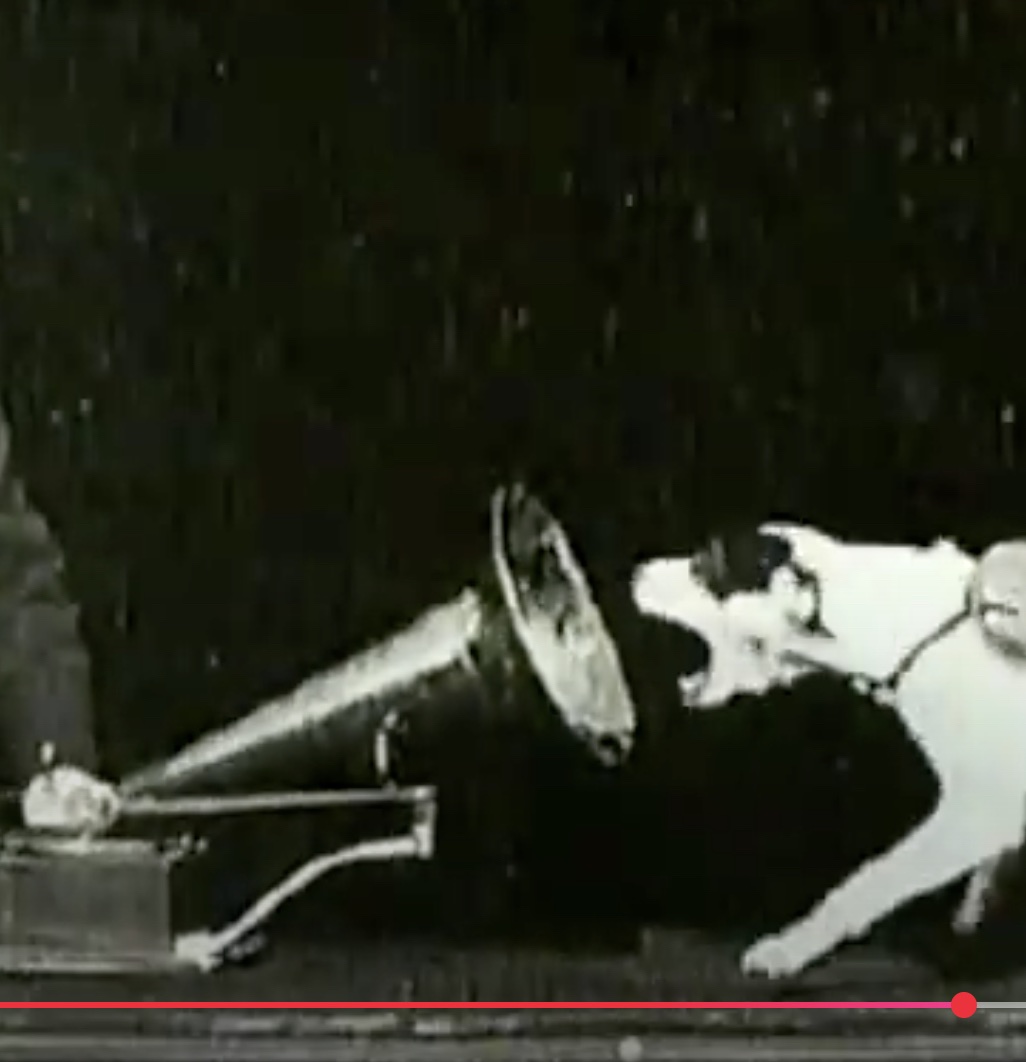
still image from the EMI Trust Archive 'Nipper runs Amok!' for a Mutoscope documentation for The Gramophone Company
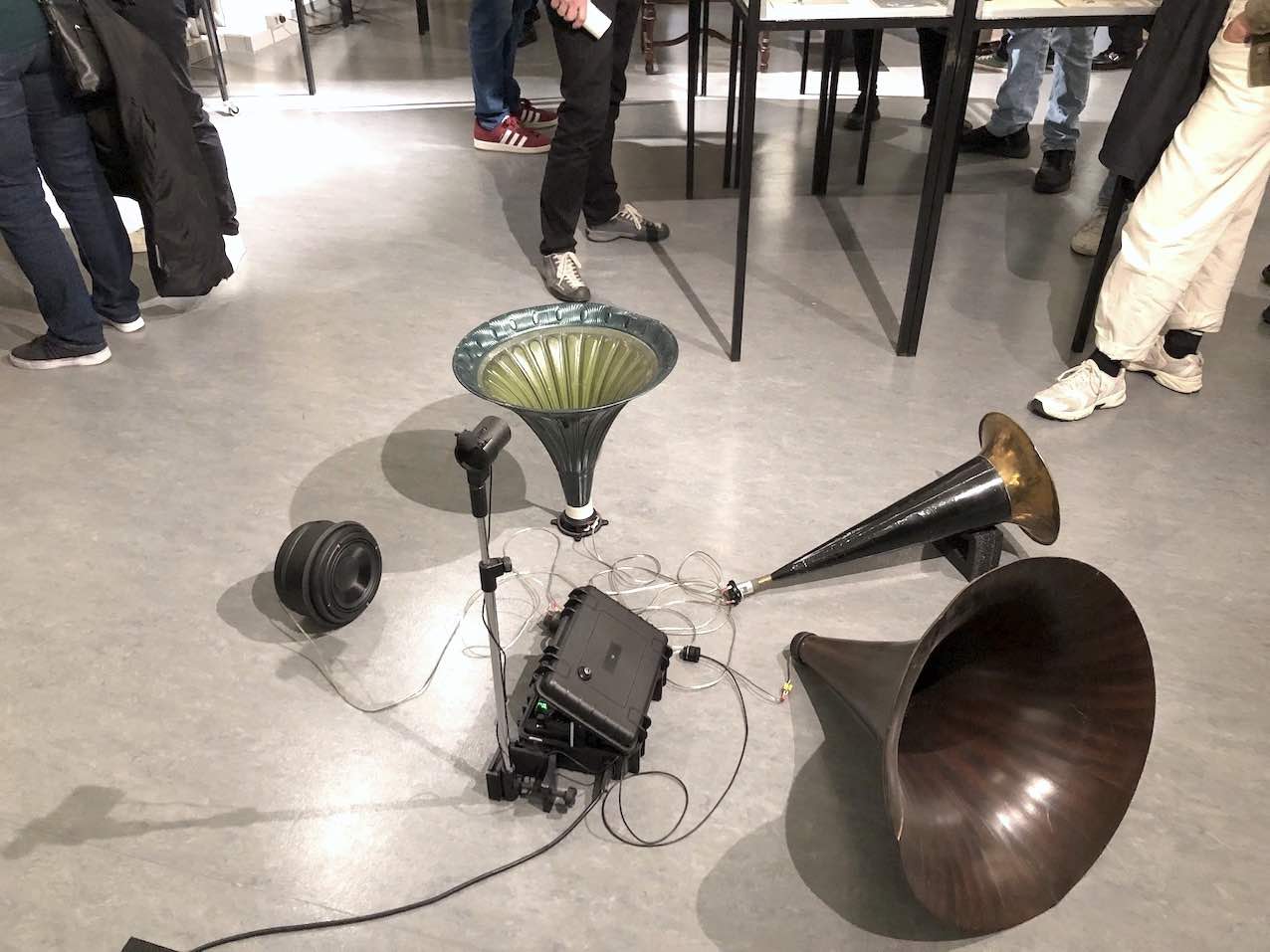
extensión
site specific action + adaption for gallery display
mercado de frutas / 16.1.2025 7pm esquina Chacabuco/Ecuador, Valparaiso, Chile
Galería Municipal Valparaiso
solar sphere, hdpe-foil, carbon-oxide black, tape, fan, piezo contact mic, small speaker setup
developed for Tsonami Festival Atmosférica 2025
thanks for the support to Carsten Stabenow, Franciso Fuenzalida, Sebastián Ramón Tapia Núñez, Nicolás Spencer, Leonello Zambon, Pablo Saavedra Arevalo + Tsonami Team - video excerpts by Florencia Curci, Francisco Hevia - Erizo Cine
'extensión' was developed for the edition Atmosférica of Tsonami Festival 2025, Valparaiso, Chile. It connects to the theme of atmosféria as a layer that surrounds a location or a social sphere and follows the tactic of dérive, a situationist concept involving aimless wandering through urban environments to create a psychogeographic map of different areas.
The intervention was composed of two segments: an outdoor event at the Valparaiso fruit market and an installation at the municipal gallery. The solar balloon, made from lightweight hdpe material and colored with carbon-oxide black, absorbs sunlight, enabling it to rise without any additional energy source. It responds to its environment, acting as a moving sphere affected by external forces like wind and sun, as well as its internal expansion when exposed to sunlight.
In addition to the auditory focus on interventions with lightweight audio diffusion systems, 'extensión' also wants to involve the question of the presence of spaces and explore the different qualities of subliminal immersion or exposure to unfamiliar elements.
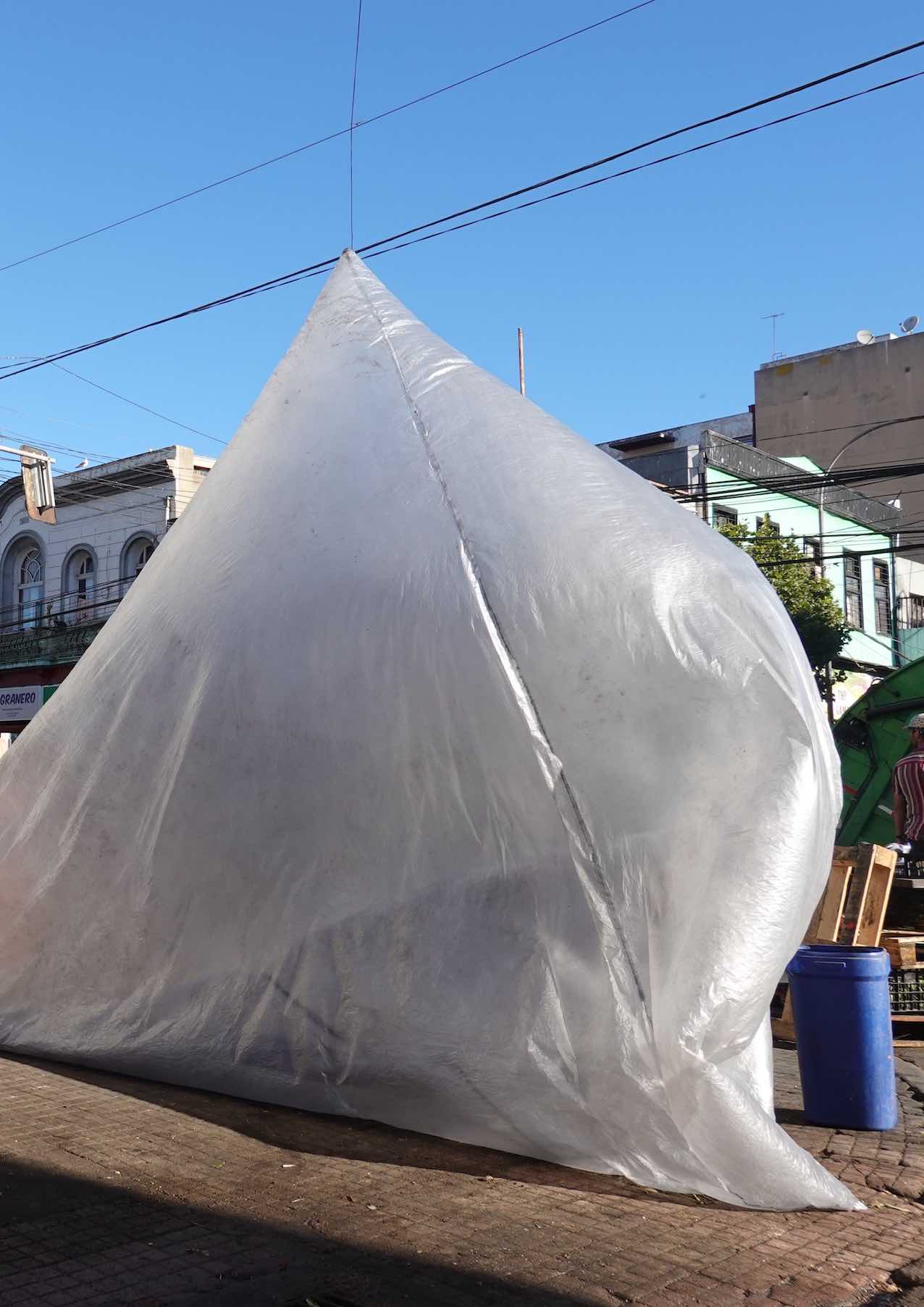
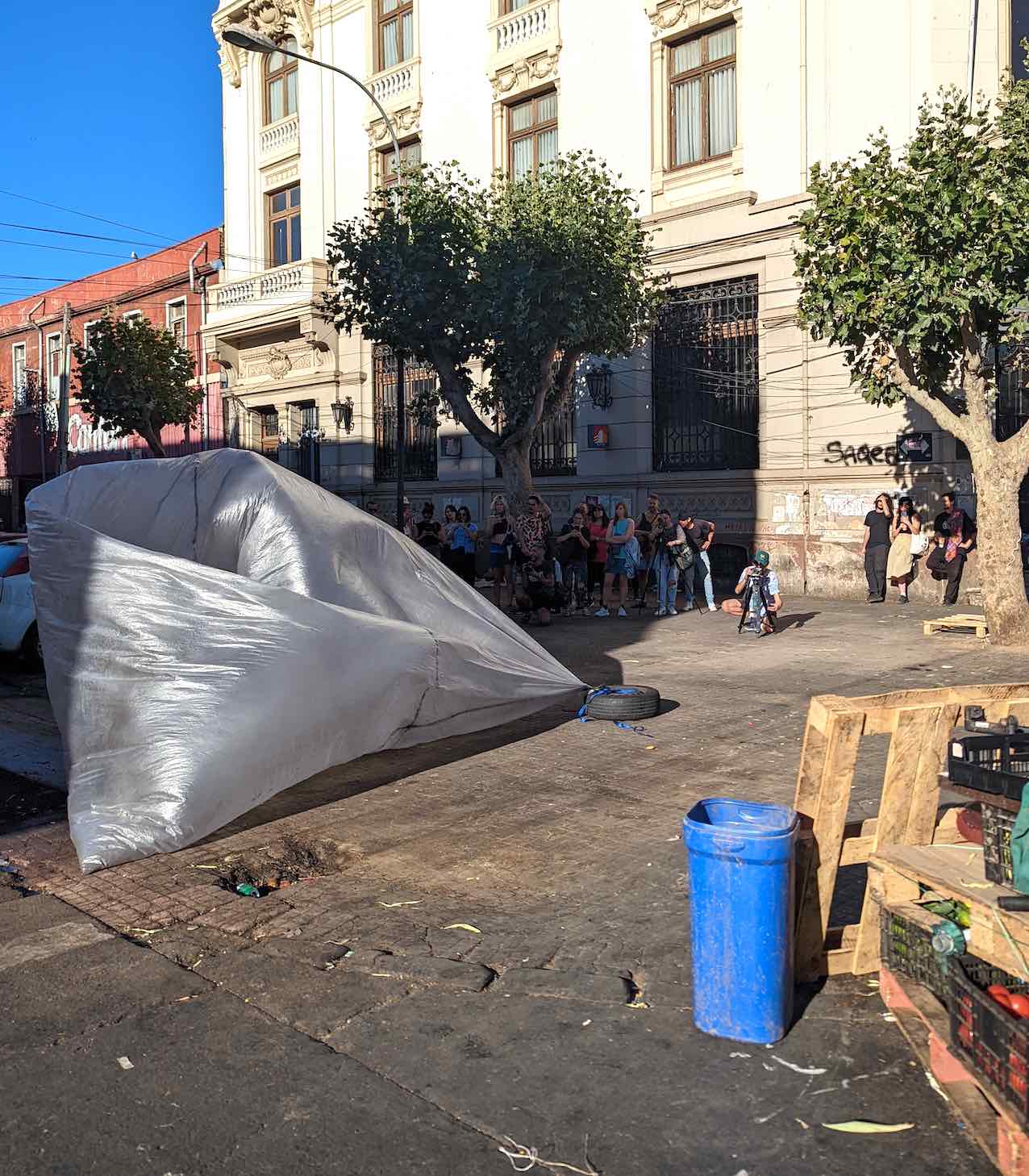
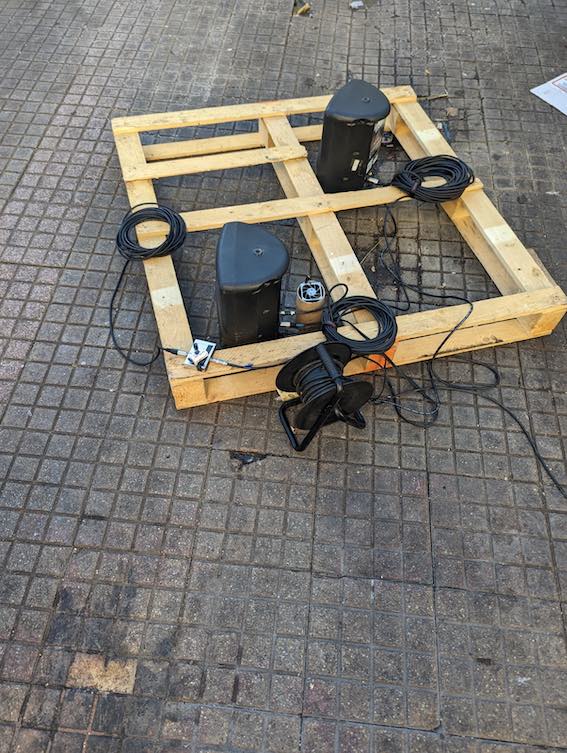
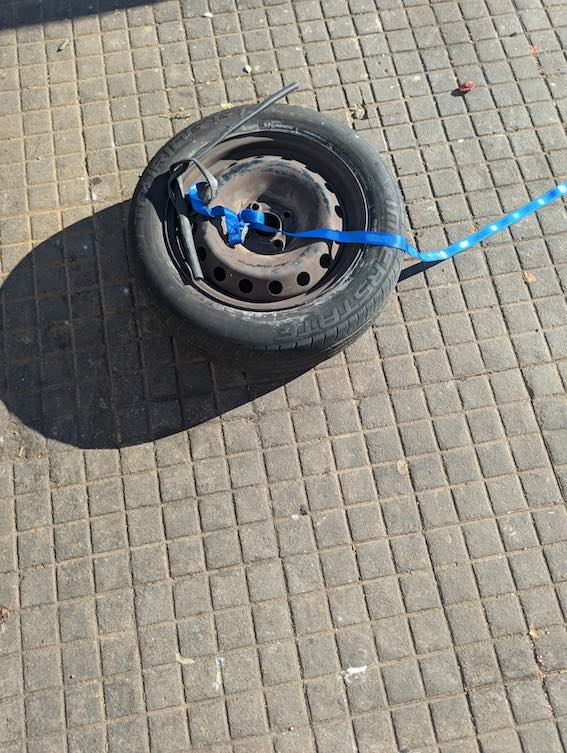
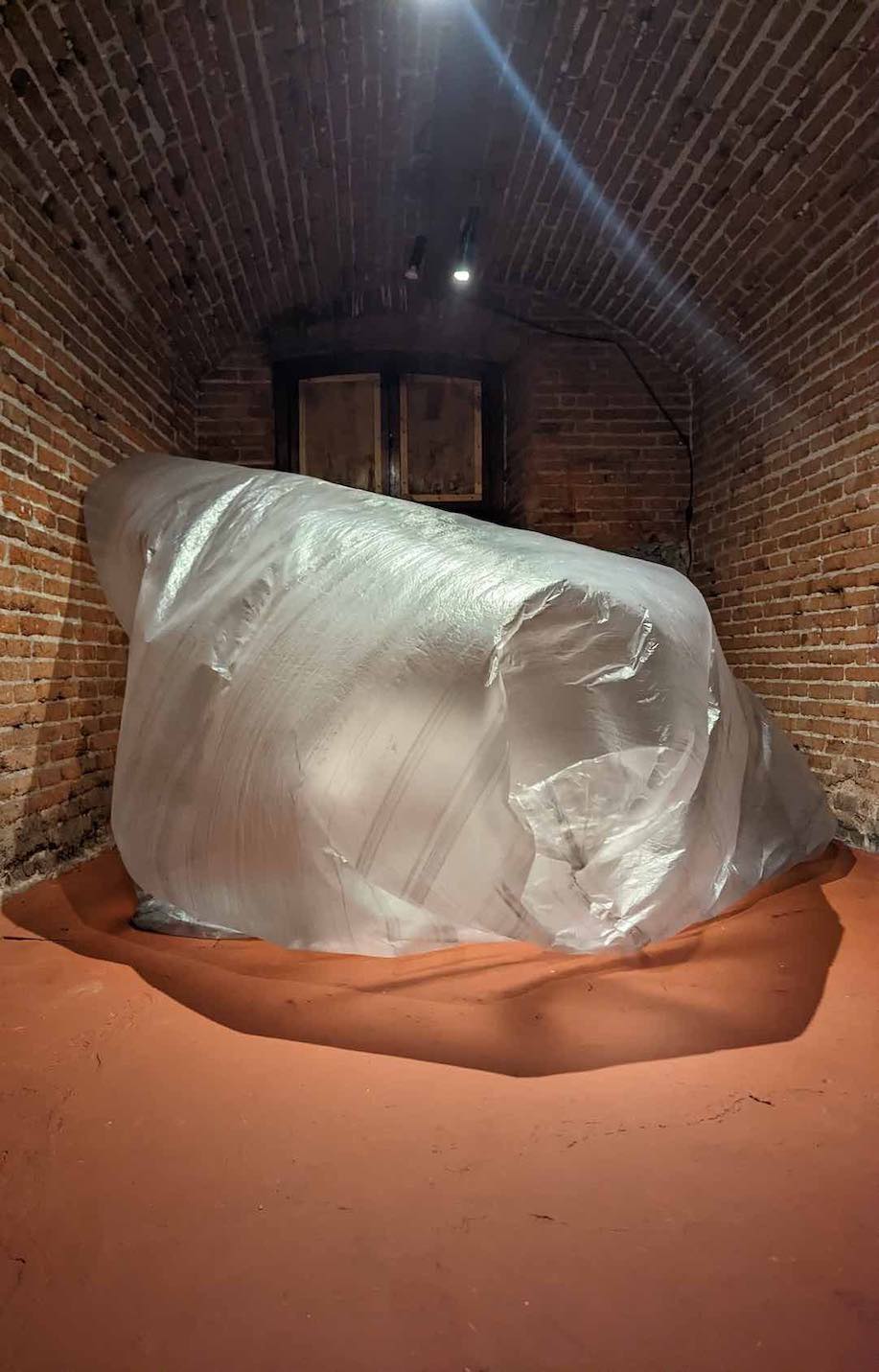
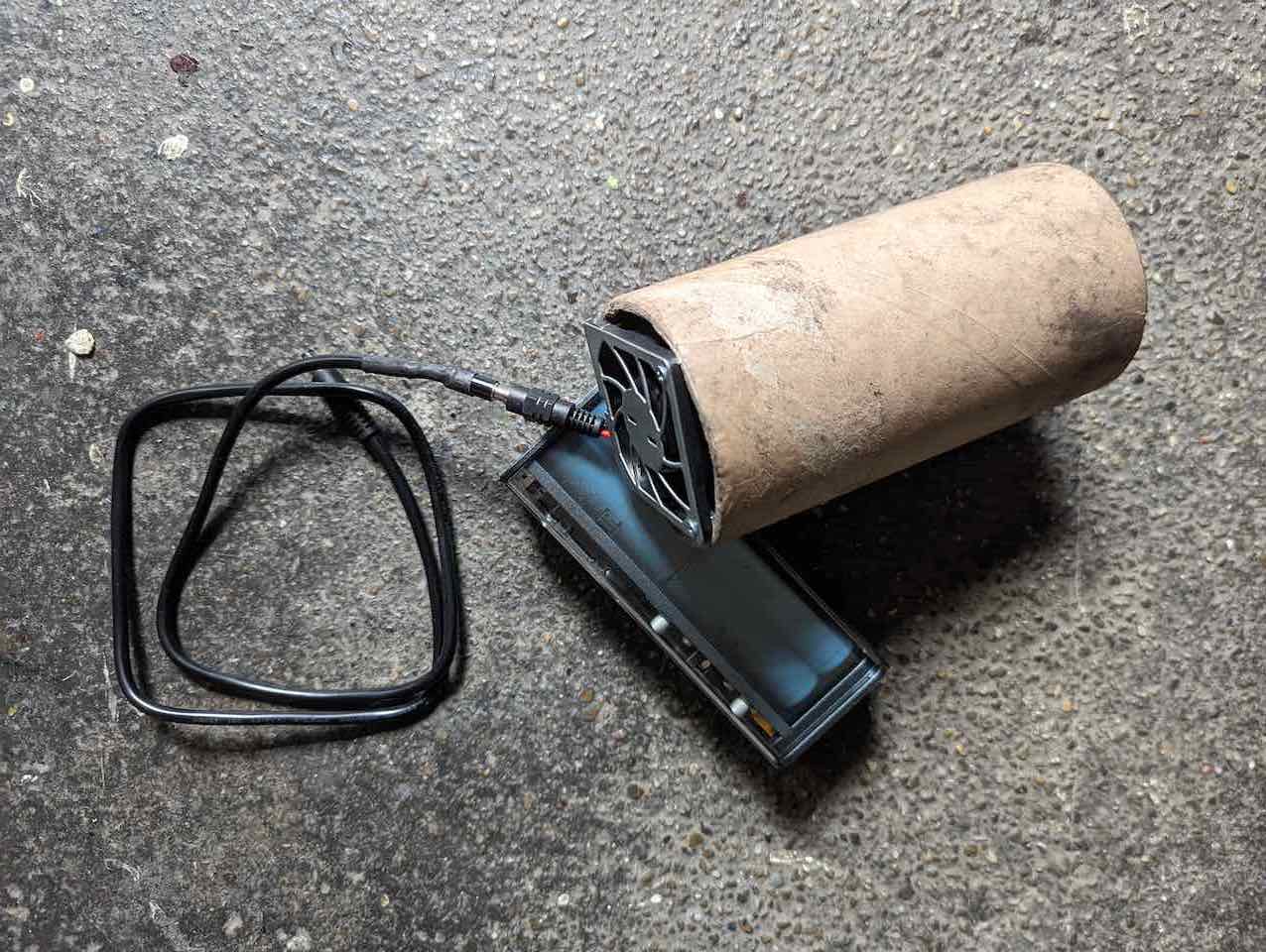
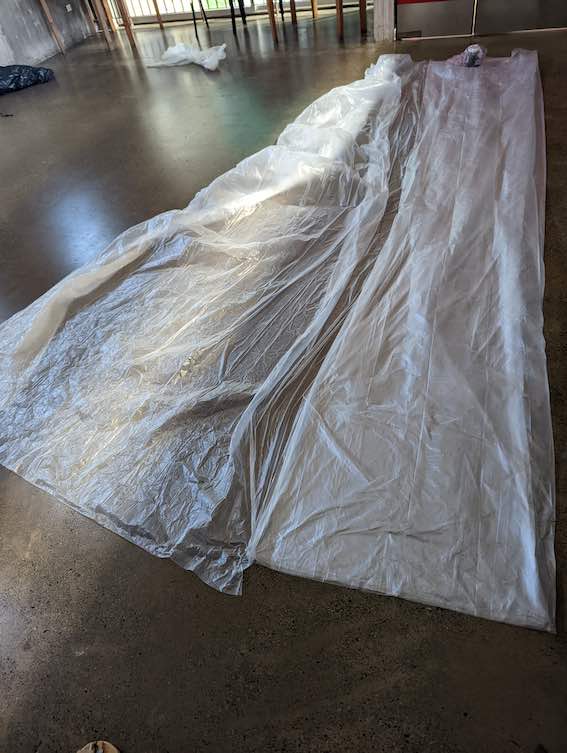
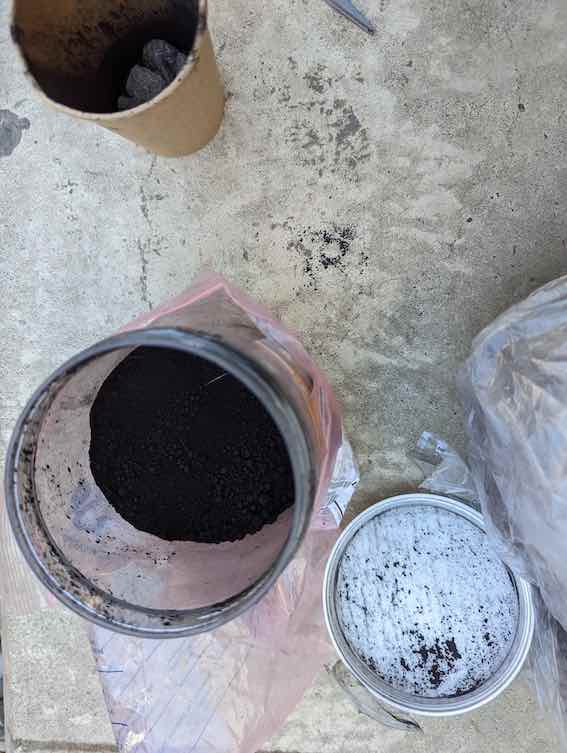
whisper
soundsystem, 2024
cone speakers, pressure chamber speakers, tripods
a multitimbral diffusion system for amplifying resonance and to enhance not locatable soundsources ~
whisper, excerpt from live-set at Q-O2, Brussels[BE], jun 19 2024:
whisper, intervention at Tsonami Festival, Valparaiso[CL], jan 15 2025:
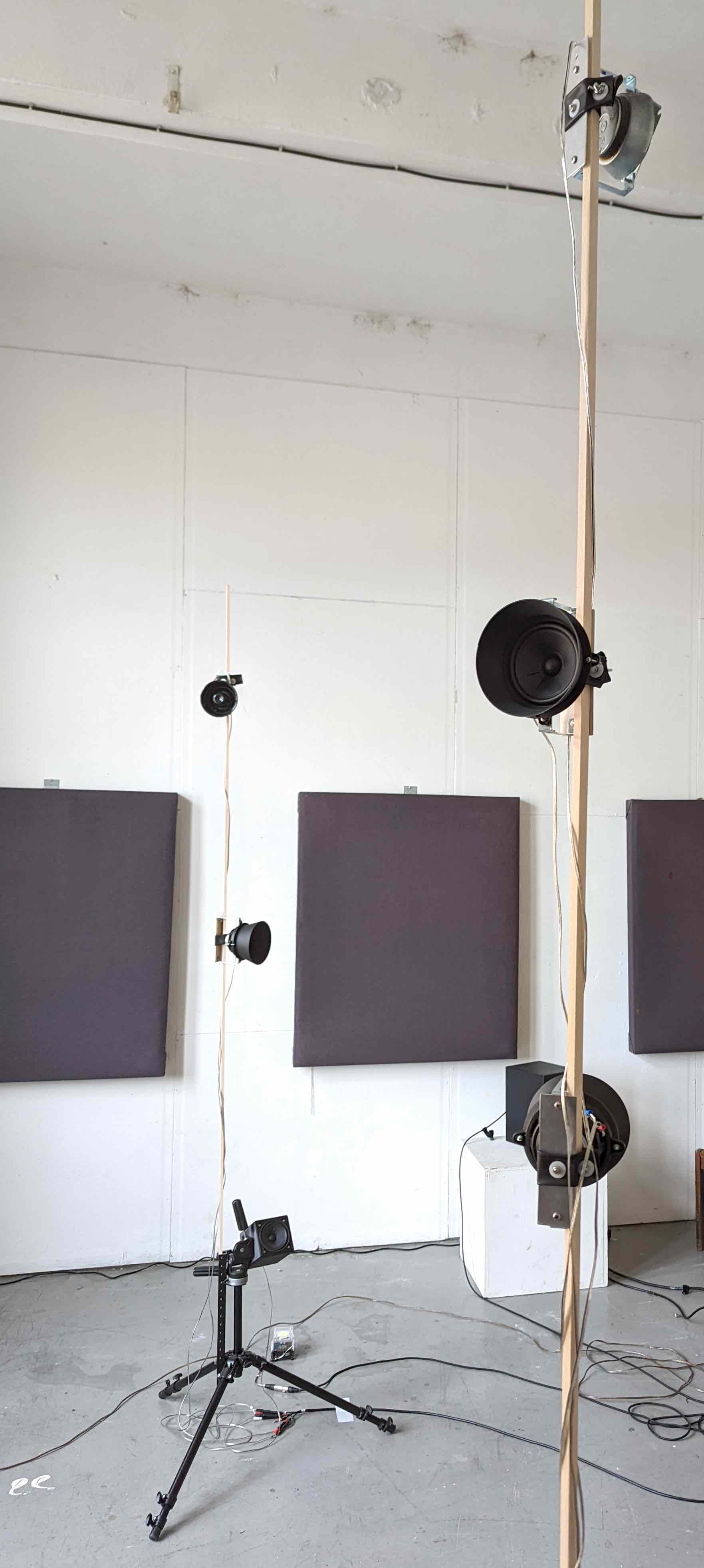
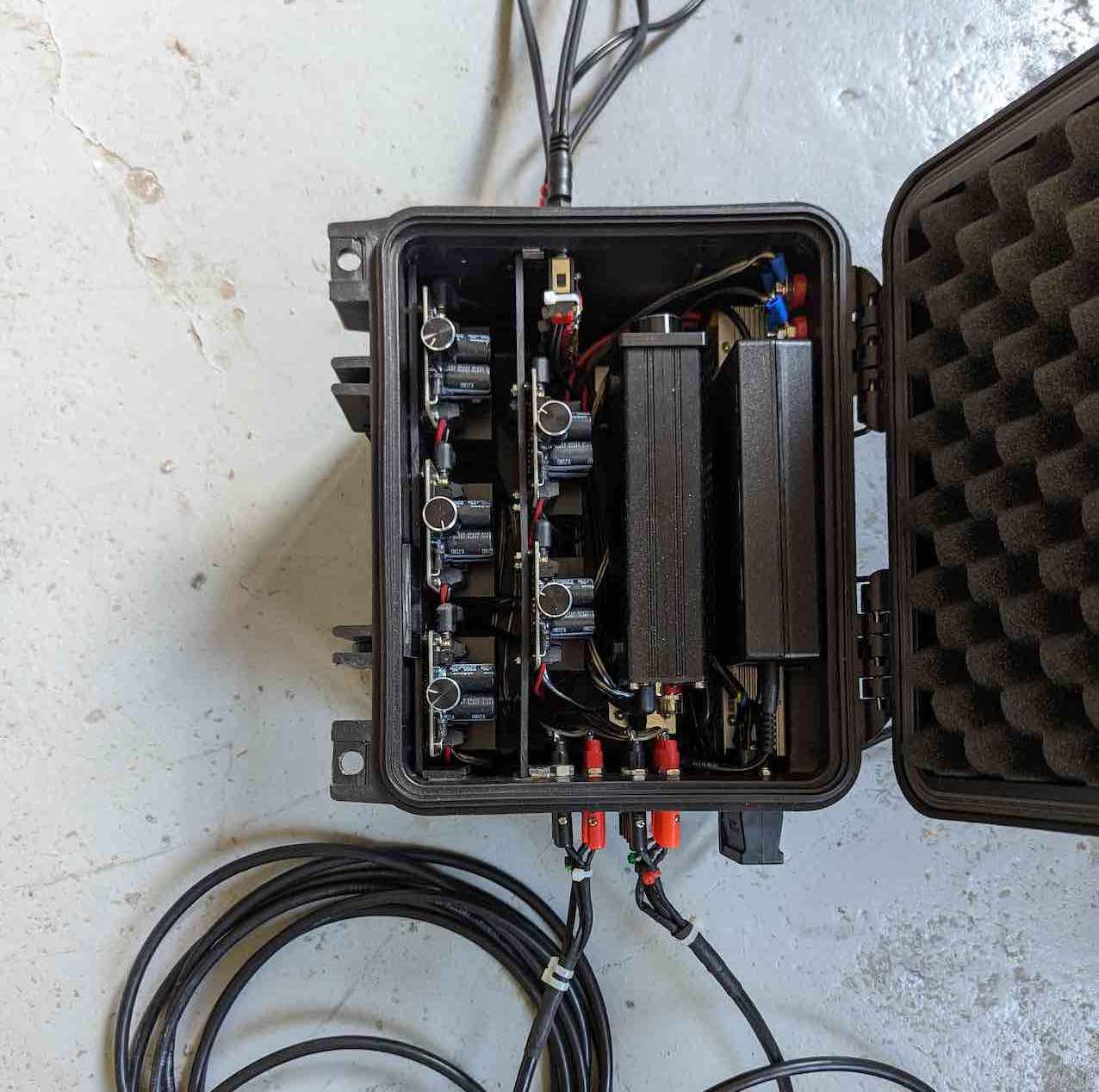
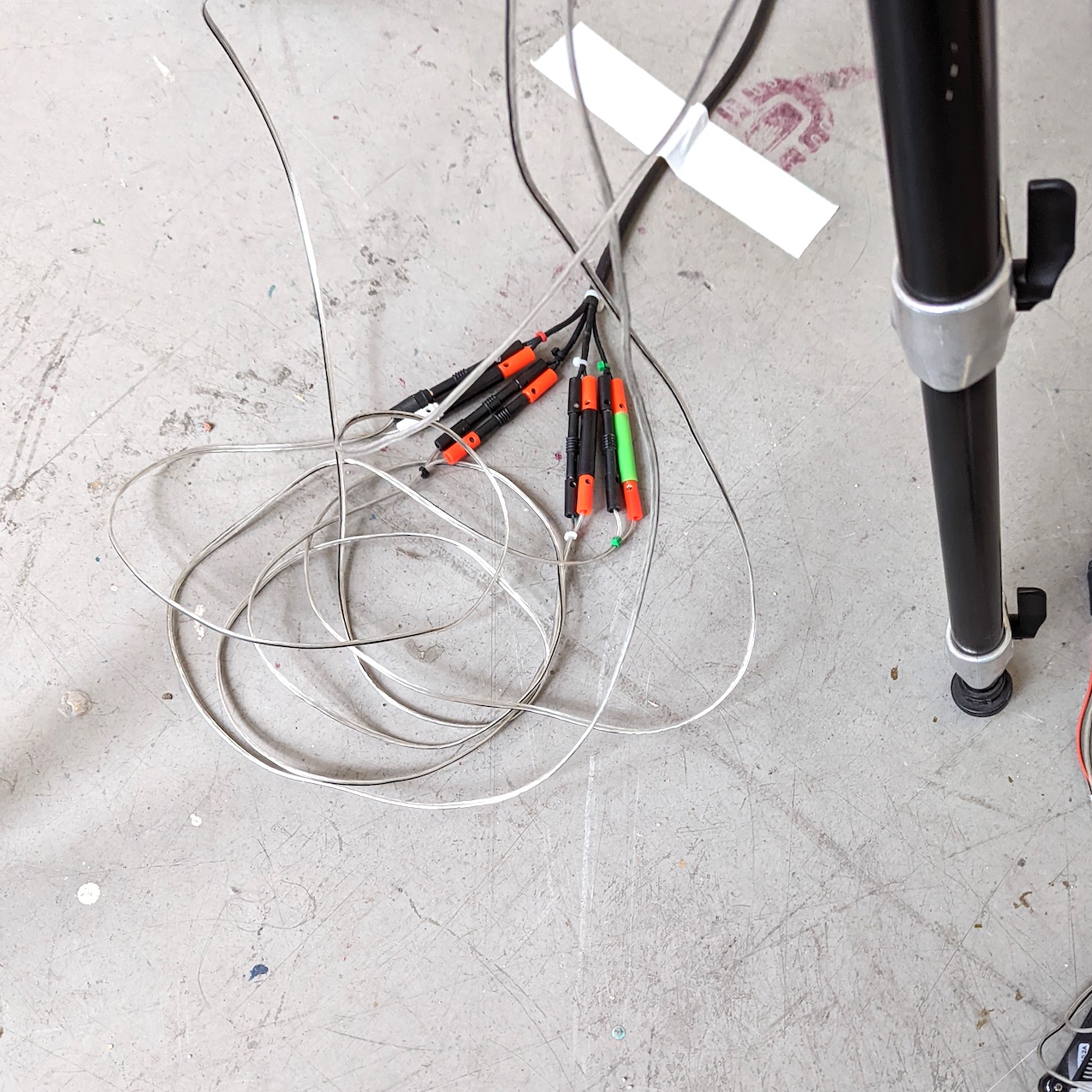
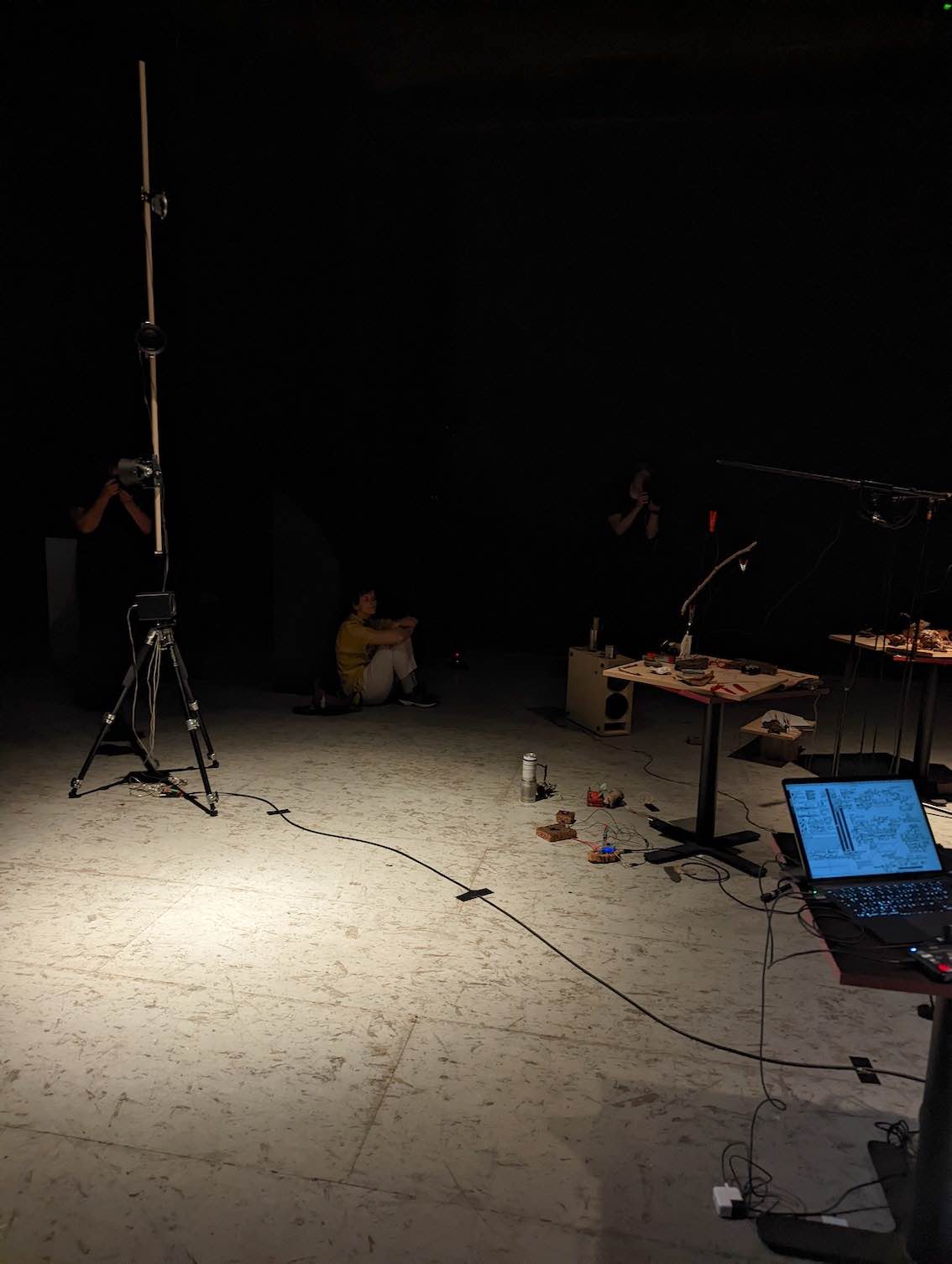
The Sea
generative audio installation, 2021/24
2,5m cube, latex foil, motors
PD-0.50-2
with Leo Peschta
The sea is an auditive and visual sculpture, configured as an open, never repeating process of audio waves.
An elastic latex foil is stretched between 4 linear axes driven by stepper motors dividing the space in 3 dimensions. The shape of the sculpture relates to generative processes connected to a DSP-audio platform and the scheduler for the motor movement on the 4 axes of the cube.
The Sea is an extraction of a complex natural phenomenon resulting in an artificial emulation, developing a life-form of its own. Like the ‘real’ sea as an endless repetition of waves, a natural system which results in complex variations over time, it follows the impact of an immersive state, leading to a dystopian vision of an artificial generator. The combination of the stretched foil and the evolvement of the sound result in a highly dynamic, but only seemingly chaotic system, able to generate associations that range from the swell of the ocean to a science-fiction setting. But it should also enable the viewer to perceive the latex foil for what it actually represents - a vibration floating in space.
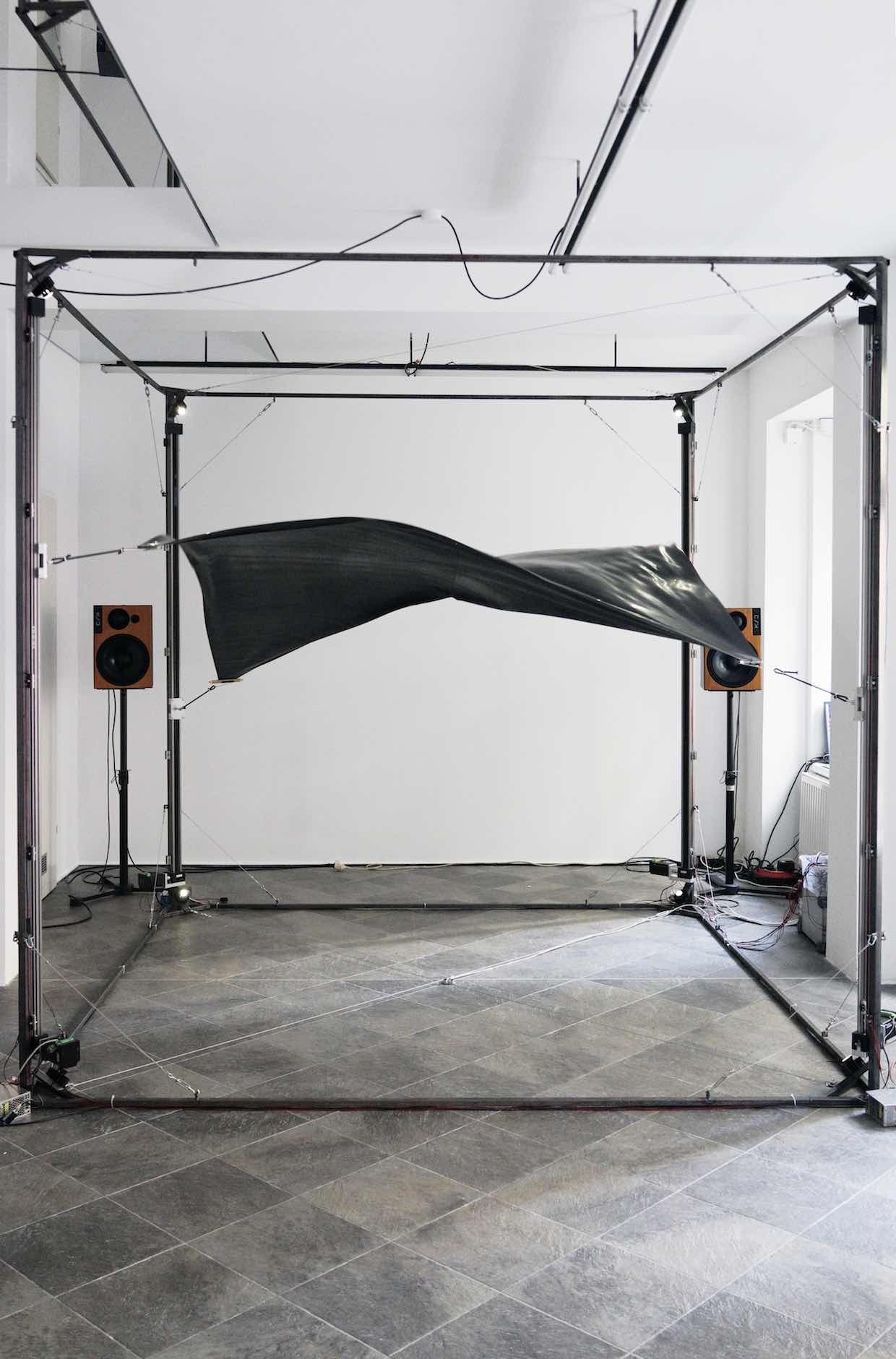
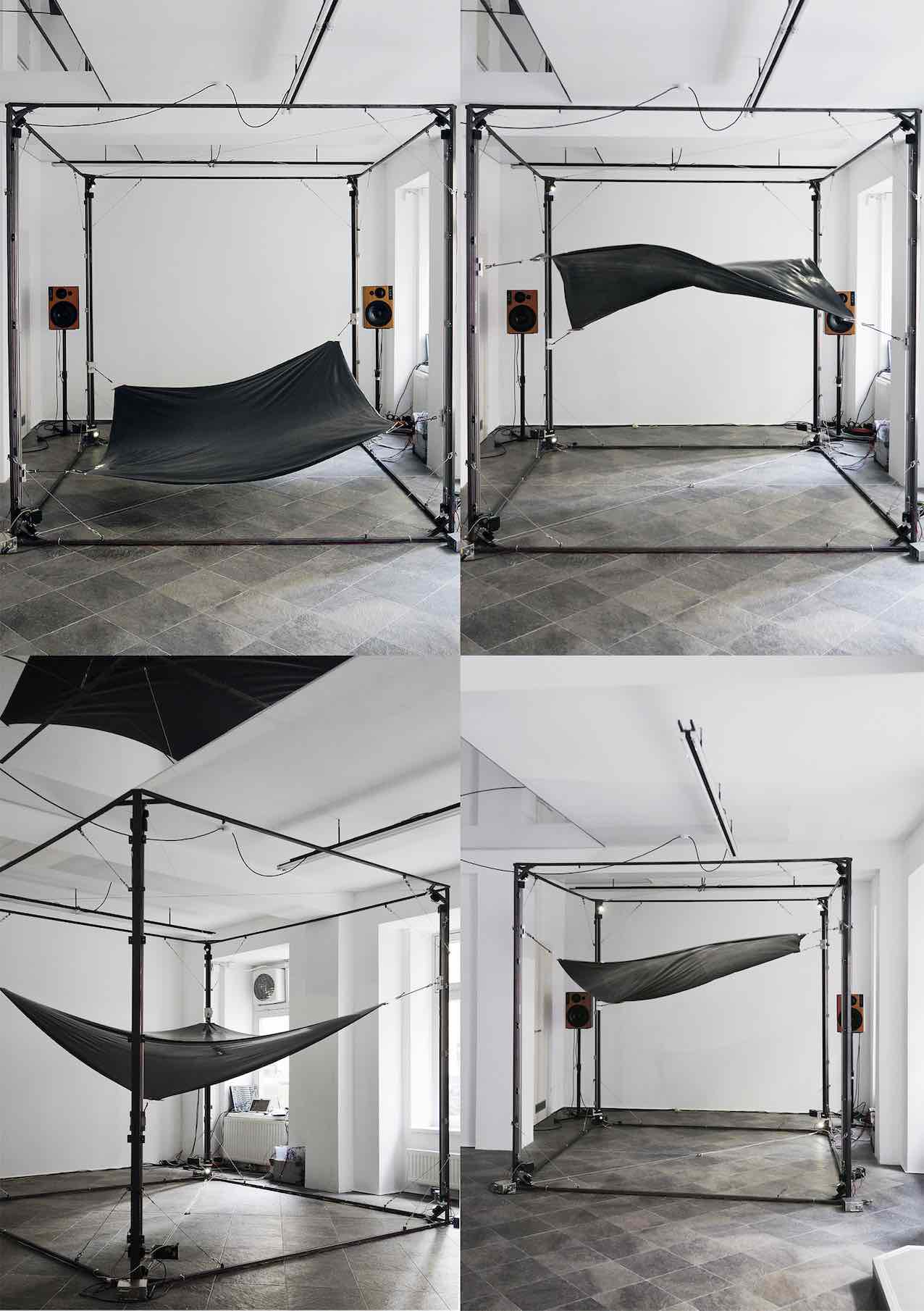
documentation at Kunstverein ve.sch, photos by Martin Vesely
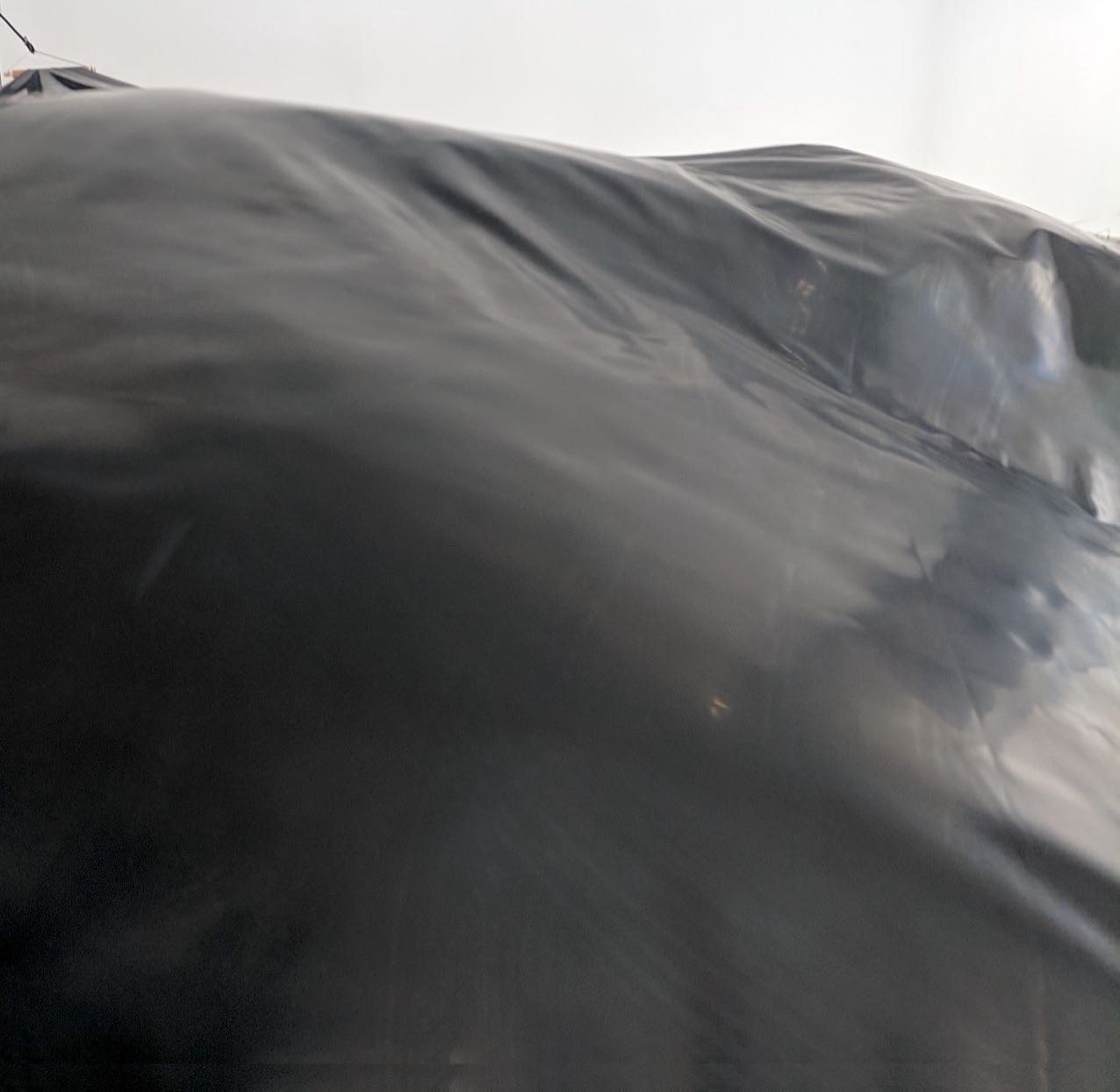
Popp-Up-Maze 256
dimensions variable, construction marking paint 2022
in collaboration with Sophie Dvořák
this intervention was done for
dimensions variable # 2022, a platform for artistic position in urban space and different dimensions...
The arcade game Pac-Man is the starting point of the site-specific intervention Popp-Up-Maze 256. The video game marks the transition from electromechanical to computer-controlled slot machines in 1980, making it one of the first games to move from a real to virtual space. It could mark the start in a simulated world.
The playing area of the game is transferred to the Eduard-Popp-Hof. The warp mode known from Pac-Man, the moment of exiting and simultaneously entering on the other side of the playing field, spreads within the Eduard Popp settlement. In "Pop-Up-Maze 256" the warp, which is placeless and timeless in the game, becomes a walk-in space, an expanded city playing field, in which symbols and protagonists from the arcade game can be found, which are visually oriented to floor markings at construction sites and road works. The intervention is also an offer to follow the signs of the city.
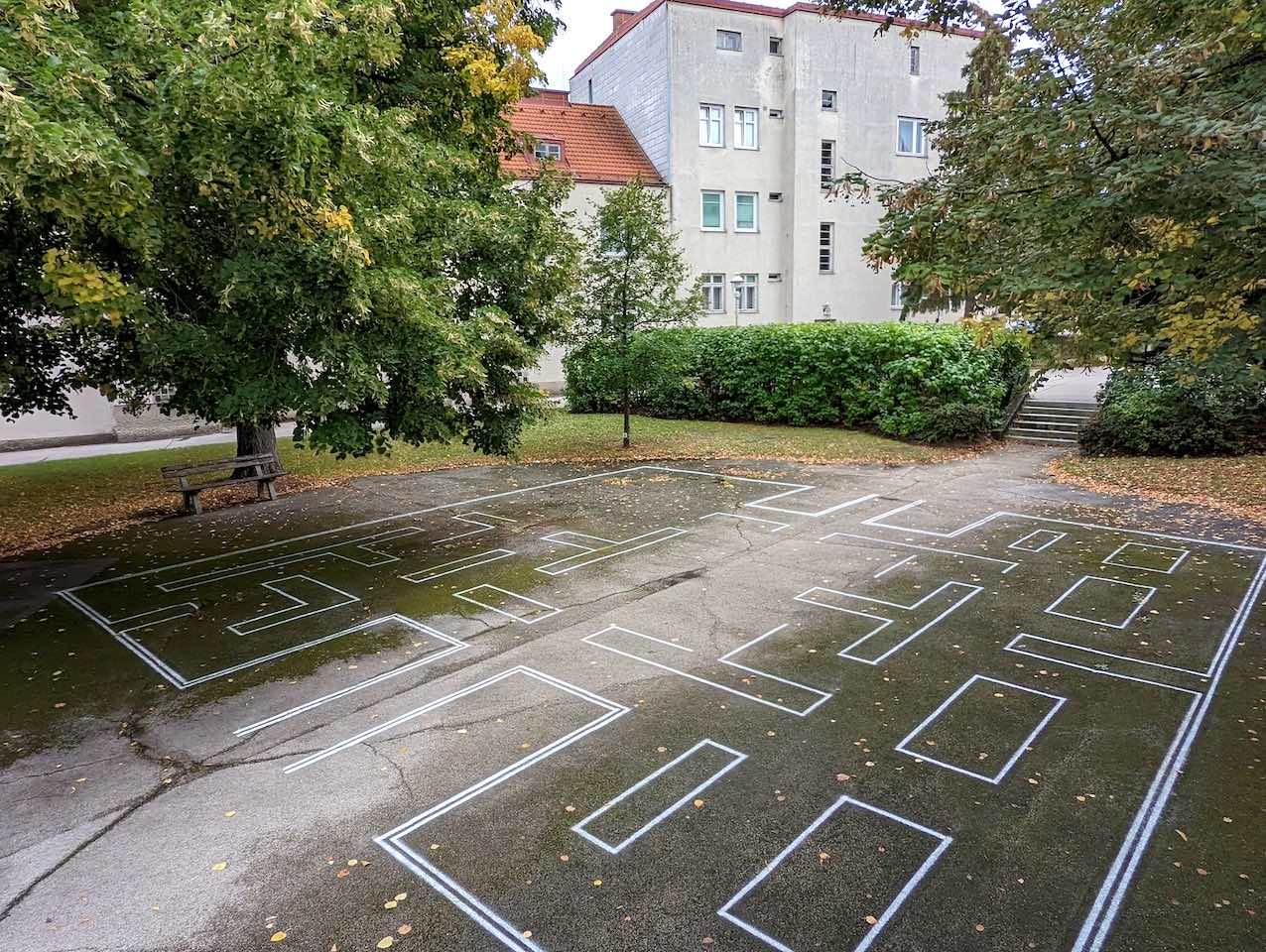
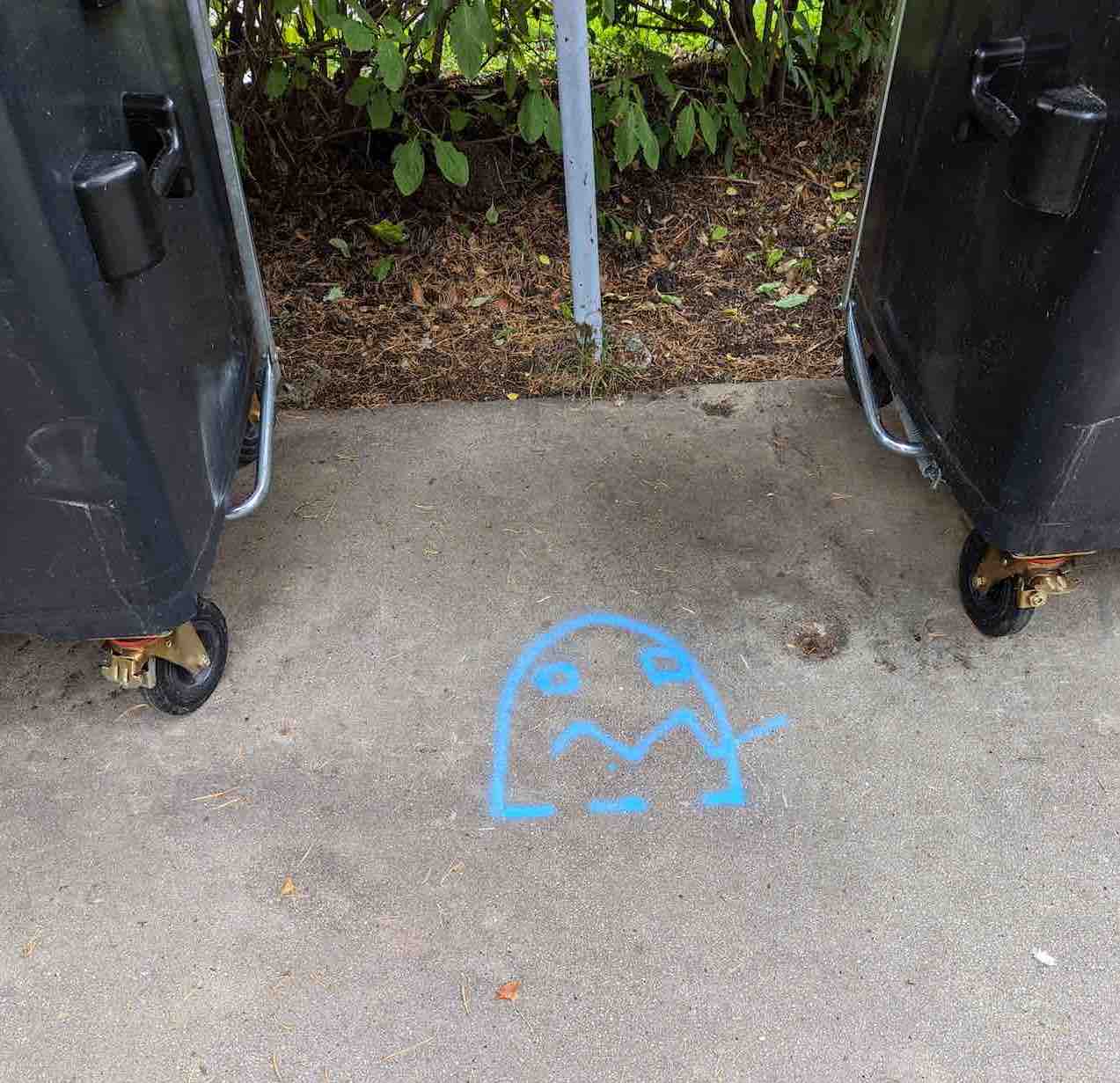

animal-voice-pavilion
generative audio installation 2022
in collaboration with Fabian Lanzmaier
An autonomous system is initiated by means of electromechanical, analogue and digital sound generators positioned in a space. The installation is designed as an independent network organism. Connections of electronic circuits and digital sound processors are treated as entities to create semi-natural, squeaking, stuttering, throbbing and singing organisms. A kind of half-animal. The electronic machine as a mimesis of an organic world, where the voice and the language process are generated through different models of feedback networks.
By working with real-time audio systems and feedback, its resistance and autonomy reflects an open generative state that does not follow a fixed sequence. Therefore the installation finds itself in different auditory stages, where it follows the idea of the machine as a natural, unpredictable entity outside a preconfigured and determined process. A continuous ecosystem started and left to its own. Examining sound as a processual medium, pursuing the question of sound as an independent presence in space.
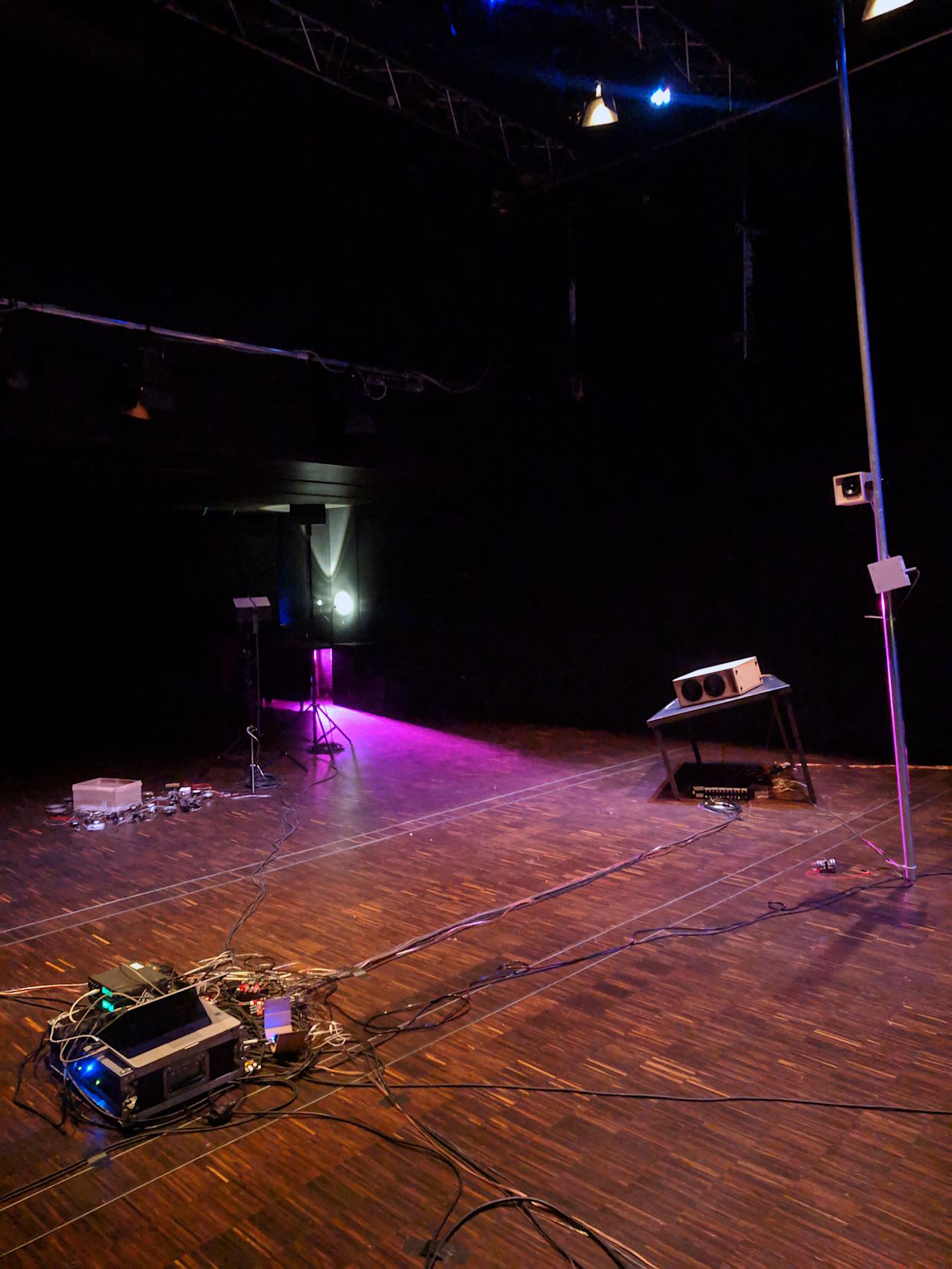
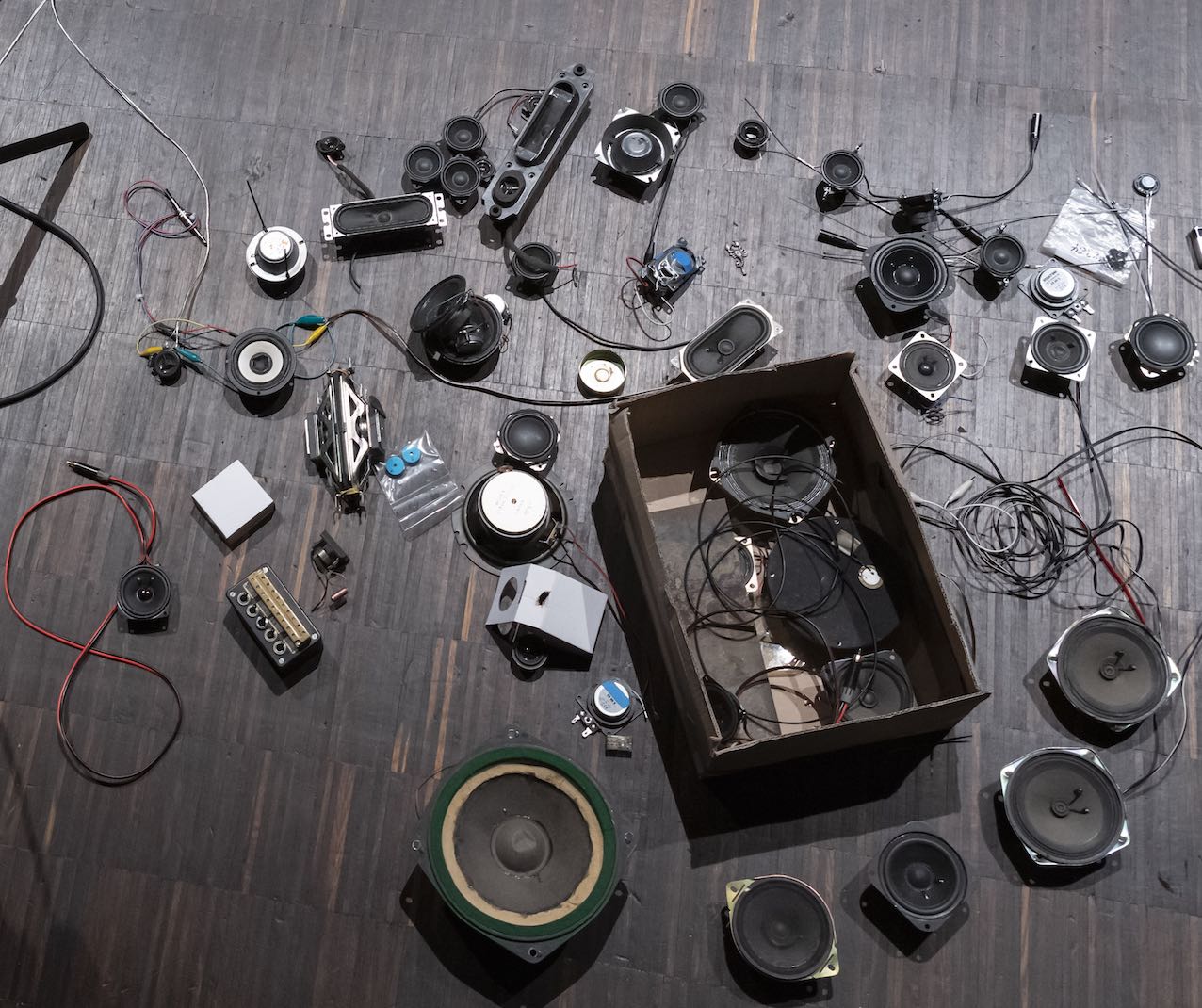
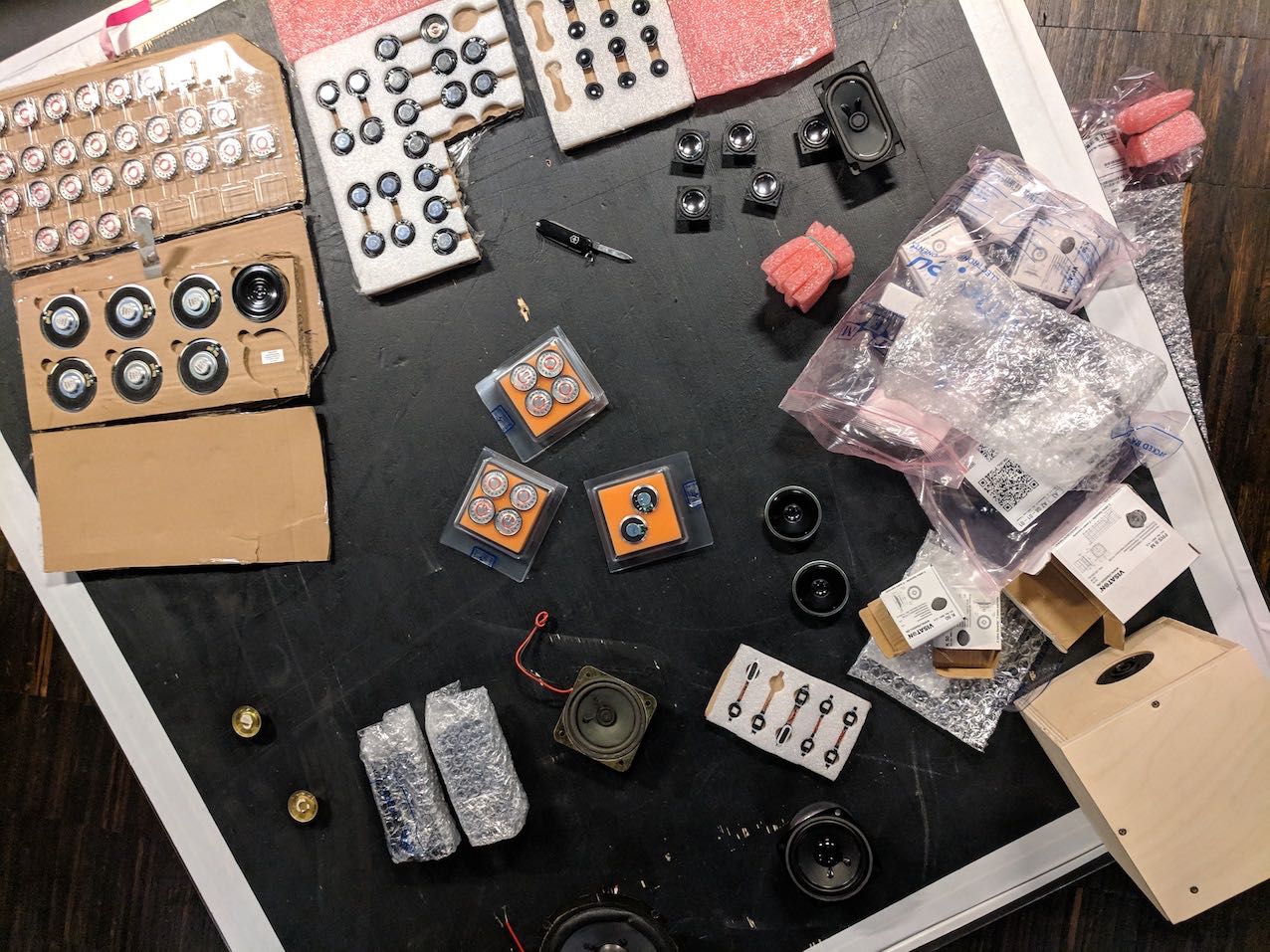
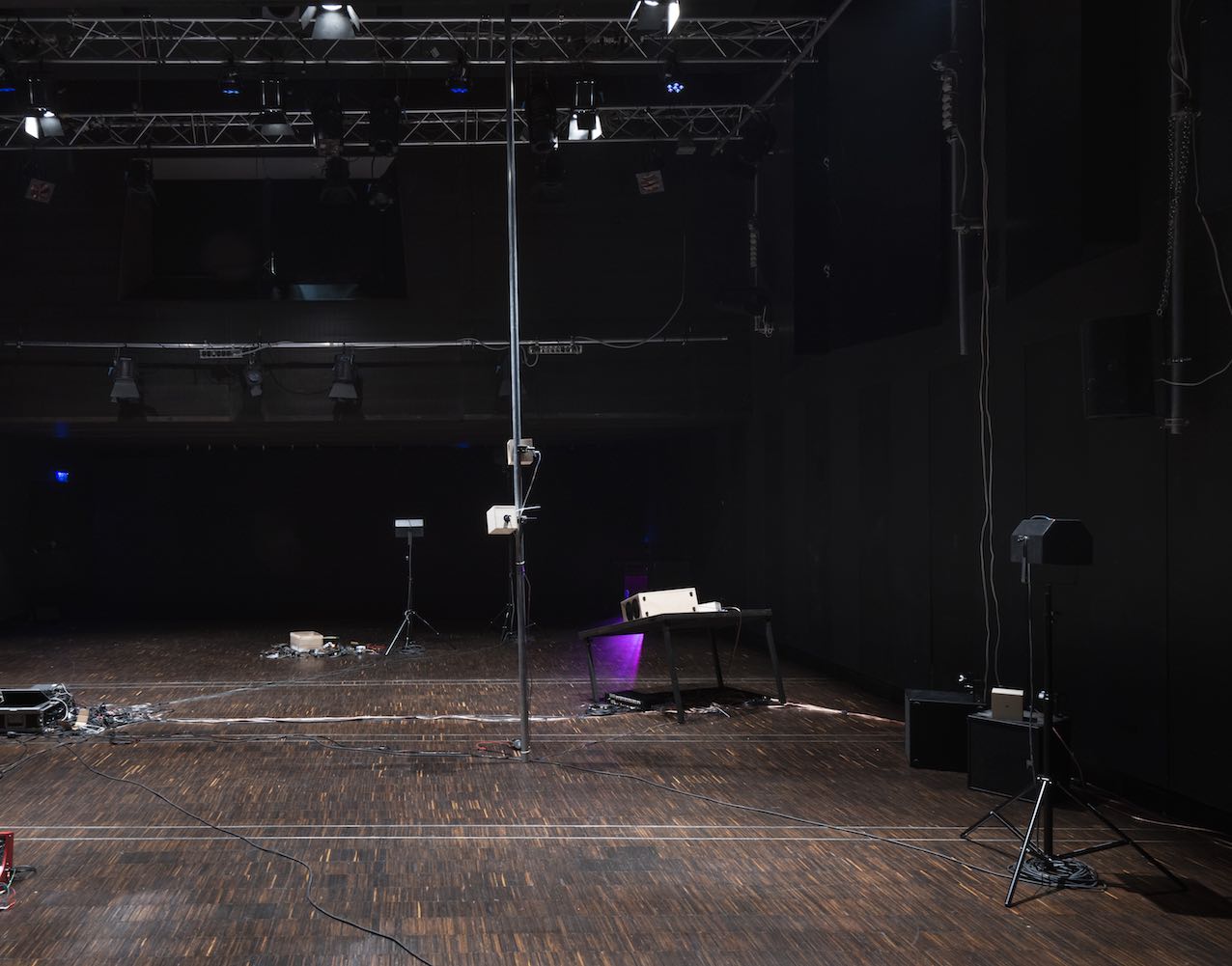
Acoustic Shadows
autonomous complex adaptive system, 2020/21
4 cardoid microphone, 4 horn speakers PA Comp 34S, 4 channel class D preamp 100W
PD-0.50-2
2 modular structures, tripods
dimensions variable
in cooperation with
Dario Sanfilippo
Acoustic Shadows is an implementation of a complex adaptive system in an eco-systemic configuration. Through the implementation of a feedback system in the high-frequency domain, signals that oscillate at the threshold of the human perception are ‘scanning’ the area. Shadows or inaudible signals, which are created by human presence are influencing the state of the system and therefore change its behaviour, perturbing the system’s microphone-loudspeaker connection and self-modulation. The adaptations could be perceived more like a ghostlike appearance then an interactive reaction.
As an adaptive technological life-form, which spreads discretely but invasively, filtering it’s environment, it could be perceived through the presumption of it’s inner process. A circular system, that reacts to external influences, but also develops a life of its own. Almost like an abstract occult machine that meters the space to extend its own state.
This is a stereo recording of the room and line signal with no audience present for documentation purpose (headphones recommended):
just the room recording and with less amplification:
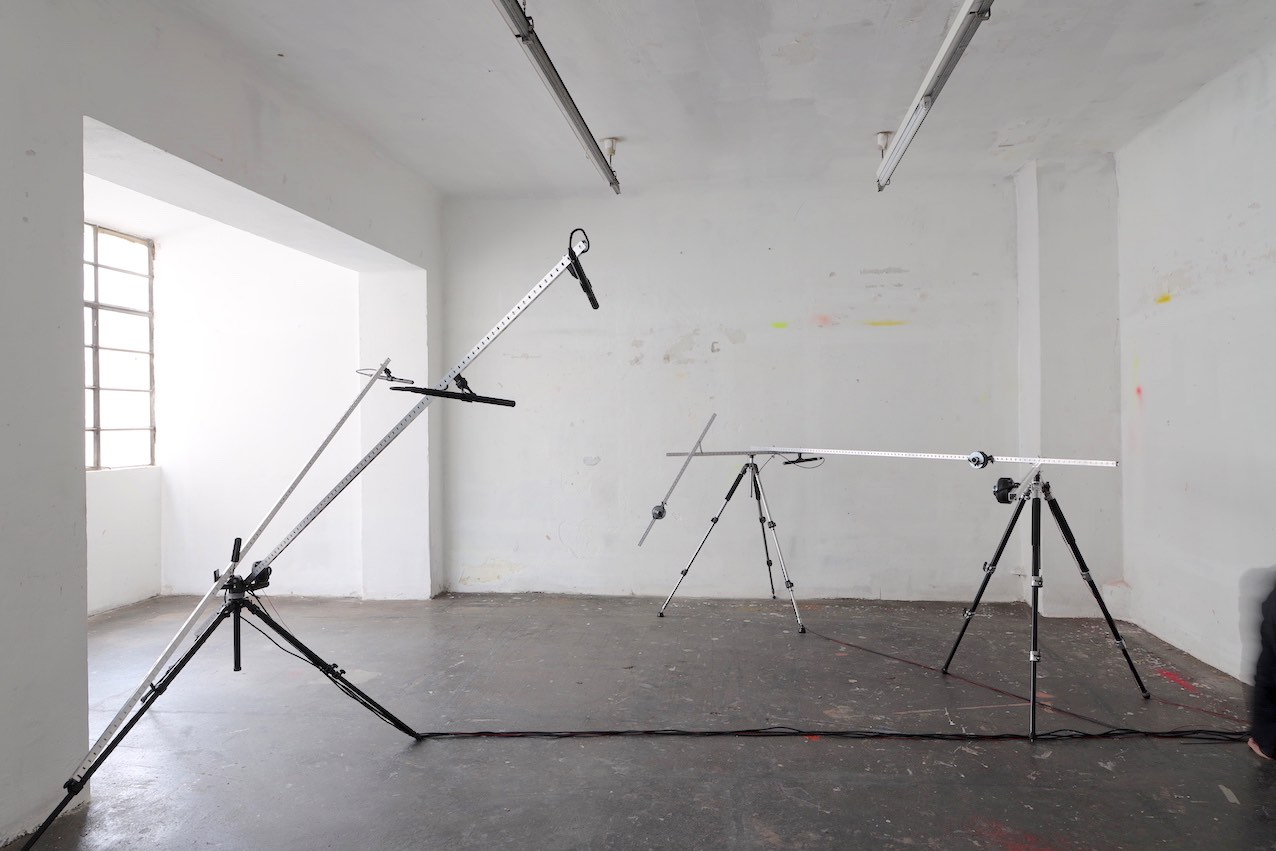
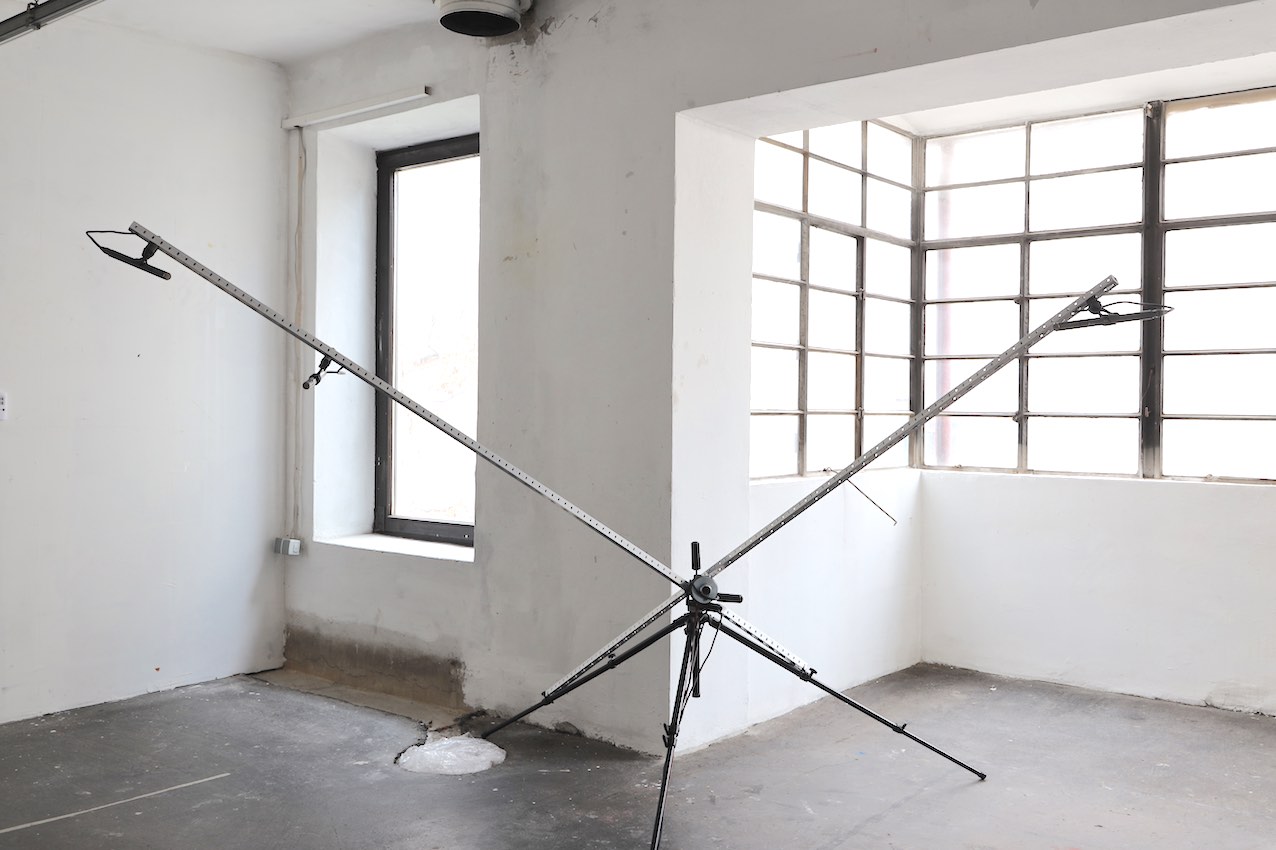
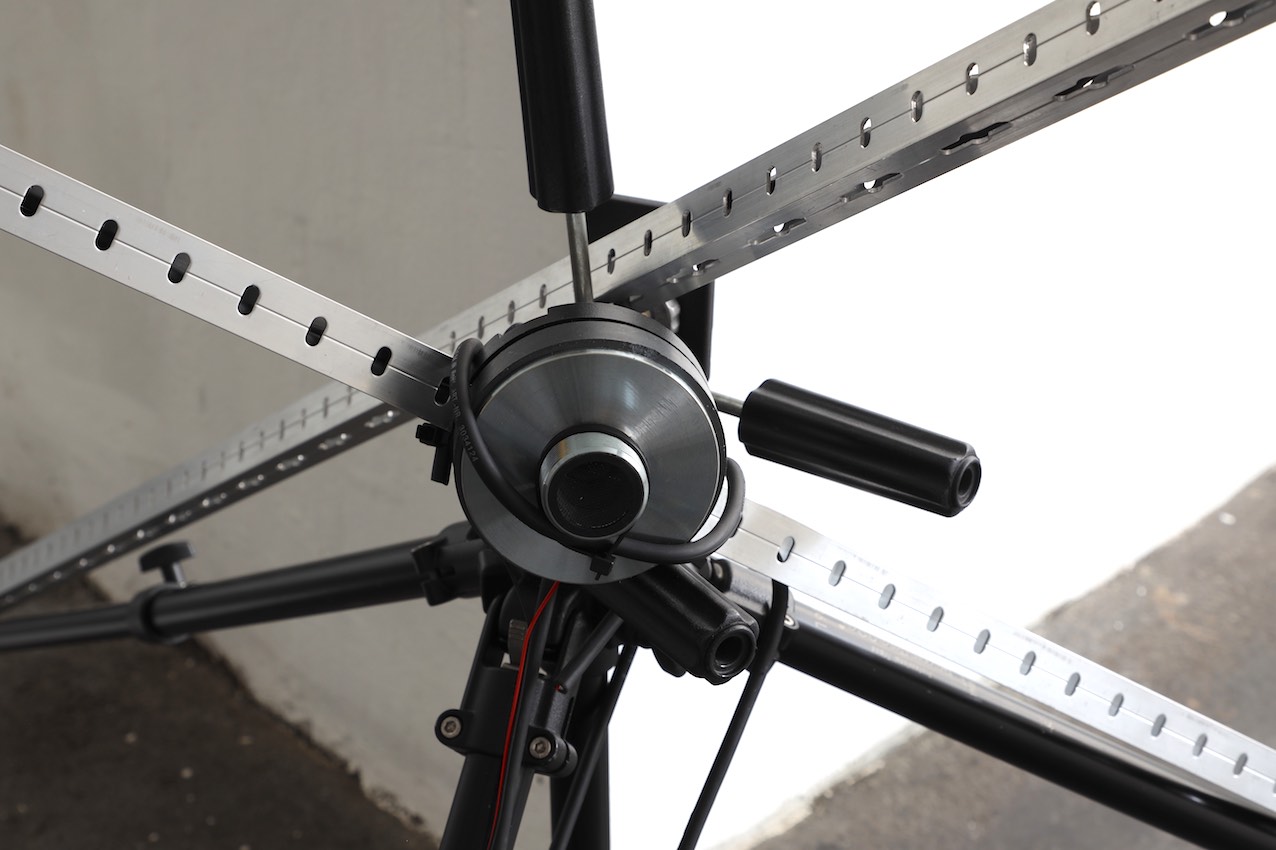
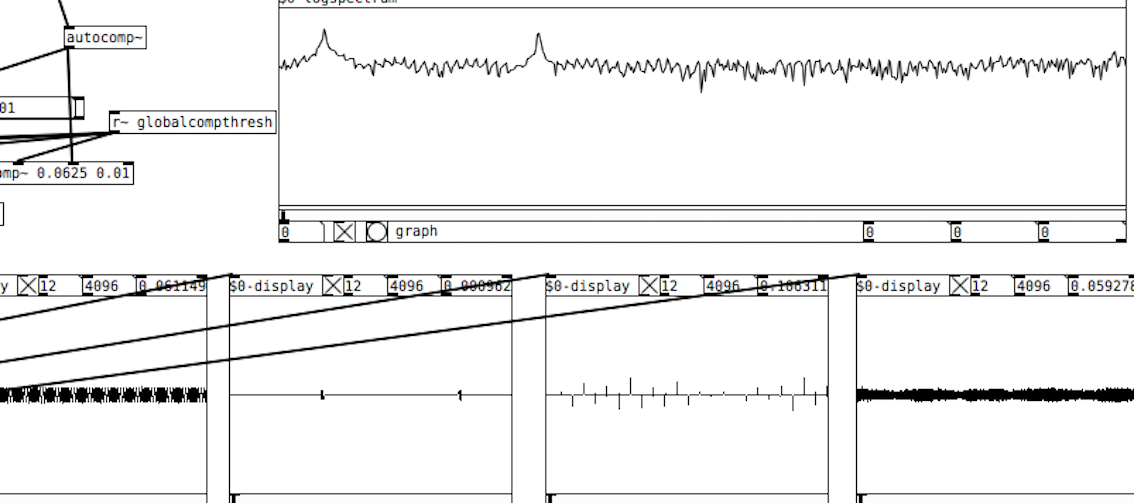
display, 4 channel audio output, PD-0.50-2
Unterm Pflaster liegt der Strand
installation, public display, at dimensions variable #, Semi Public Art, Vienna, Hietzing, 2020
cobblestone, K&K Emblem, sand, adhesive foil, text
‘Unterm Pflaster liegt der Strand’, in it's original french version of "Sous les pavés, la plage" is attributed to the situationists. The phrase became one of the most popular slogans of the 1968 revolt around the world. ‘Unterm Pflaster liegt der Strand’ alludes to the fact that paving stones were often laid on a sand underground, and is also an invitation to use them. This slogan combines hedonism with activism.
With minimal resources, the display is staged as a museum view and placed in the context of activist action.
The text is translated to latin, so it resembles often used honorable mentions on arcades and city monuments.
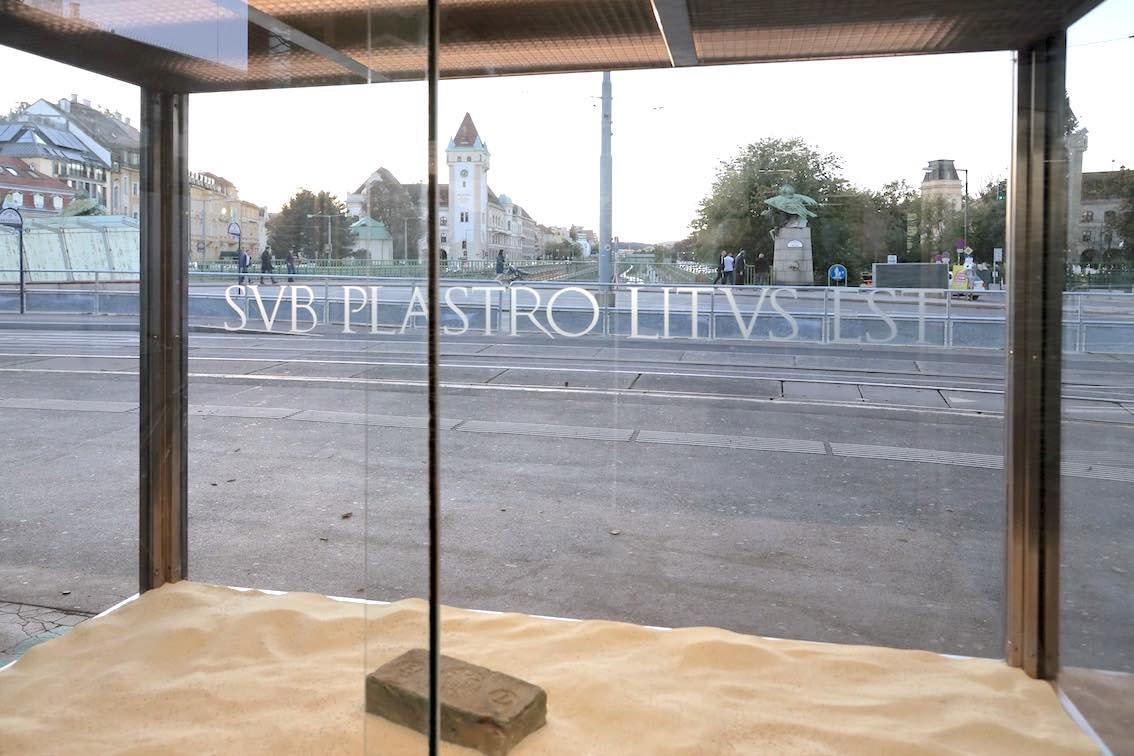
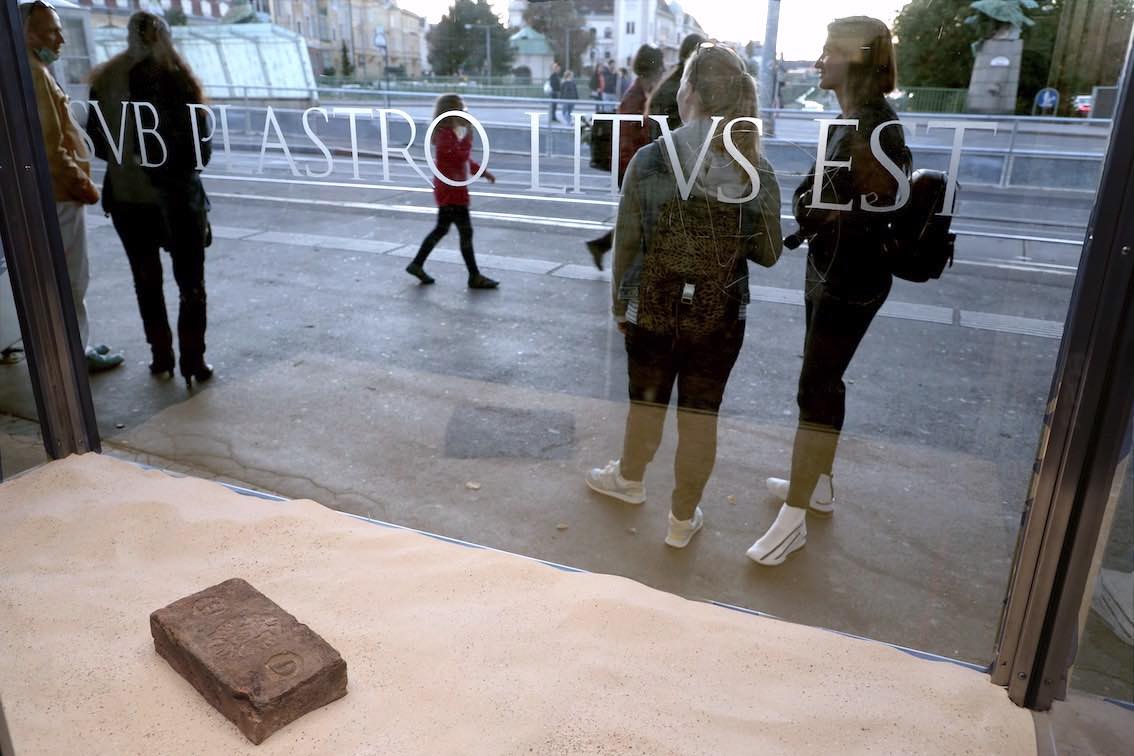
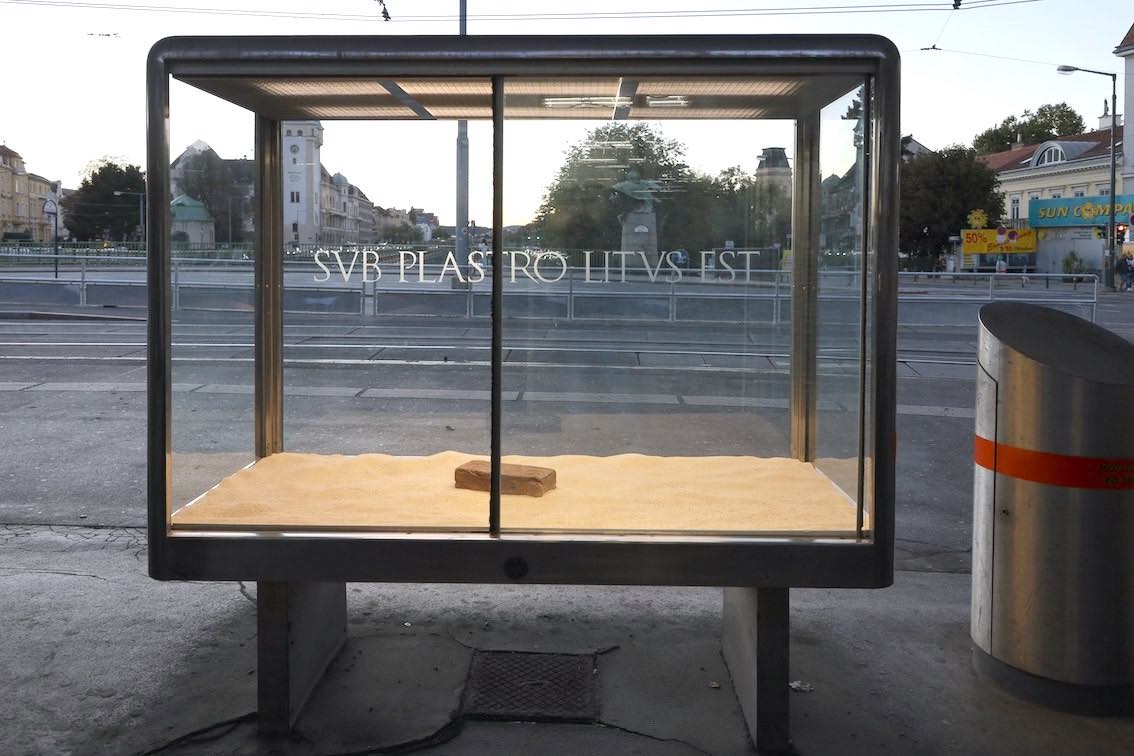
MONO-NO-KE
sound installation / concert performance / intervention in public space, July 2019
at Tokyo Arts and Space residency, KGRN, sumida area in Tokyo, Japan
acknowledgments: Tokyo Arts and Space, Ulla Rauter, Paul Reza Klein
MONO-NO-KE is part of a series of works that deal with the transmission of sound and appearance of sound events relational to space. It draws its starting point from observations in the Sumida area in Tokyo, where plastic water bottles standing next to the houses, manufacturer buildings, or hidden in the corners or in the front of stores, are used as an everyday custom to scare cats and beasts away, apparently a NEKO 'yoke'. It is also connected to the belief in Yokai and Mononoke, which combine imaginary and scientific explanation about natural phaenomena and ghost like appearances, originating from old stories of the Heian period, but occurring again in current sci-fi, manga and game culture.
Reflections and Refractions of a laser that scans plastic bottles are translated to sound through the interpretation of the refracted light. Sound is not generated but shaped by the appearance of light schemes in space. Refracted by the laser, detailed but always changing shapes appear. Those images are captured by a web-camera and translated via an IFFT process which results in an audible synthesized sound.
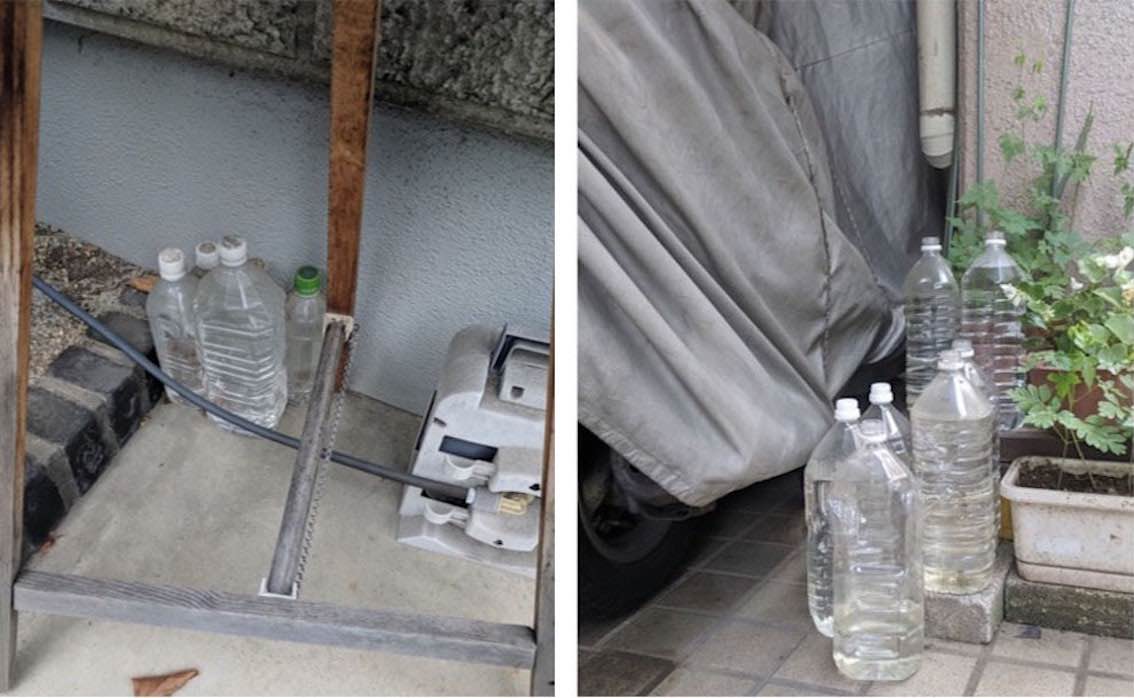
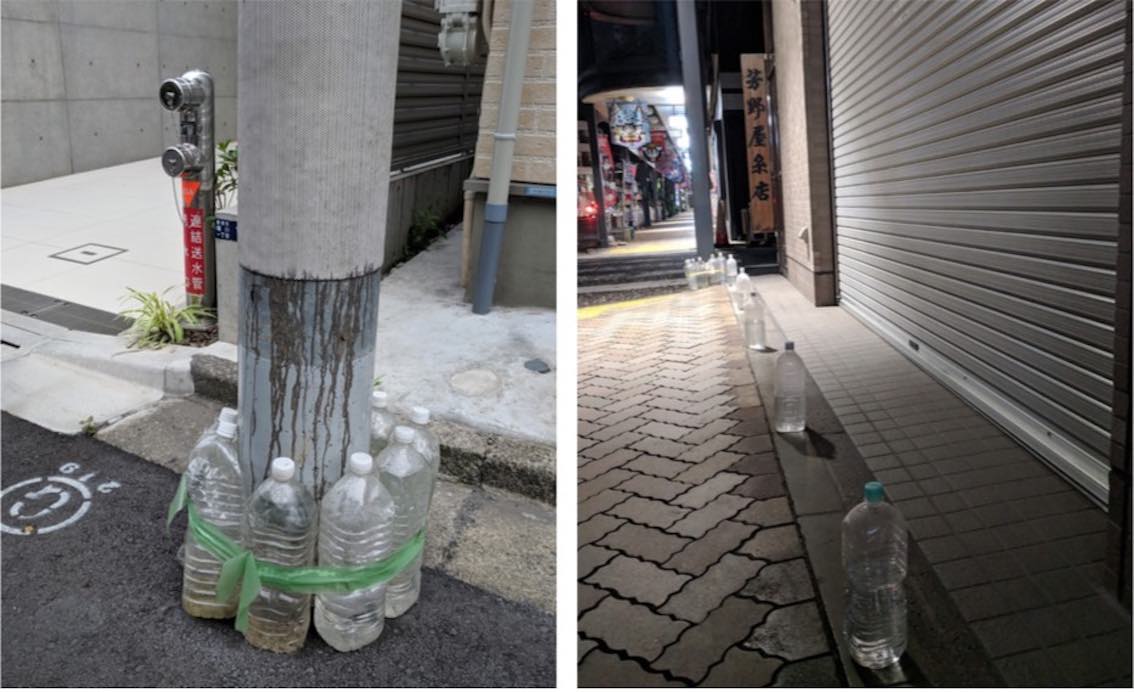
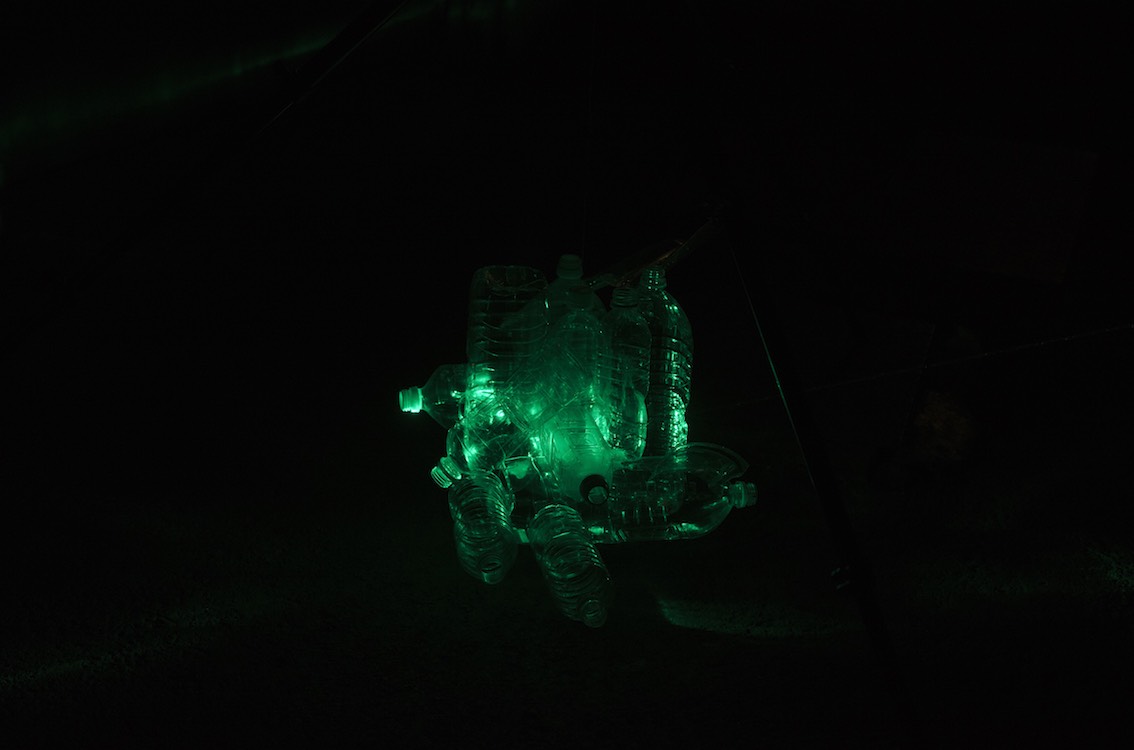
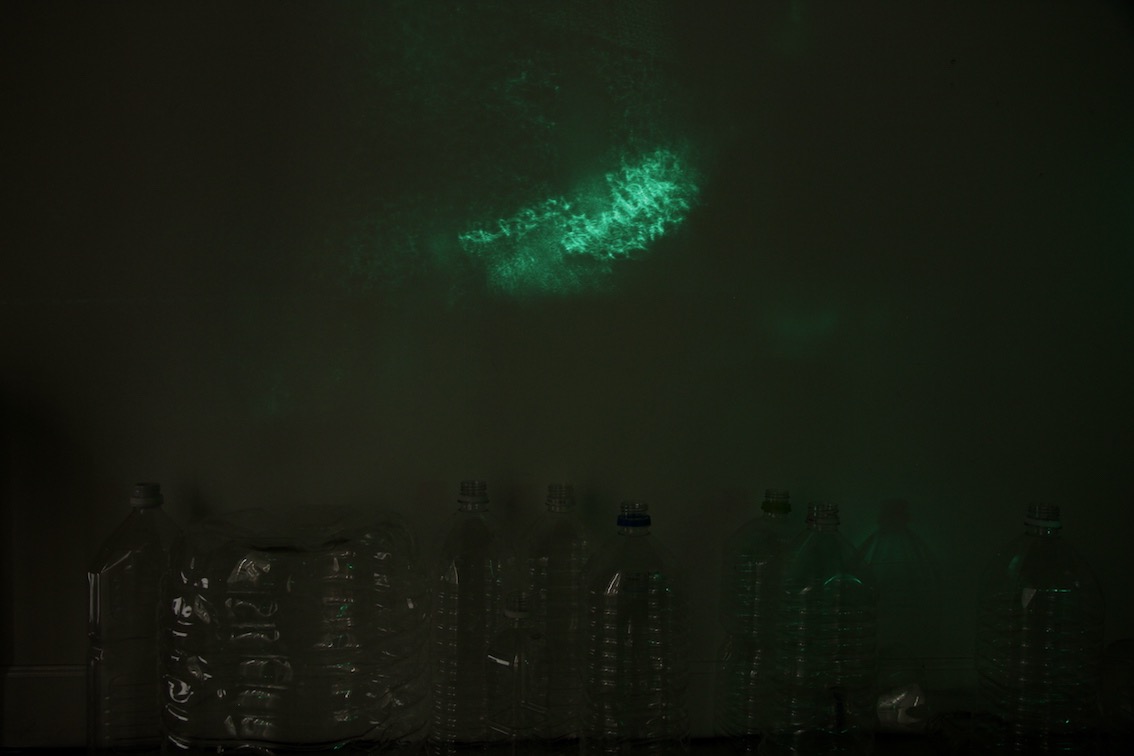
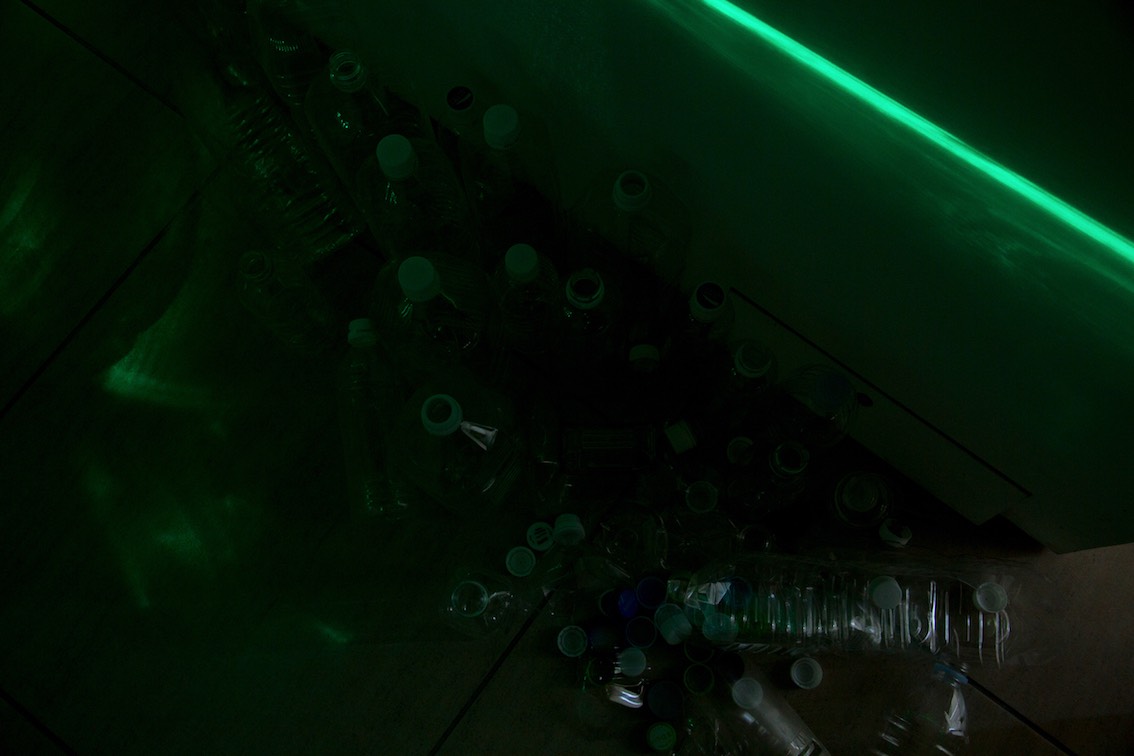
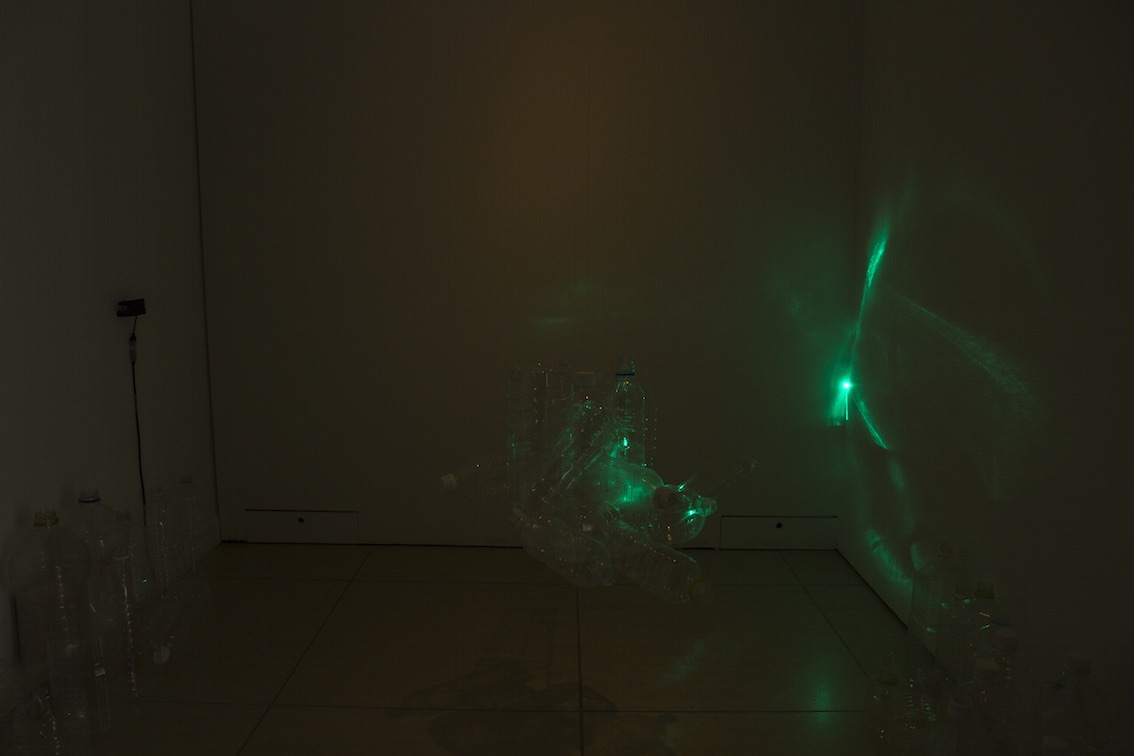
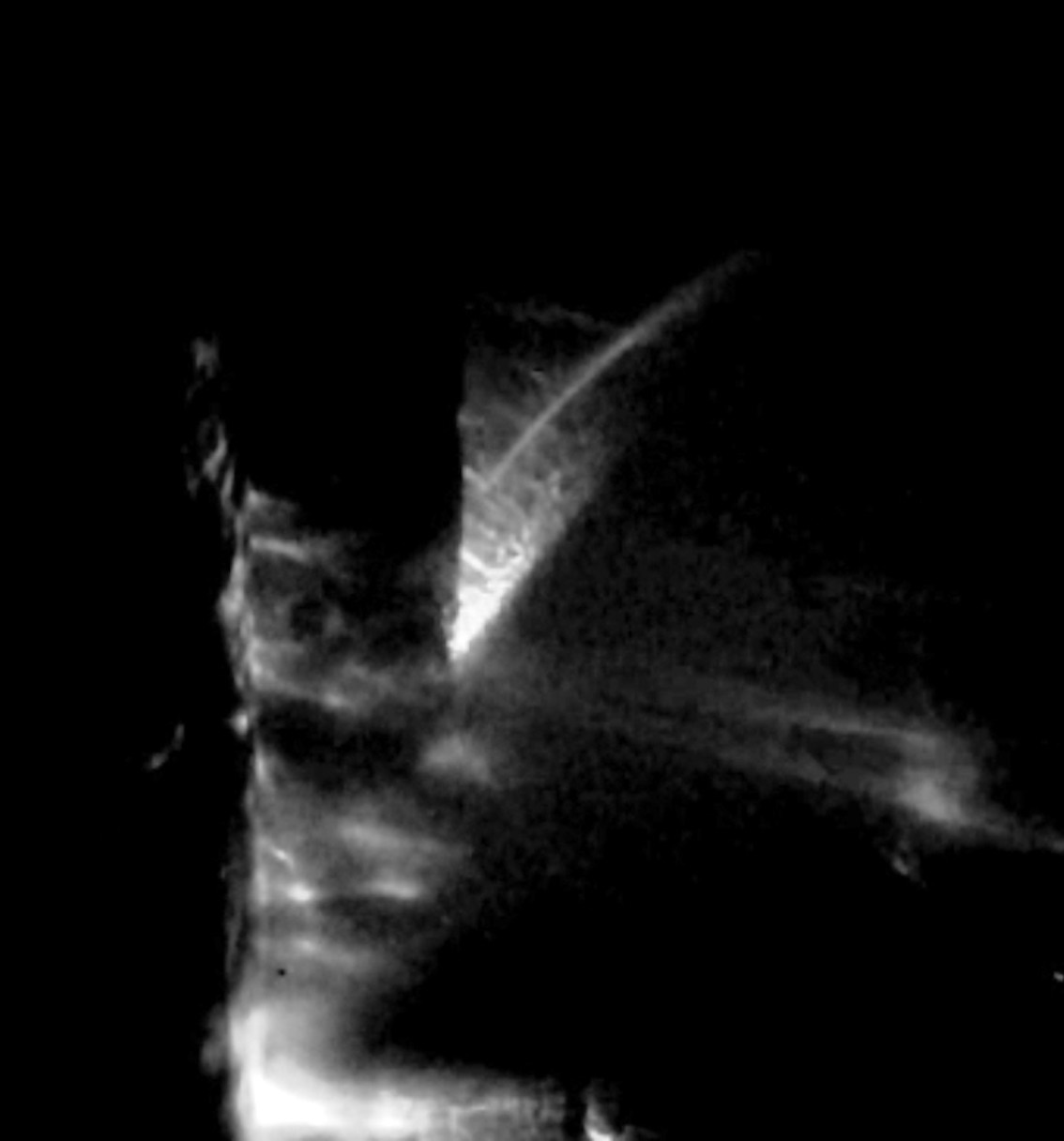
NEKO 'appearance', PD-0.50-2, Paul Gründorfer
Arcadian Gate
Site Specific Installation, 2018
vlf antenna, audio modulated laser, solar-cell amplifier, loudspeaker
Tuned City, organised by Carsten Stabenow
Ancient Messene, Mavromati, Greece
Natural radio frequencies, that are caused by meteorological phenomena, are transmitted by a laser through the Arcadian Gate of Ancient Messene and received on the other side of the walls by a solar cell amplifier. The detected sound is diffused by a loudspeaker and resonating through the gate.
The western Gate of Ancient Messene, called Arcadian Gate, is preserved in relatively good condition and since the time of the early travelers it has become the symbol of the city depicted repeatedly on engravings.
The Arcadian Gate is a monumental construction built of gigantic awe inspiring limestone blocks. Its shape is circular with two entrances, a double one in the interior and an external one, the latter being protected on either side by two square-shaped towers. The circular area inside the Gate has two niches, one on each side of the entrance where a Hermaic stele stood. God Hermes appears under his capacity as Propylaios, that is, the protector of Gates. Above the north niche one can read the following inscription: Κoιντος Πλώτιος Ευφημίων επεσκεύασεν Cointus Plotius Euphemion restored (the Gate).
(from
http://wikimapia.org/4832019/Arcadian-Gate
)
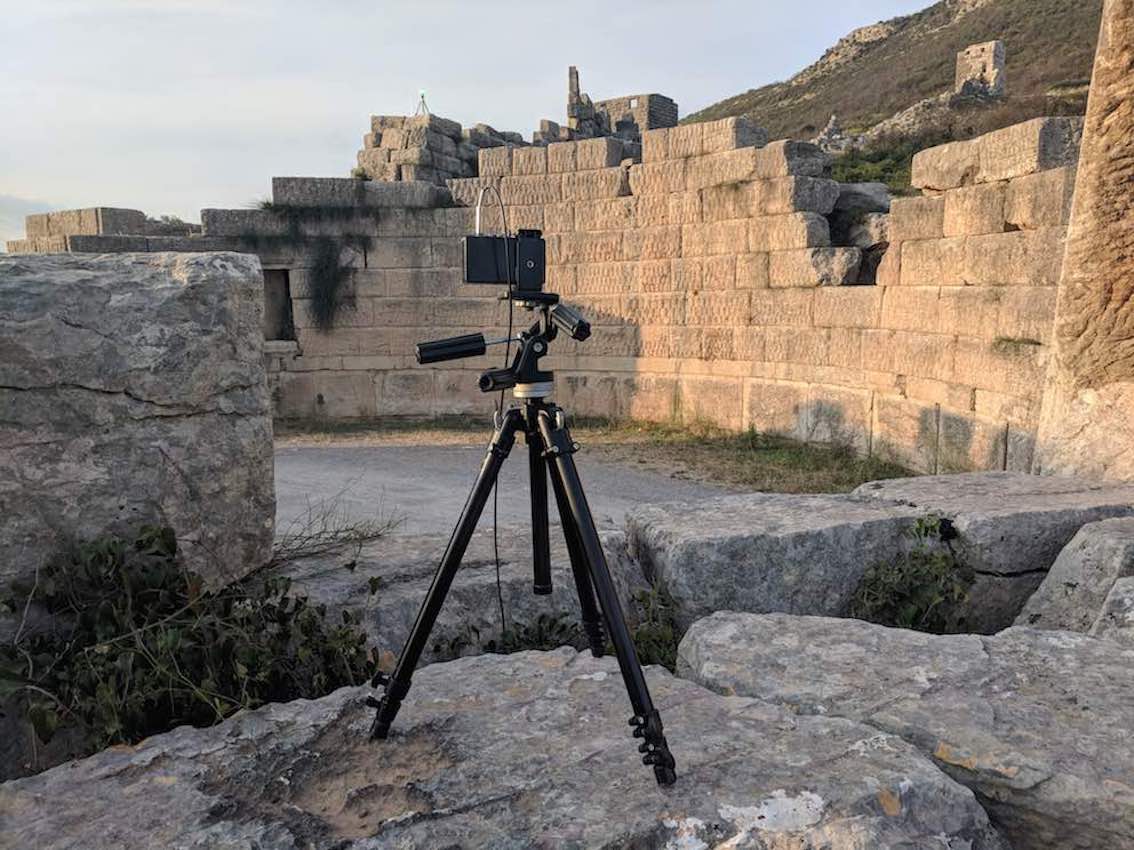
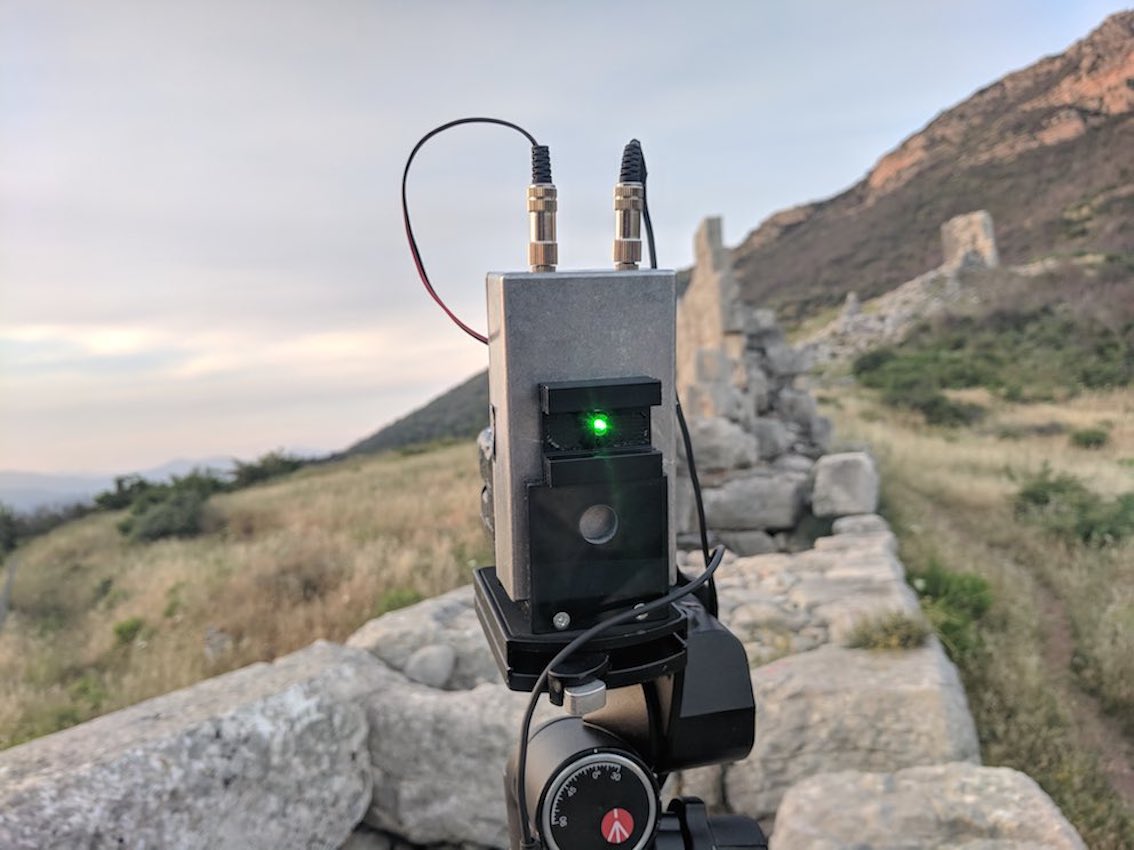
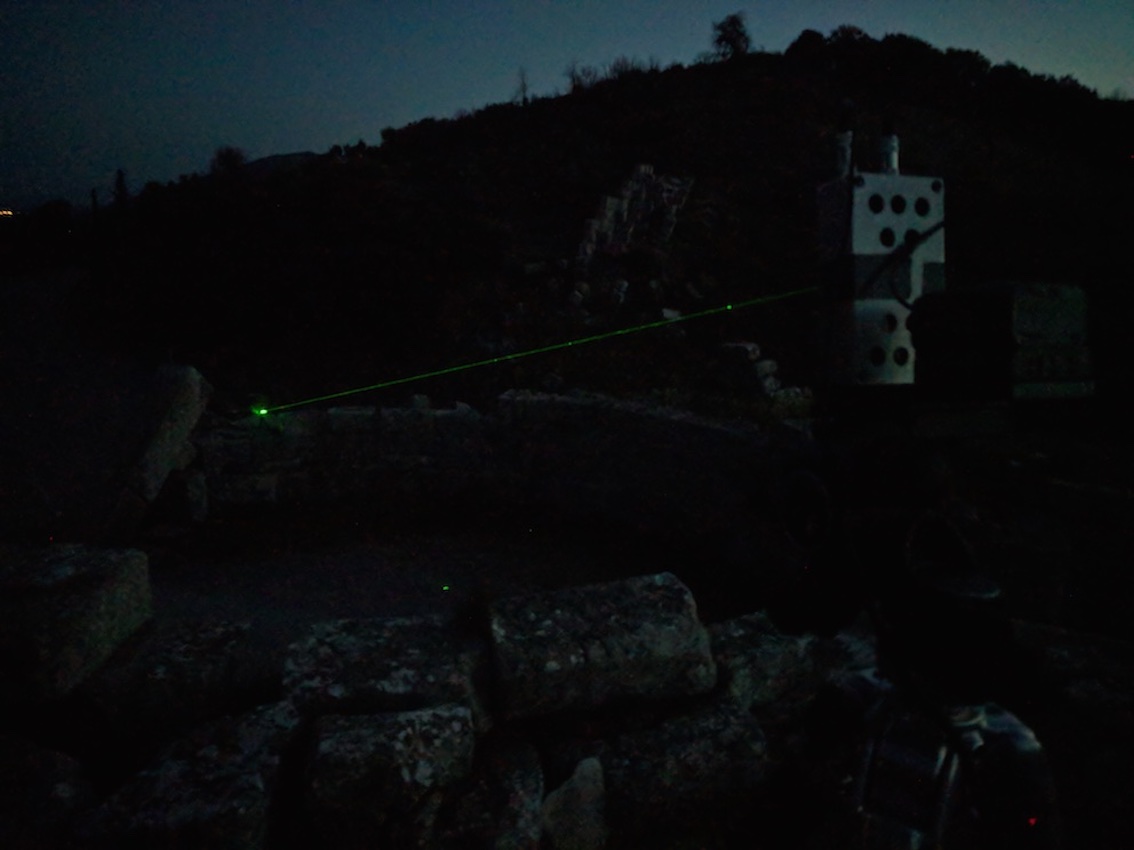
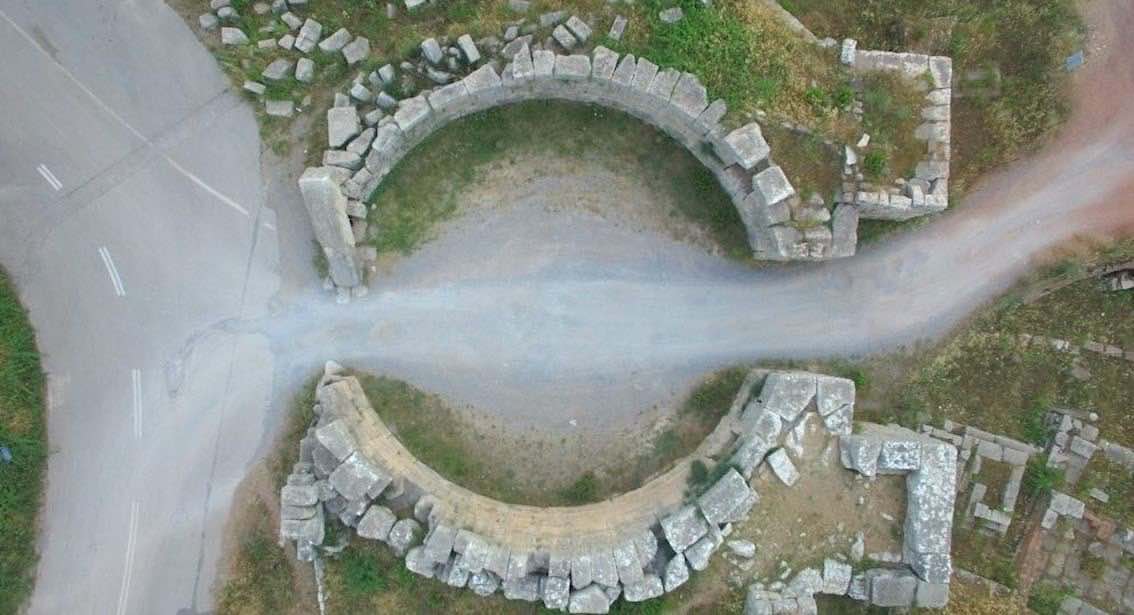
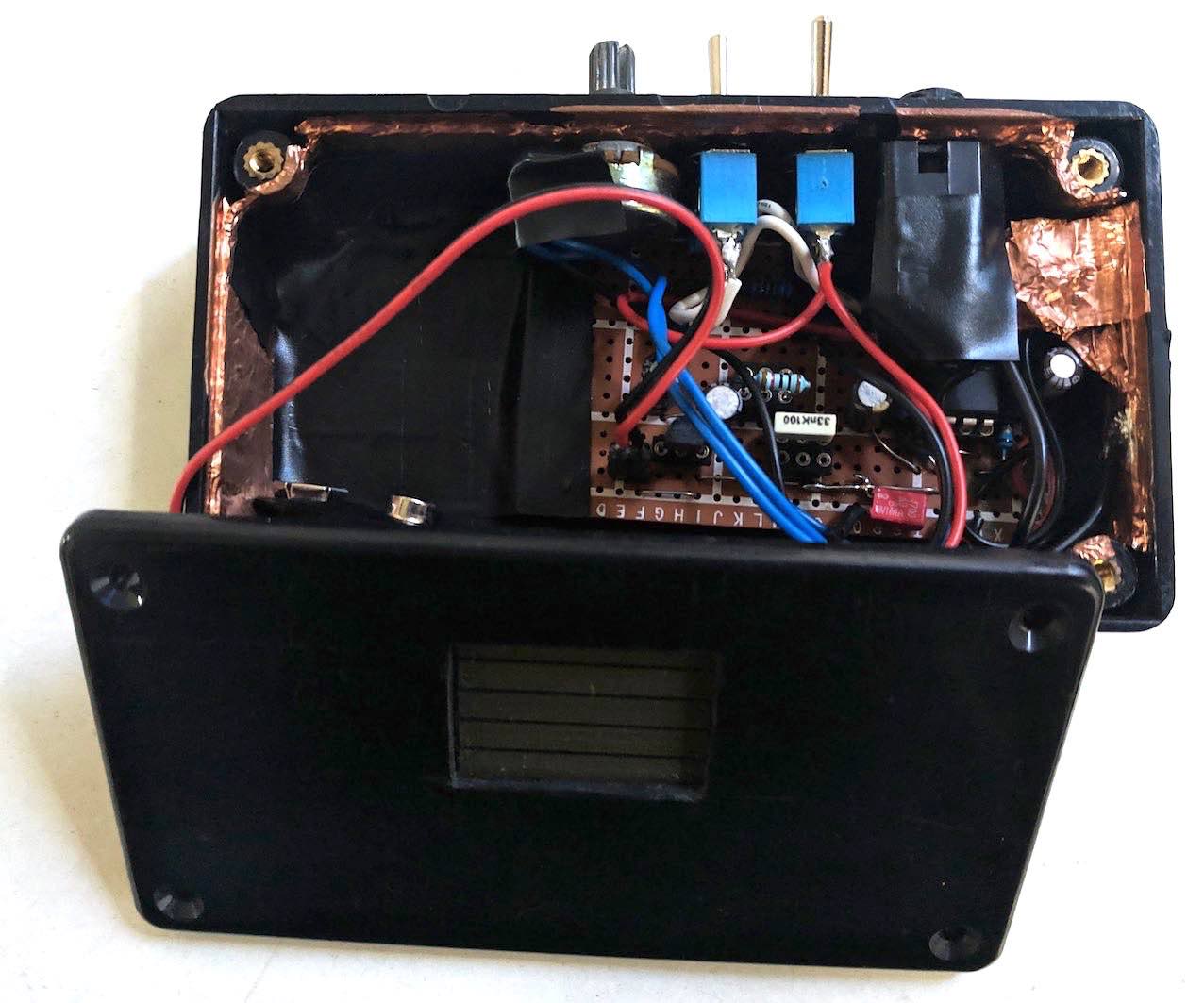
鸽子
39.891582, 116.391015
site specific research, happening 08:22am on may 12 2018
Dashila Area Beijing
4k video, binaural recording
in cooperation with Jialin Yang and Micro Yuan’er, documentary crew with Xiang Nan / camera by Xie Chao
made possible by Wan Lianxi letting fly his flock of pigeons, pigeonflutes by Wang Yongsheng
with the support of Shayan, Yi-Chi Wang and TGIS
The video shows a 360 degree scan of an Hutong area in Dashila, Beijing. It is considered a ‘red flight zone’, where the use of drones is prohibited due to the proximity to forbidden city and Tiananmen, Beijing.
The old Hutong quarters are quite narrow and form a complex mesh of adaptions to the old traditional buildings, that organically grew over the years, that they have been open to the people. On some of the houses rooftops flocks of pigeons have their shelter. Those pigeons are mostly trained to participate in pigeon racings, and are therefore held with a lot of care, as pigeon racing turned out to be a gambling sport, that is also connected to wealthy people and yield high profits. It is said that the main goal for flight competition is not about money but honour, but there seems to be an evolving business going on with pigeon breeders, traders, pirating and betting offices. A worldwide market that evolved especially in China to unite economical, cultural, social and industrial interests to breed the best pigeons to achieve victories in the races.
Besides this interest, there is the old tradition to let pigeons fly with special designed flutes, that get attached to the tail of the pigeons. Some of the flutes date back to the Qing dynasty and are still remade as collectibles to value the old handcraft. There are four types of whistles - tube, star, calabash and stareye types, that produce drone like tones up to pentatonic scales. When a flock of birds flies with the flutes attached, it appears as they mark a territory by circling in a certain orbit, diffusing the flute sound in a 3 dimensional spacial way.
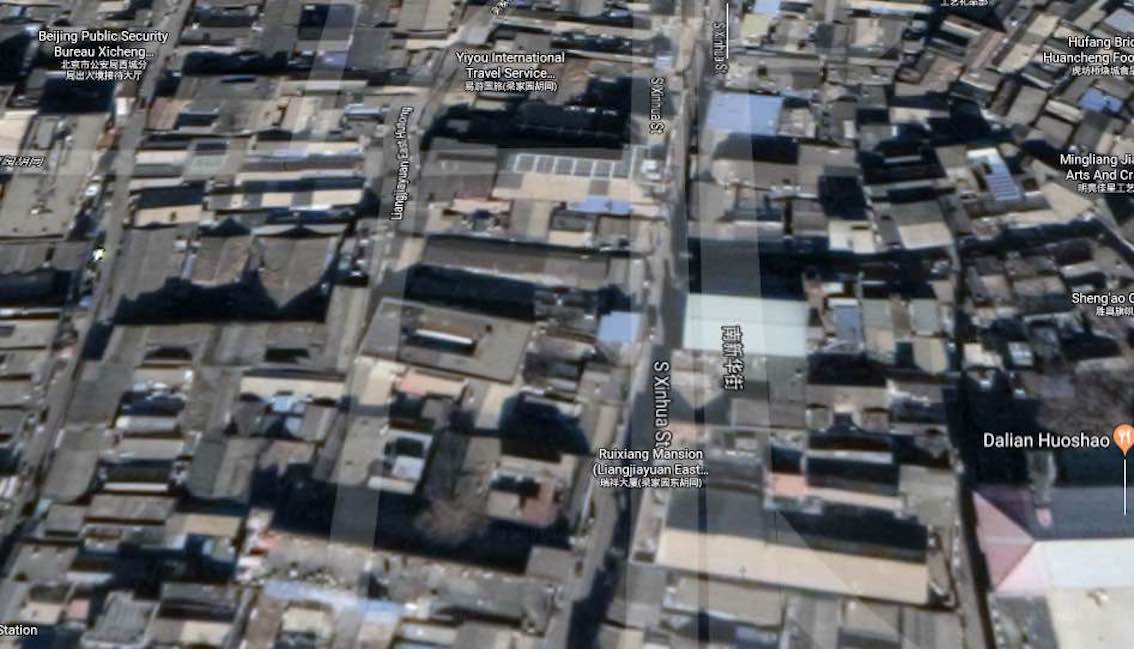
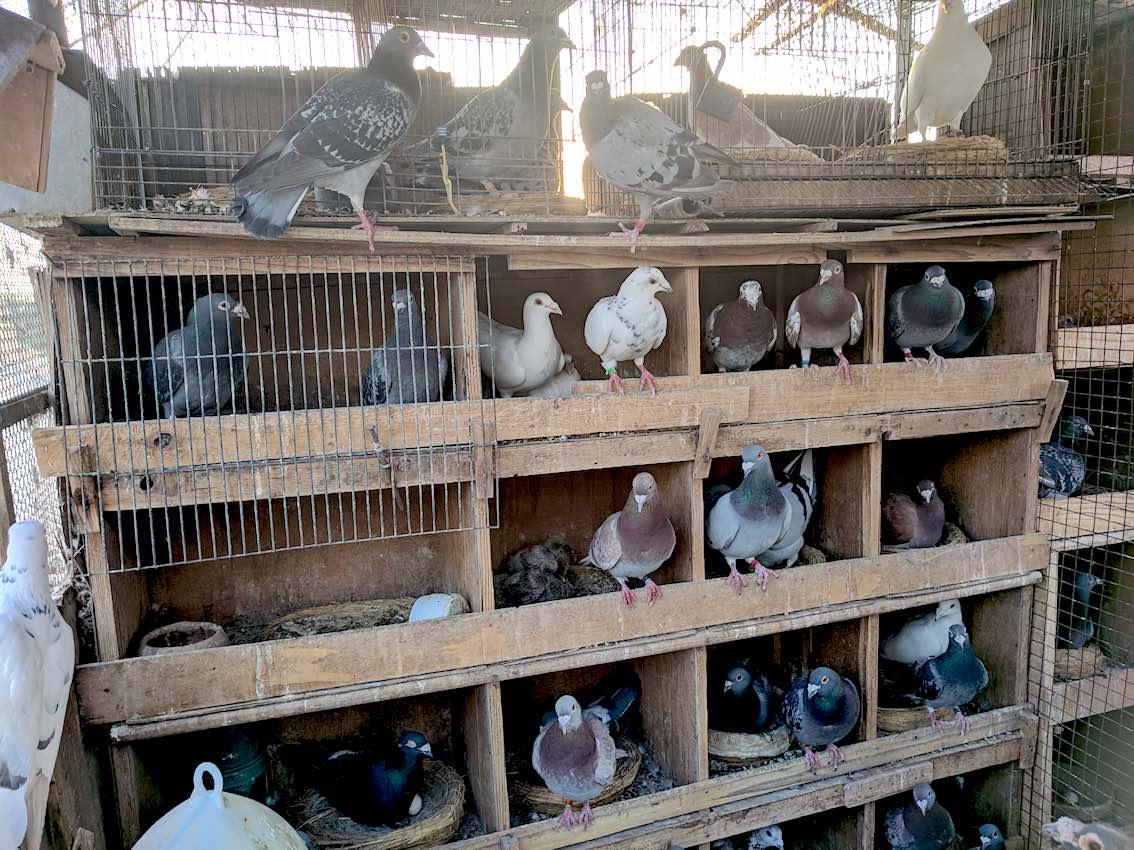
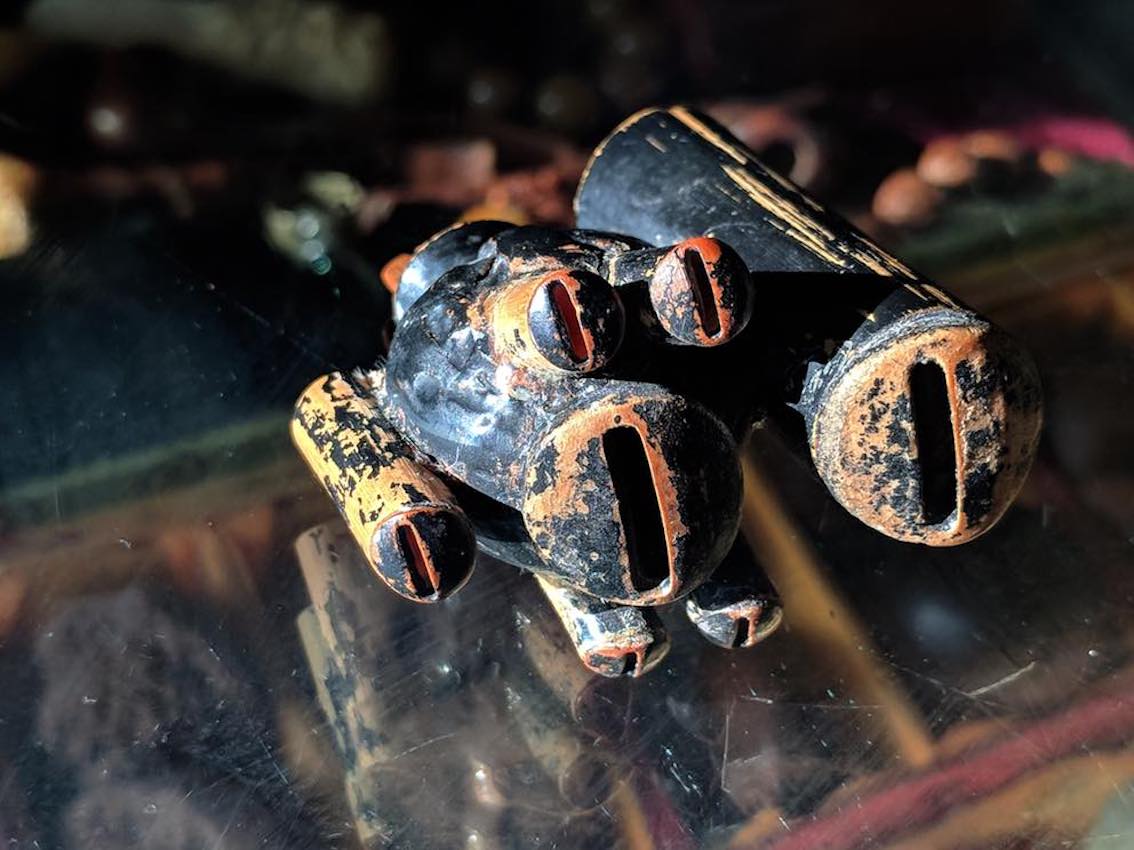
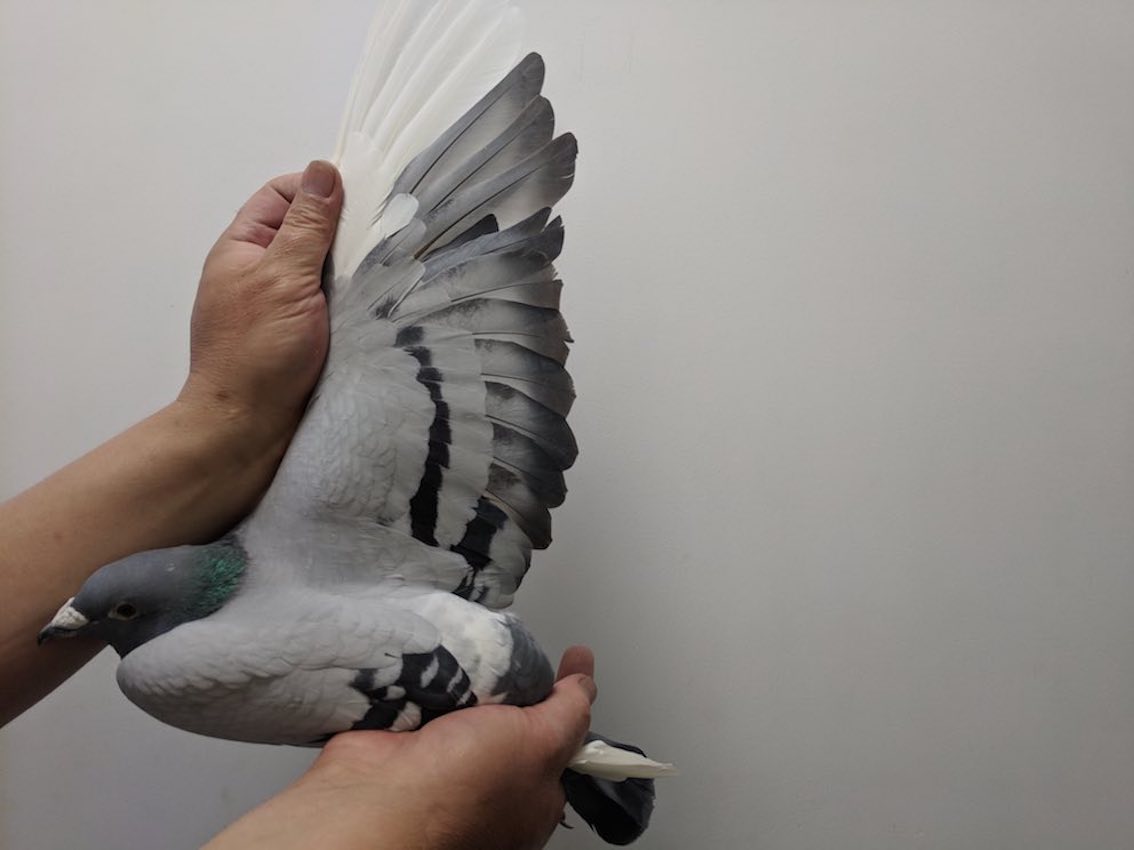
Centre and Periphery
Site Specific Investigations, 2017
kite, cables, transistor amplifier for vlf-signals, recorder
Magellan Region:
Cerro Sombrero, Parque Karukinka, Puerto Williams, Cape Horn
[CL]
during a research journey together with Nicolás Spencer
recommendations for the kite construction by Fritz Harich, Jan Houtermans, Sophie Dvořák
this project was supported by the Embassy of Austria in Chile, BKA, and SKE - Austro Mechana
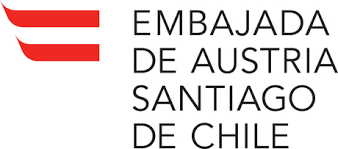


Very low frequency signals (VLF-signals), which are can be caused by meteorological phenomena such as thunderstorms and lightning, were detected by a kite with an antenna and made audible through the use of a high sensitive transistor amplifier. The recordings were taken during a research trip in southern part of Chile and on Cape Horn.
excerpts of vlf-recordings at different locations:
Among other things, the tour in the Magellan region in Chile dealt with the question of how places can be recorded in terms of sound, and whether topology can be taken as a starting point for experiments with sound. The route first went from Punta Arenas to Cerro Sombrero and Parque Karukinka in the Tierra del Fuego region and then by sea to Puerto Williams and Cape Horn, covering parts of the Strait of Magellan, which was discovered during the first circumnavigation of the world in 1520 and also sailed by Charles Darwin on the 1834 expedition on the HMS Beagle. The Magellan region in Chile is, on a global scale, a remote territory and only marginally populated. Of the indigenous peoples who used to live there, who were exterminated by diseases and planned expulsions, there is no comprehensive documentation available. Now, in addition to the large port facilities and the production stations of the state-owned oil company ENAP in the region around Punta Arenas, in the south at Puerto Williams mainly military bases, nature parks and sporadic tourist stations can be found. In between there are large uninhabited and inaccessible zones that can only be seen passing by with transport ships.
The project Centre and Periphery picked up this field of tension in order to deal with the region and its topology abstractly and audibly. Based on the idea that all places are now decoded by modern communication technologies (geosatellites, radar, marine systems, measuring stations, ..) and are connected in a synchronized way in a global network, spatial specifics have been searched for signals that occur only in remote places and are otherwise inaudible. Following the meaning of periphéro "carrying around" (ancient greek: carrying around, environment,..), a mobile sculpture and measuring station was constructed in the form of a kite to pick up VLF signals. VLF signals are electromagnetic waves that are reflected by the ionosphere and triggered by meteorological phenomena such as thunderstorms or lightning. Persistent strong winds from the Antarctic and the extreme weather conditions on site were both a prerequisite, as well as theme for this project.
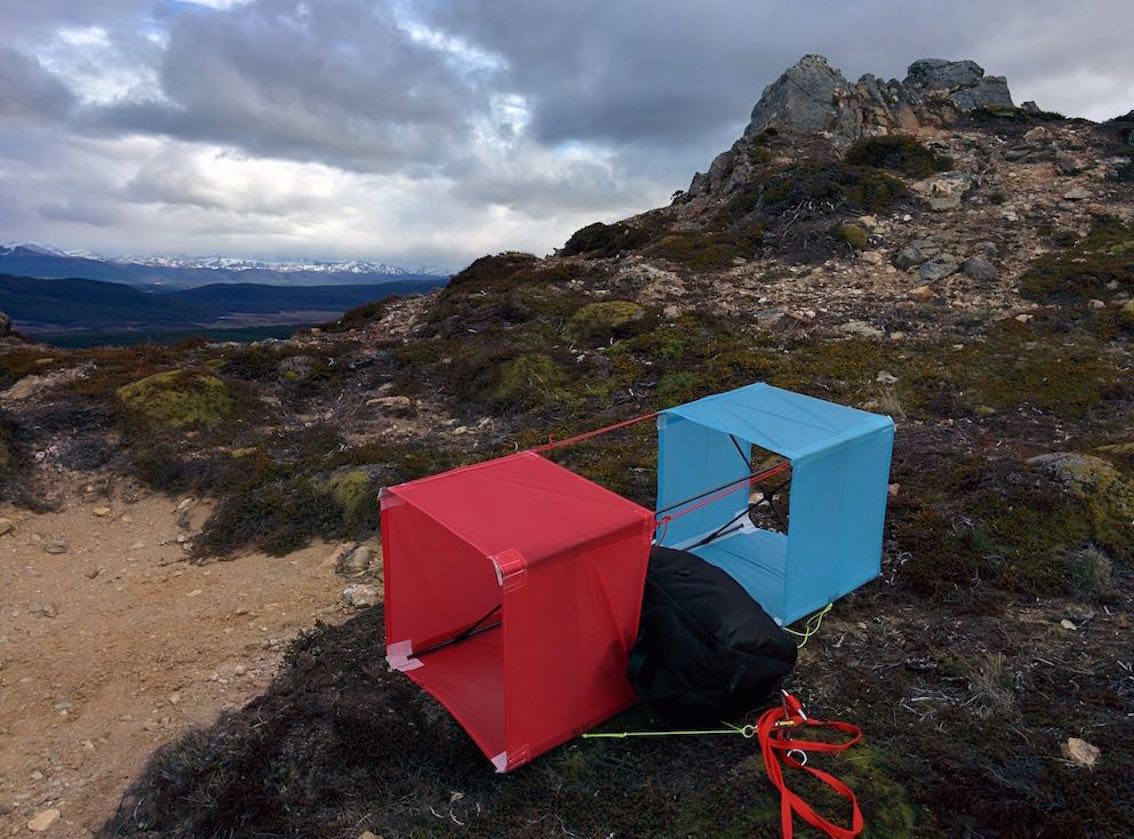
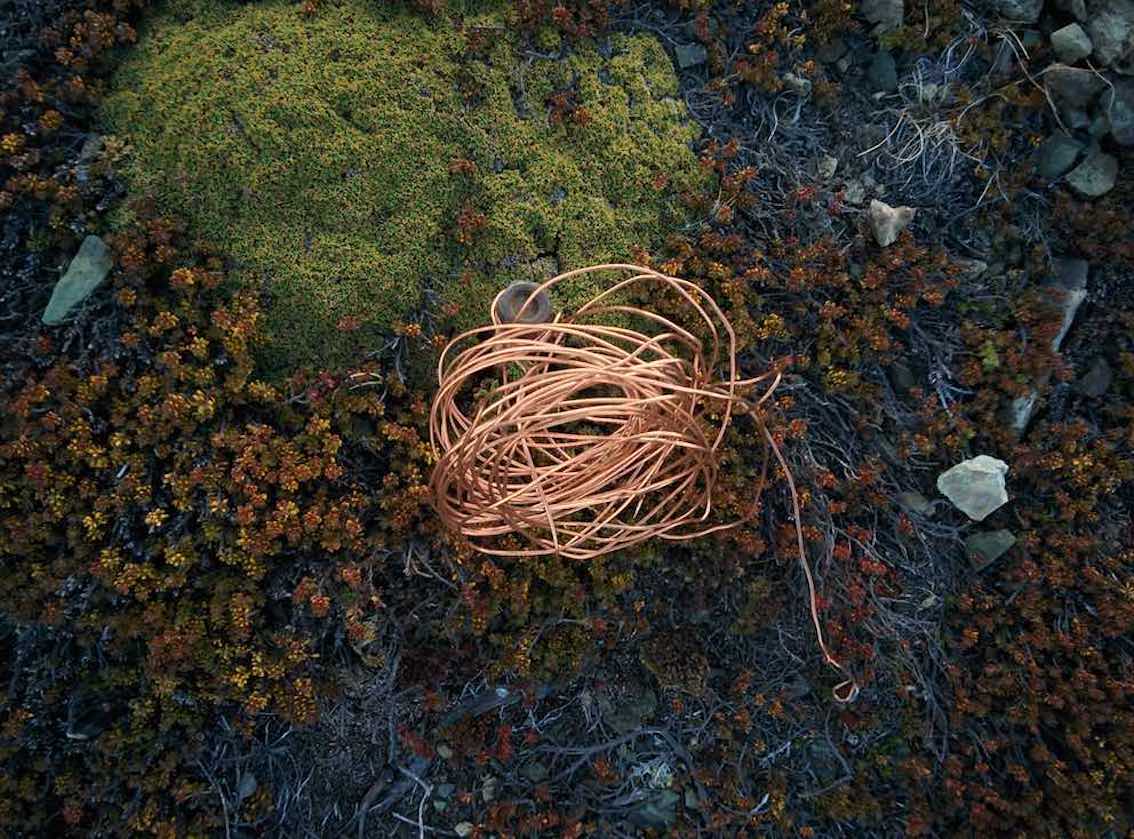
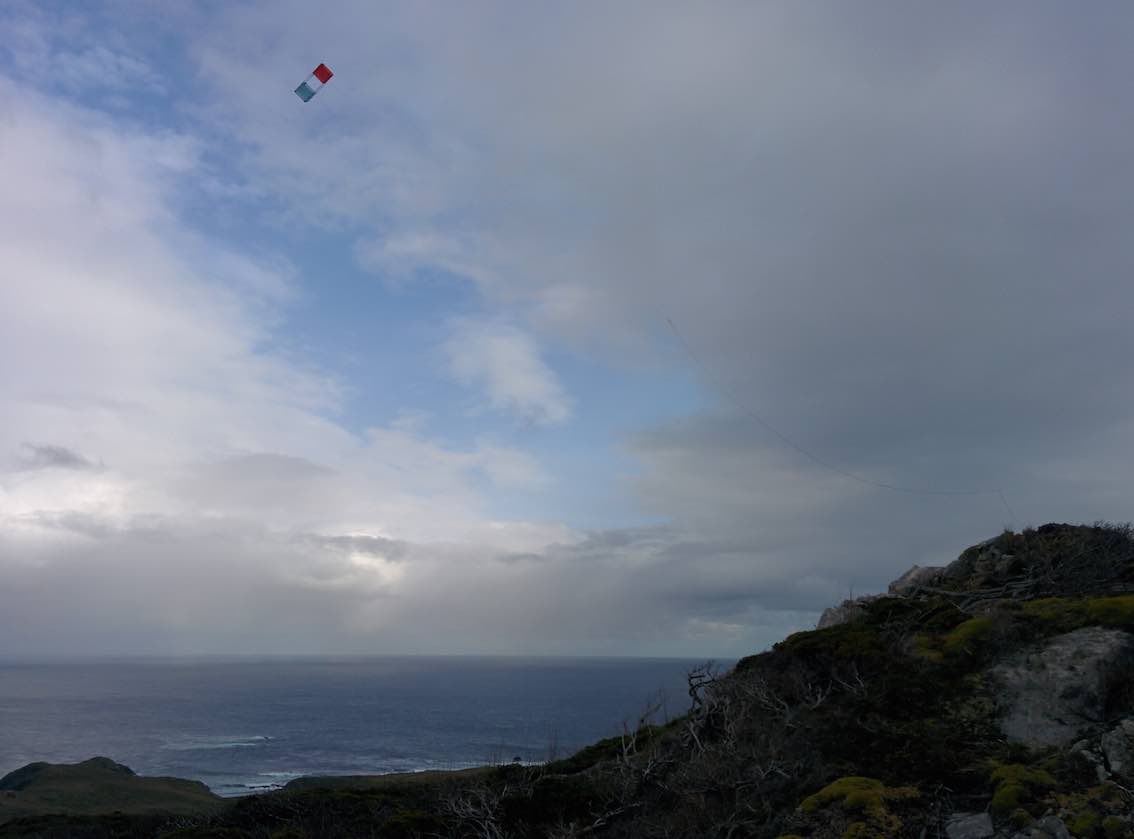
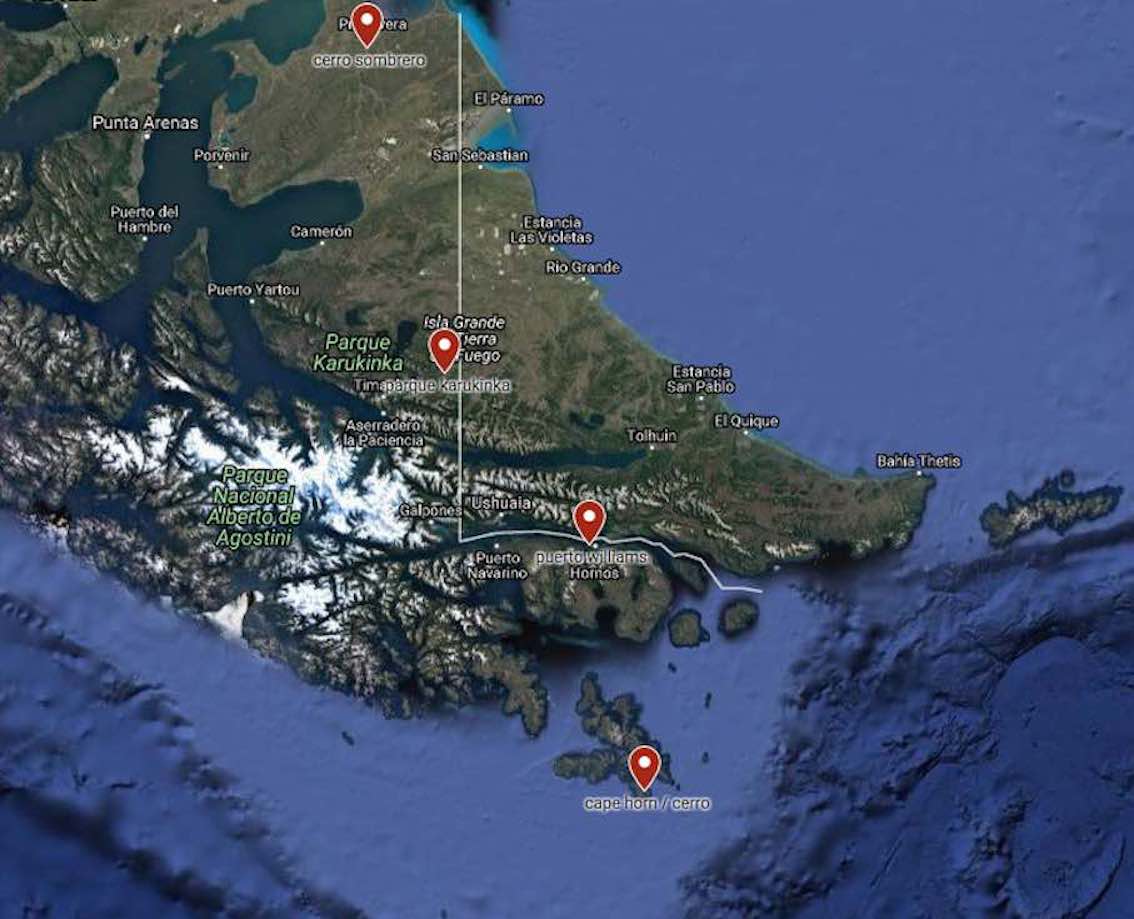
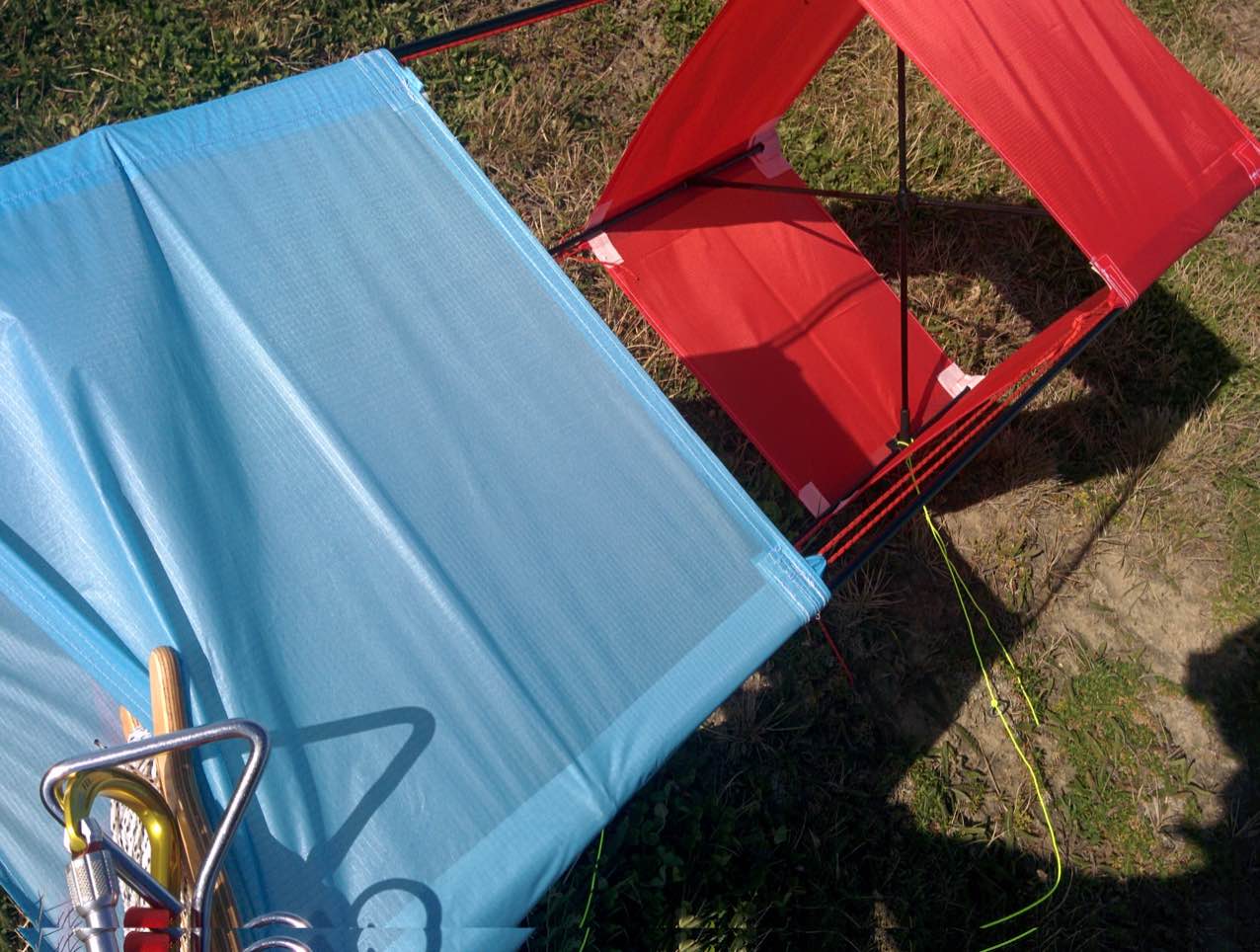
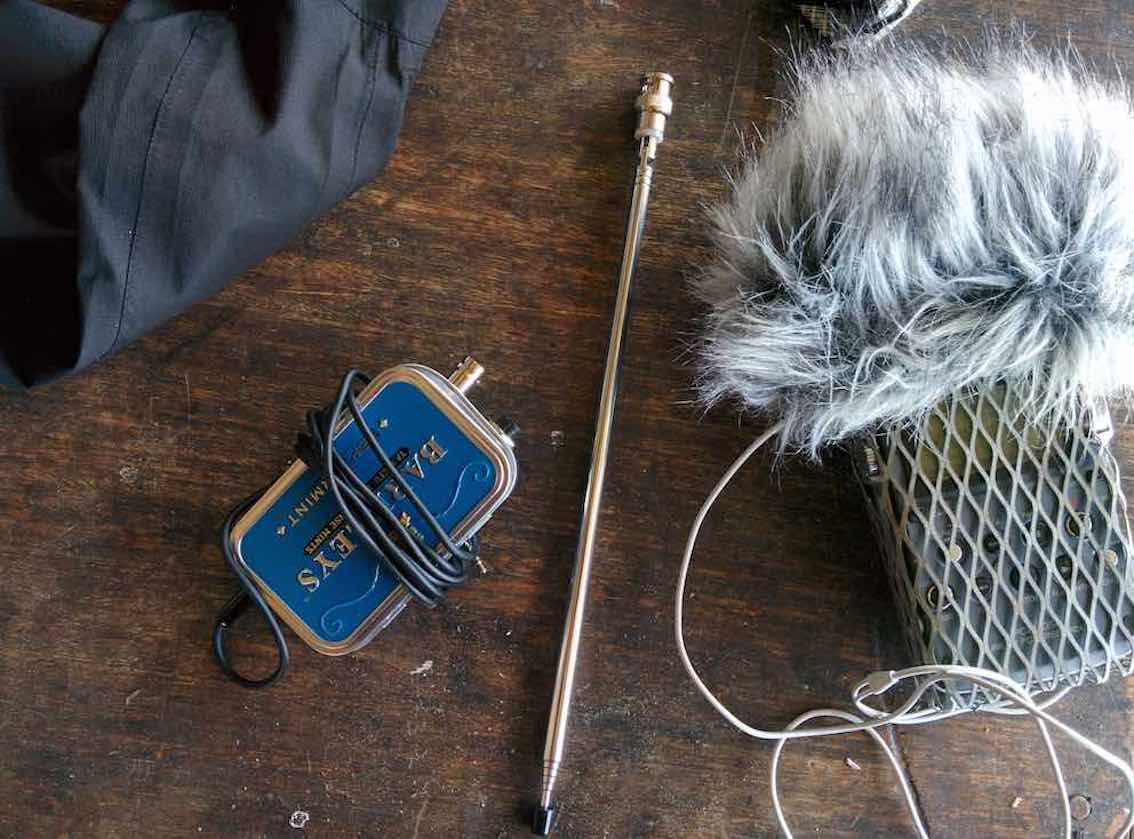
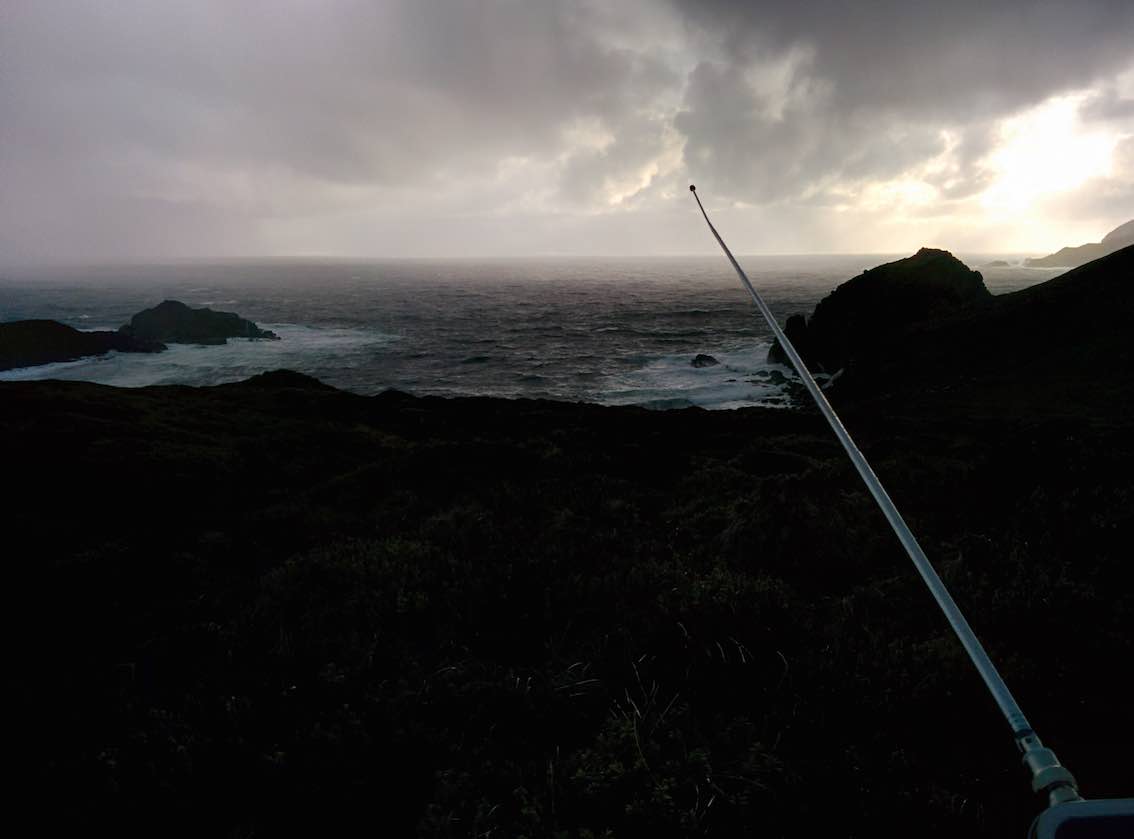
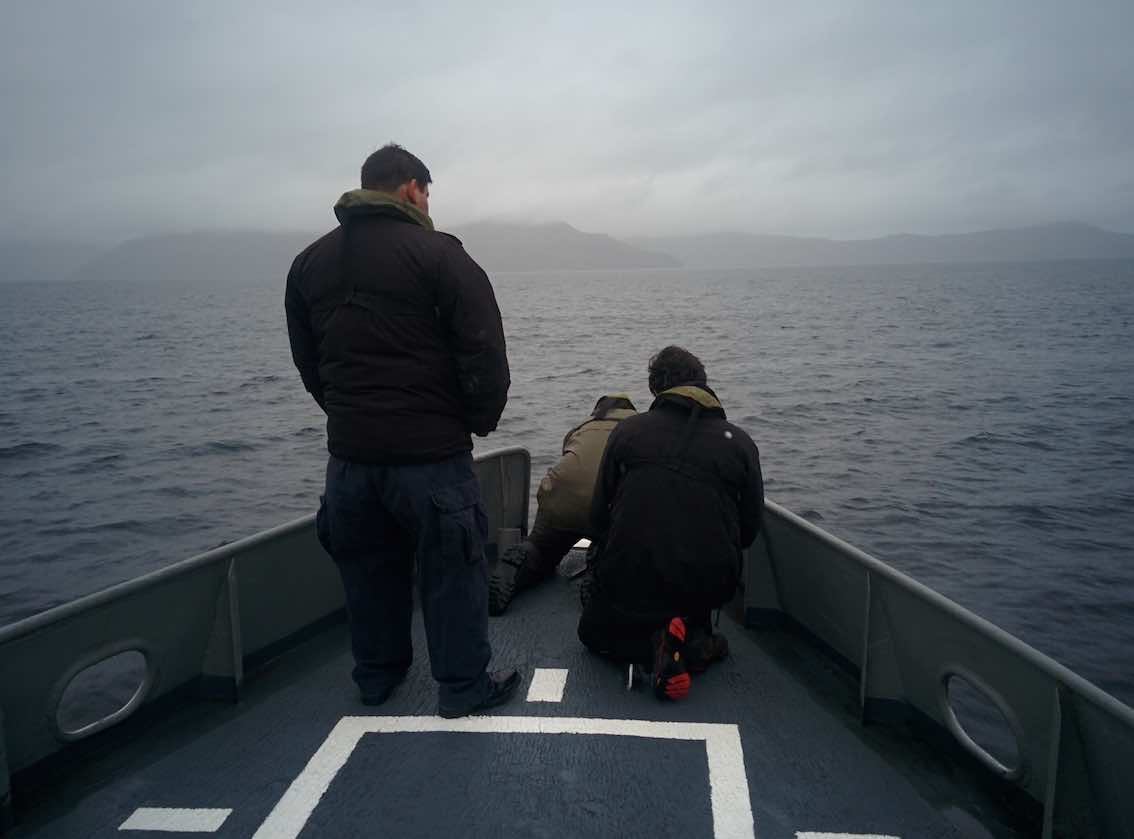
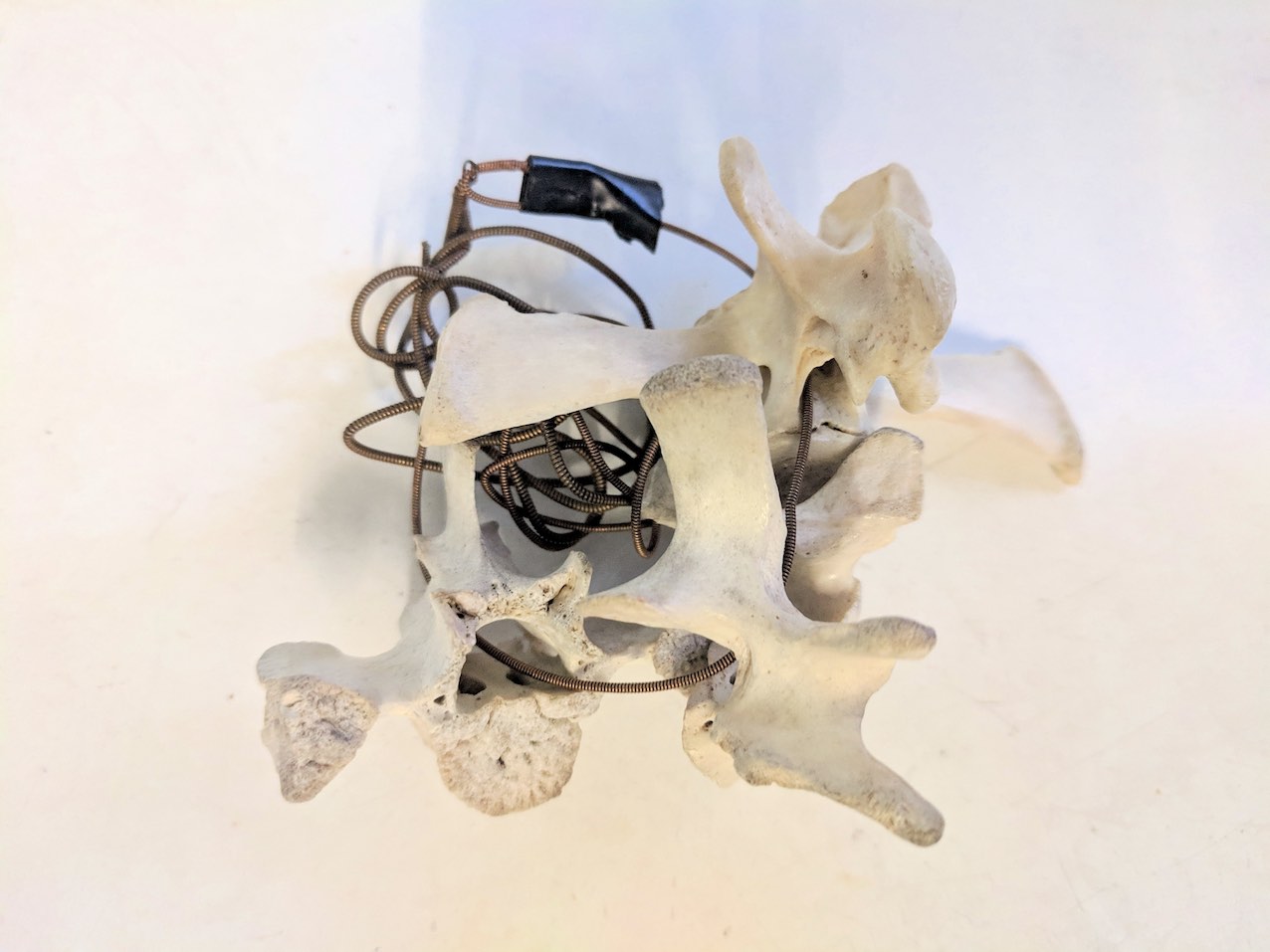
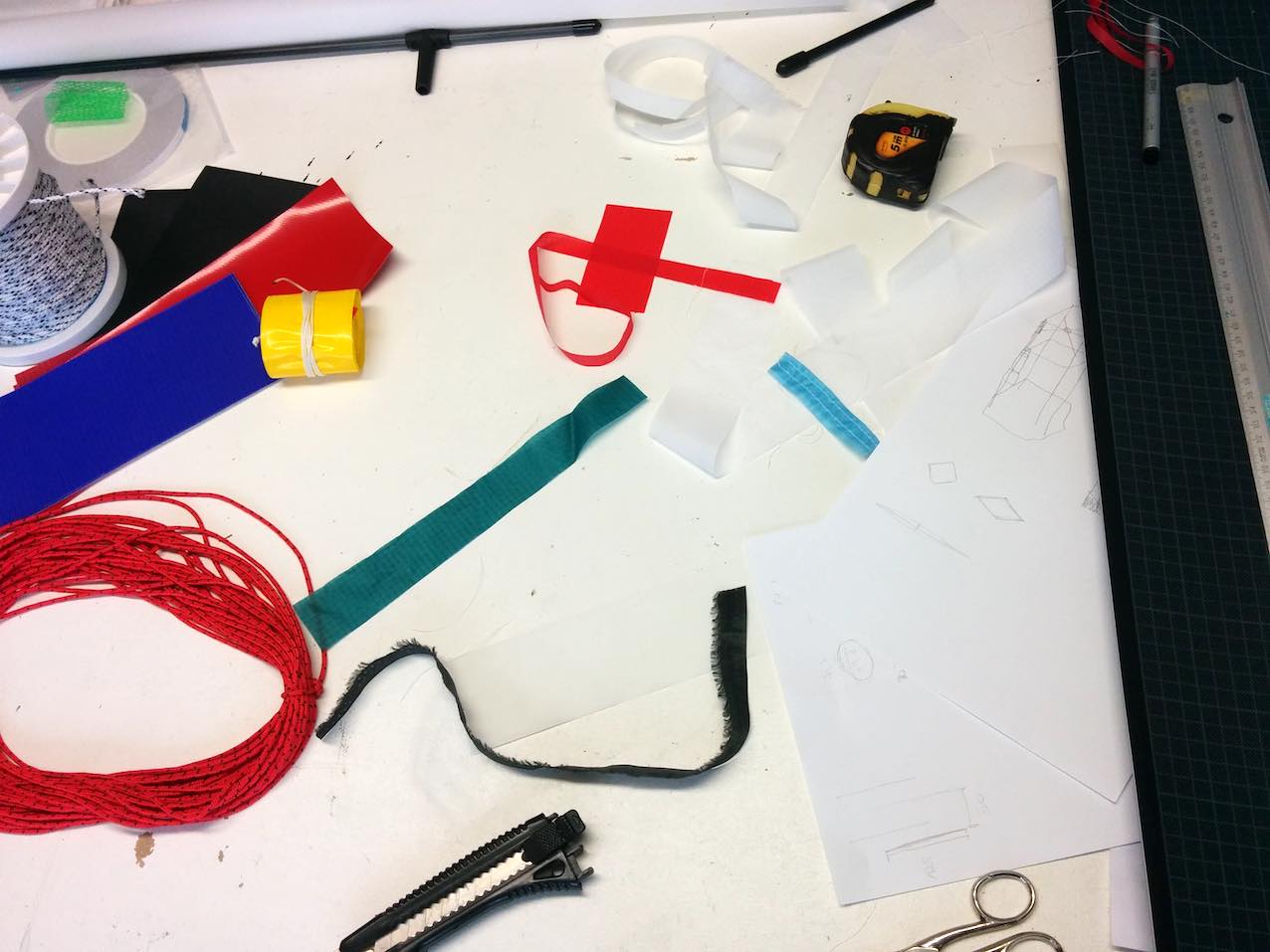
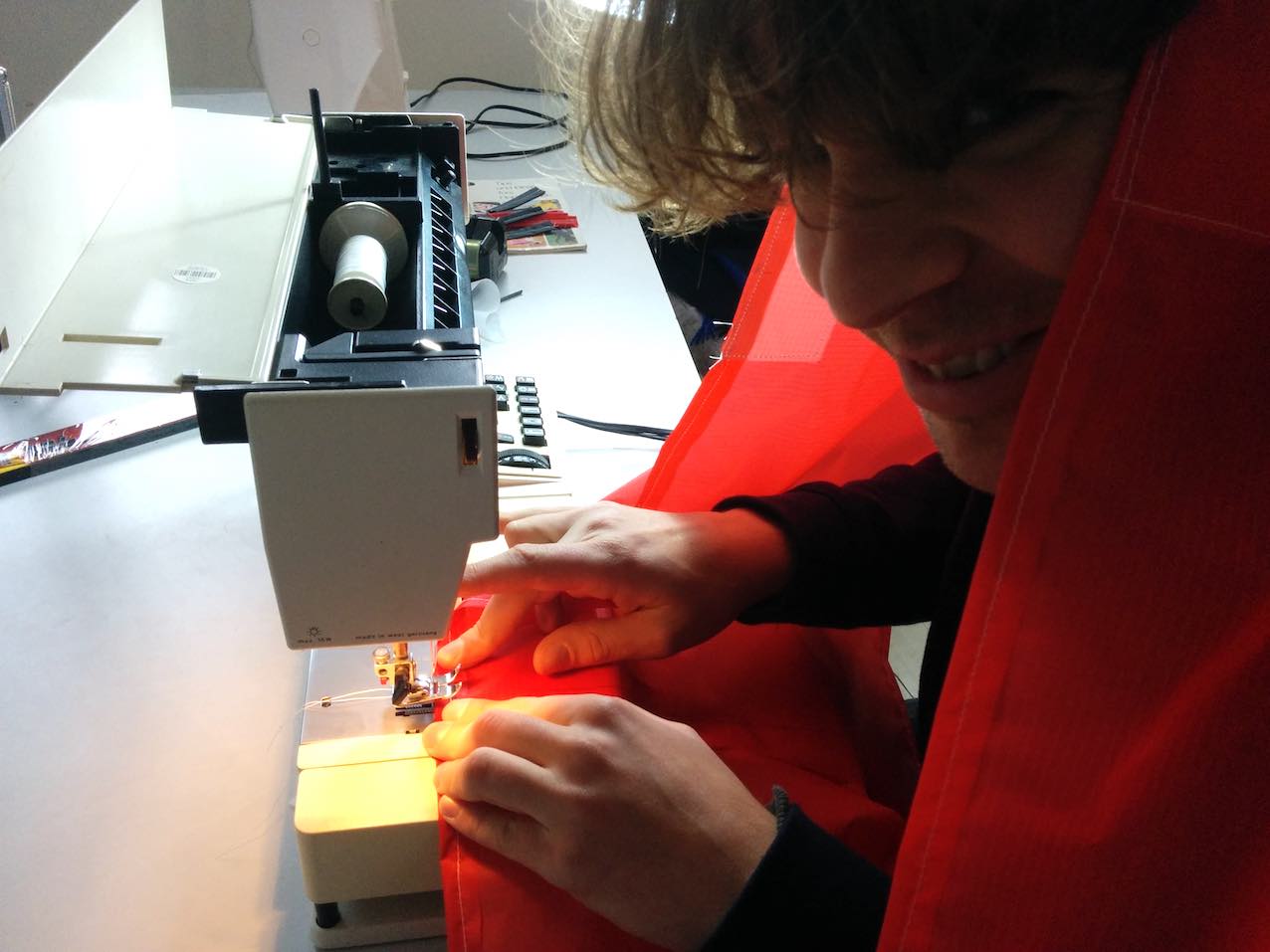
La picá del Gaviota
action during the festival Tsonami for Acts of Listening, Valparaíso, Chile, dec 10 2017
in cooperation with Nicolás Spencer and
Barbara González
Caleta Portales / Domingo 10, 14.30 hrs aprox. / $500 por persona / Paseo en barco y almuerzo incluido / Partiendo de Muelle Prats a las 13:00
-Gaviota-mar-Paul-Mercedes-Portales-Act-Caleta-Bábara-Merluza-Nicolás-comer-volar-
Sound intervention during the festival Tsonami. The audience was invited to eat fried fish with the seagulls at the port.
"fishers feed the audience, the leftovers are fed to the seagulls (as usual), which feed the audience with their sounds." (quote by Nicolás Spencer)
First you have to agree, what is a “Picá”? In Chile they call “Picá” restaurants, Fuentes de Soda or cooks that offer typical Chilean recipes, with abundant portions and at a good price. Generally they are tips that are passed from mouth to mouth, popular places, with an environment that is part of the national identity. It is simple, simple food, with all the flavor of local cuisine, since most have been cooking and refining the same dishes for many years.
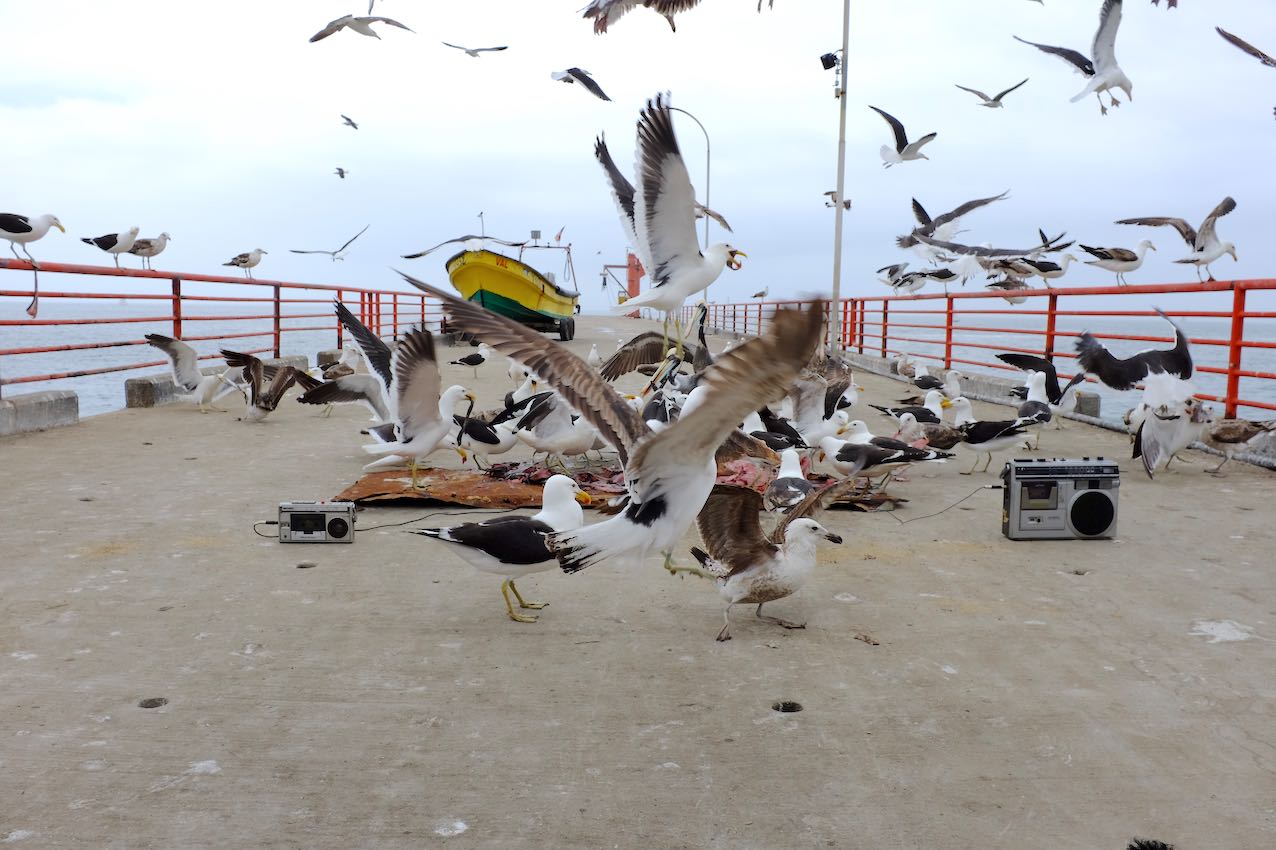
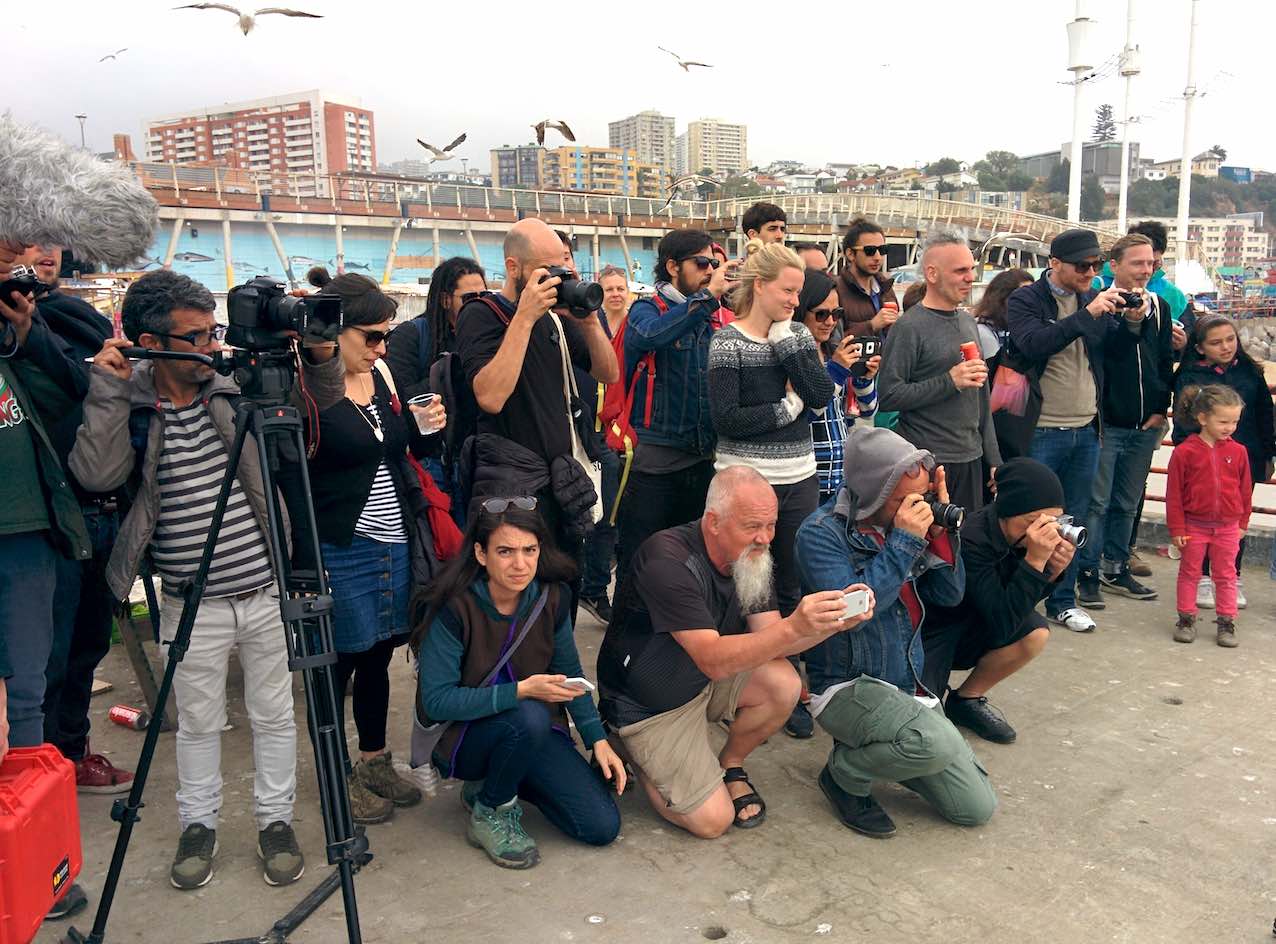

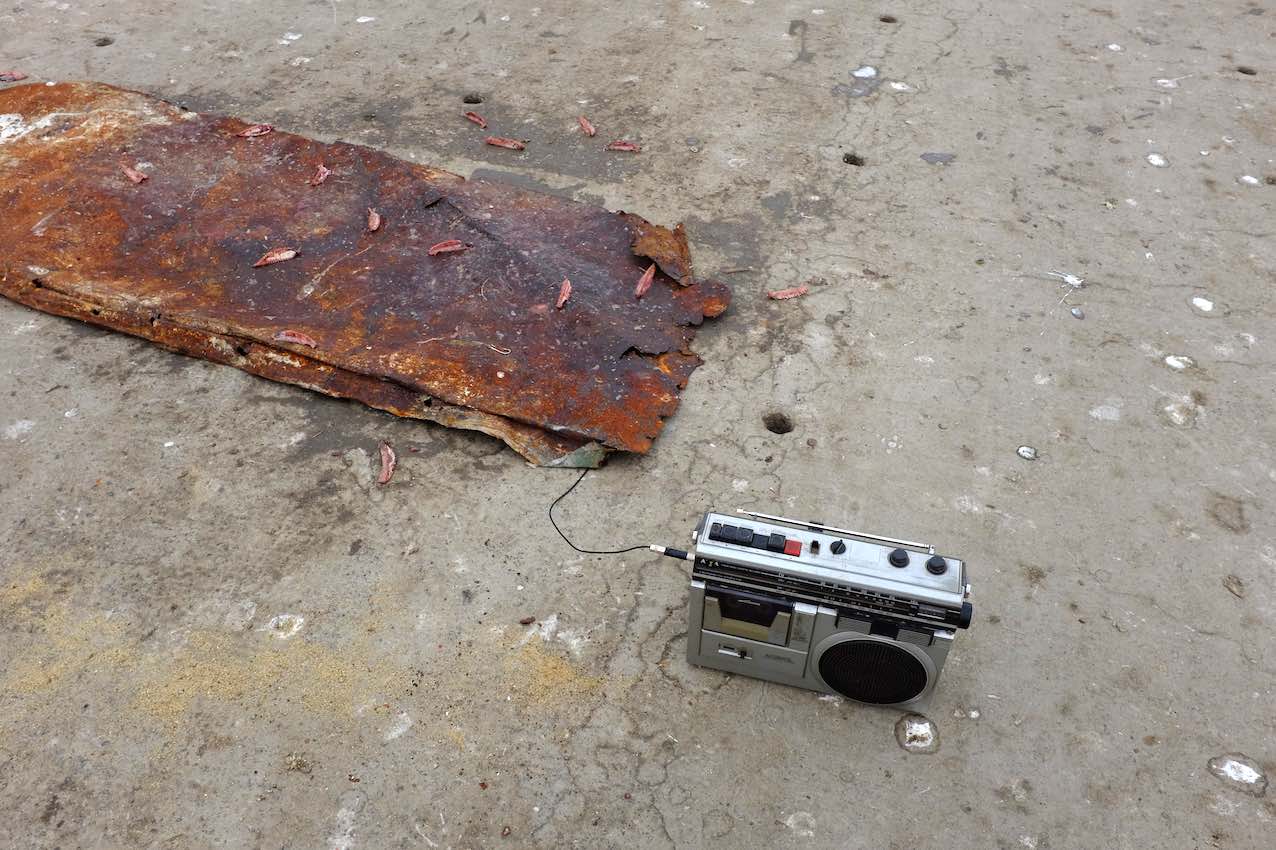
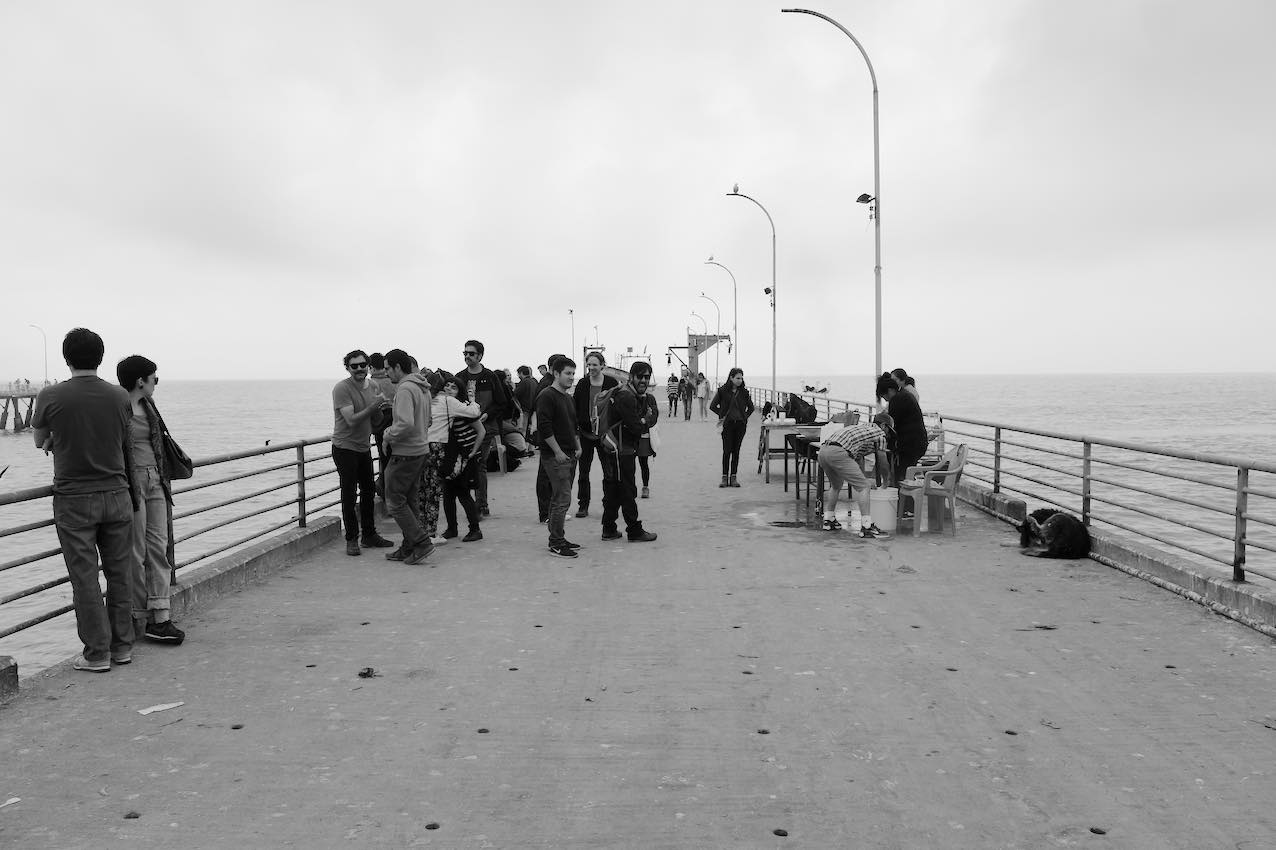
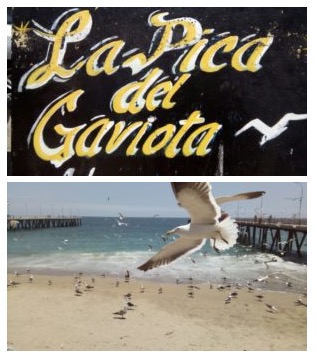
AM Land
Site Specific Installation, 2017
am transmitter, radio, cables, wood object, space blanket
Konfrontationen, Nickelsdorf[AT]
with the assistance of Sophie Dvořák
Explorations of an AM transmitter - receiver circuit and investigations of signals between centre and periphery. Portable radio receivers will play the game of chance and detect signals from close by and distant areas.
[…] The things that we've learnt are no longer enough.
No language, just sound, that's all we need know, to synchronise
Love to the beat of the show. [...]
(Joy Division, Transmission)
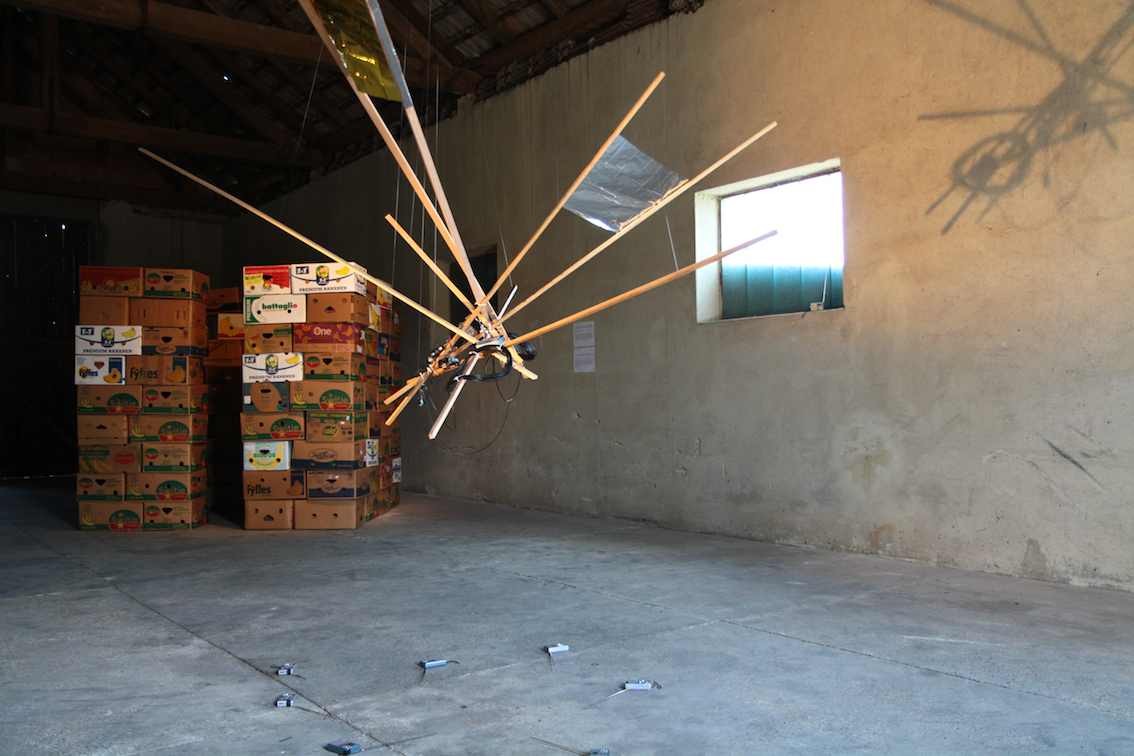
Installation view
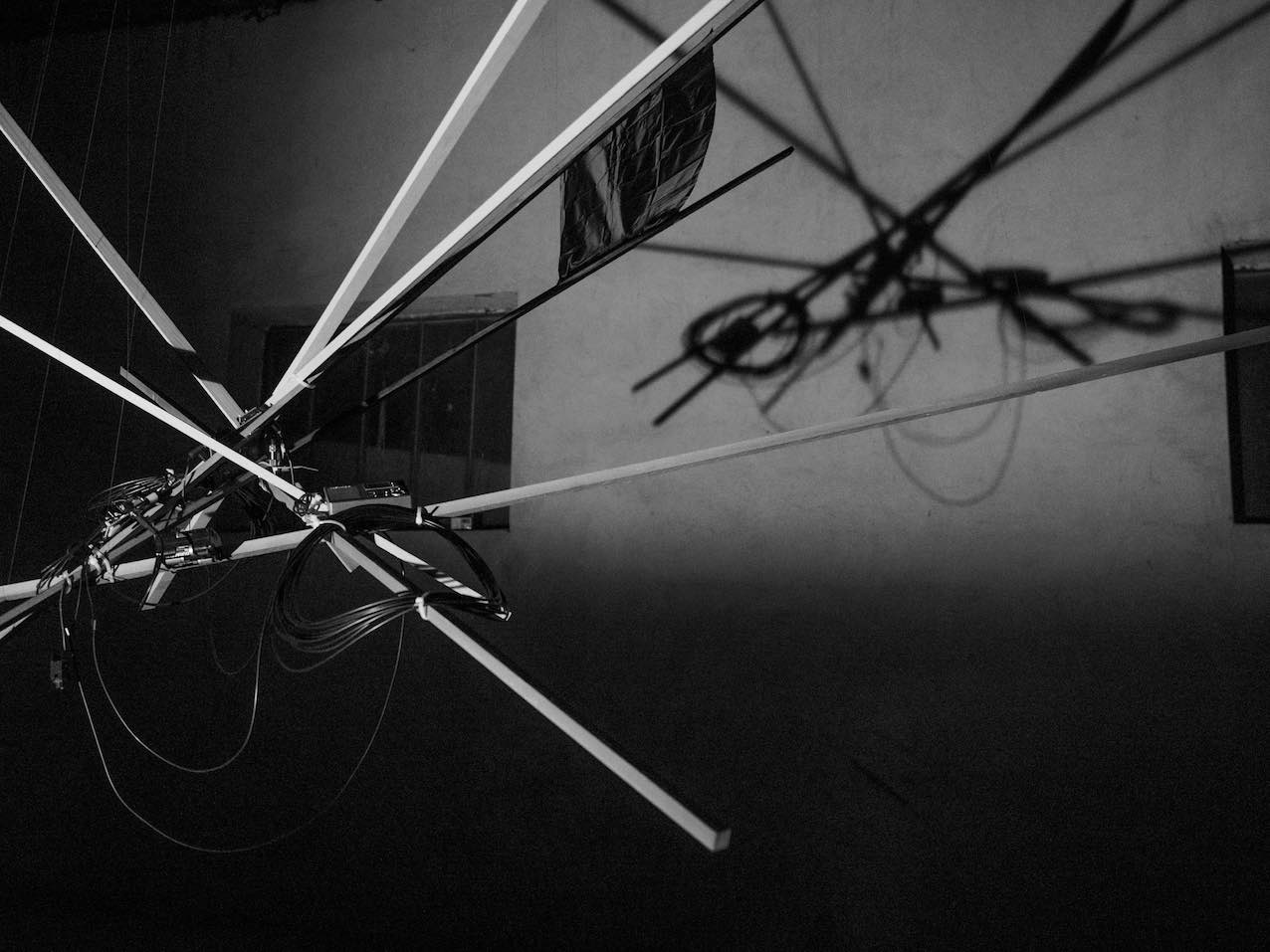
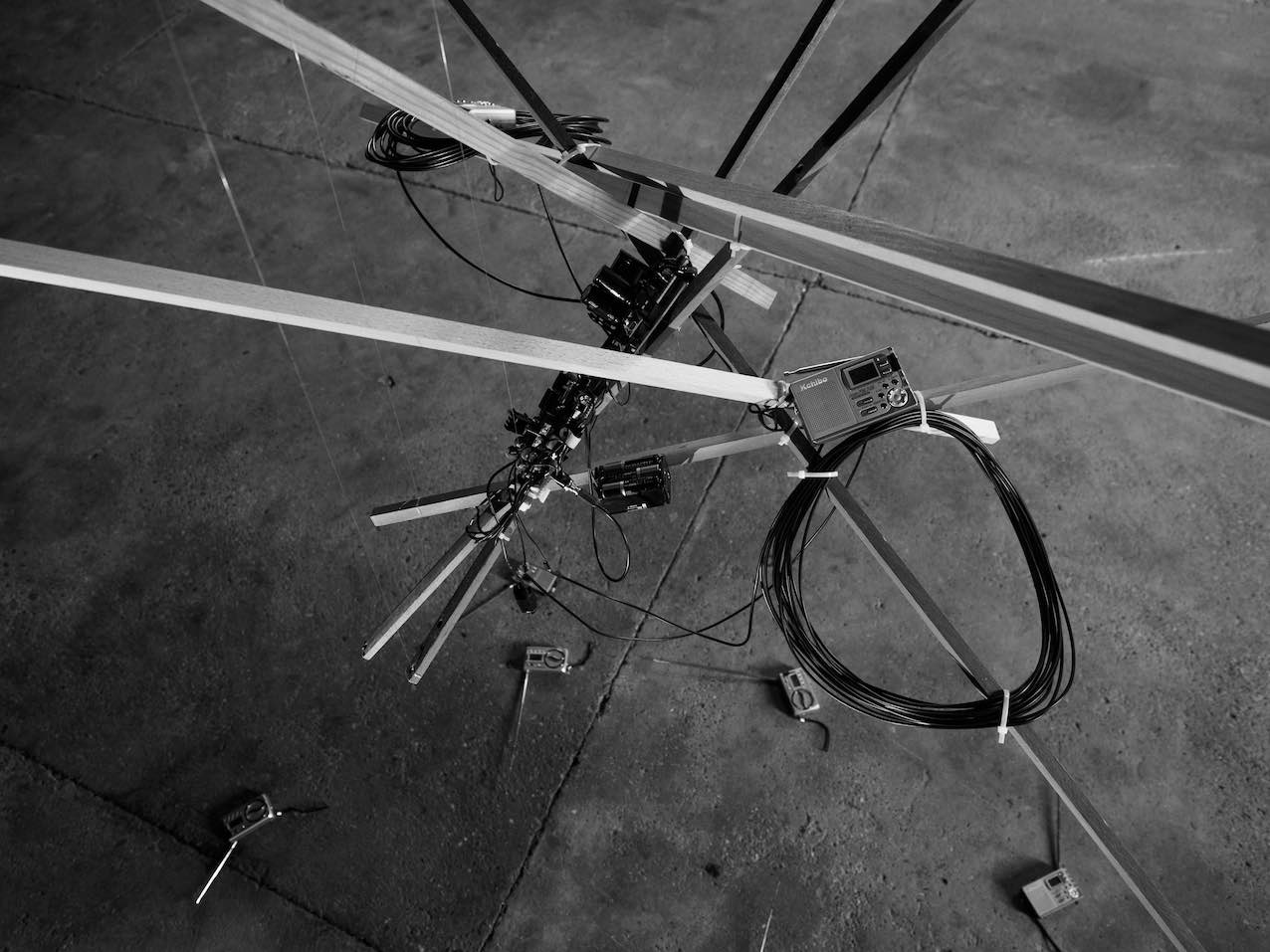 (c) photos black+white by noid
(c) photos black+white by noidAttractor
Site Specific - Light Installation, 2017
fluorescent tubes, cables, metal/wood structure, electric current
Feijiacun, Beijing[CN]
In cooperation with Ye Shangda
assistance: Hu Xinru, Chao Fu-Le
As a site specific intervention the Attractor is built in a public space, connects to its surroundings and reacts to changes in the electric field. In certain areas in Feijiacun, due to power poles and electrical substations, electric fields build up and can be detected with strip light. They are shaped by the constellations of the architectural setting. Different expansion is found on flat spaces, next to houses, near to trees or on rooftops. The sculpture is not connected to power, but lighted by the electric current it is surrounded by and detects the disturbances when people are passing. It deals with the processes happening in transitory areas and reveals signals that seem to be hidden from general perception.
Installation view Feijiacun, public space
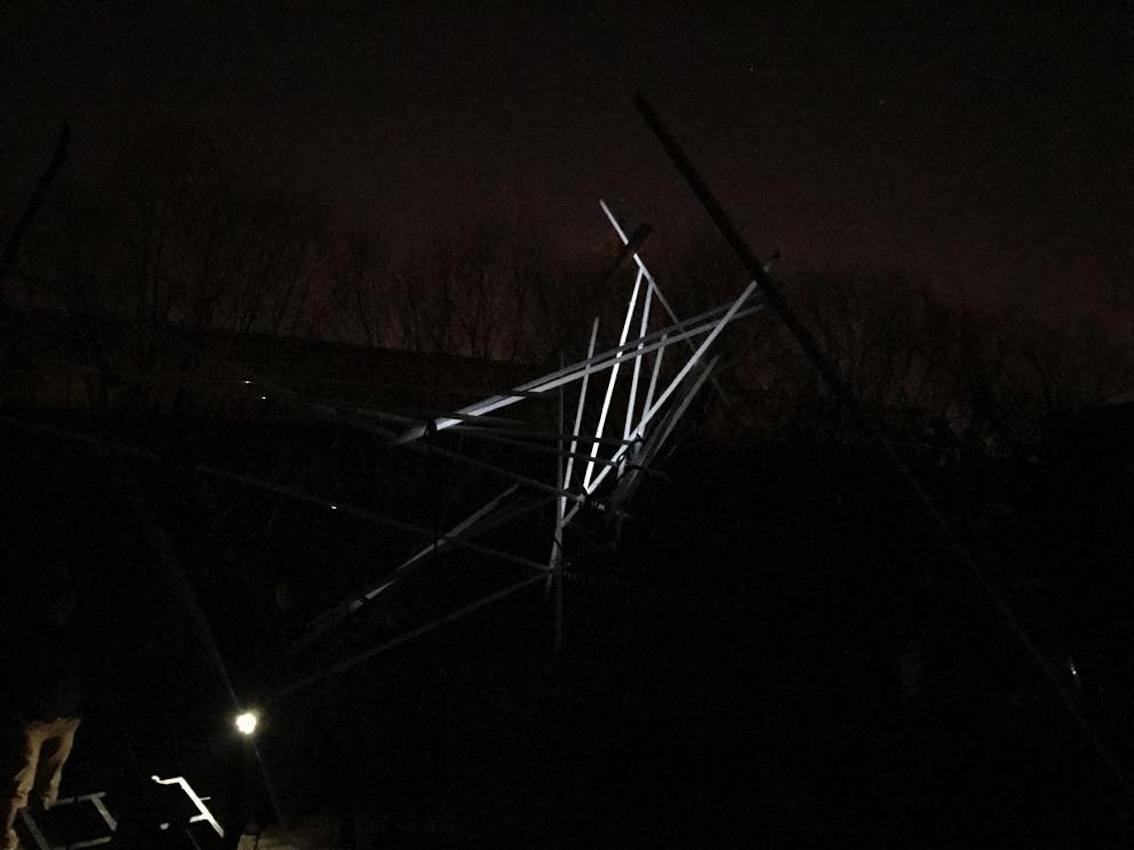
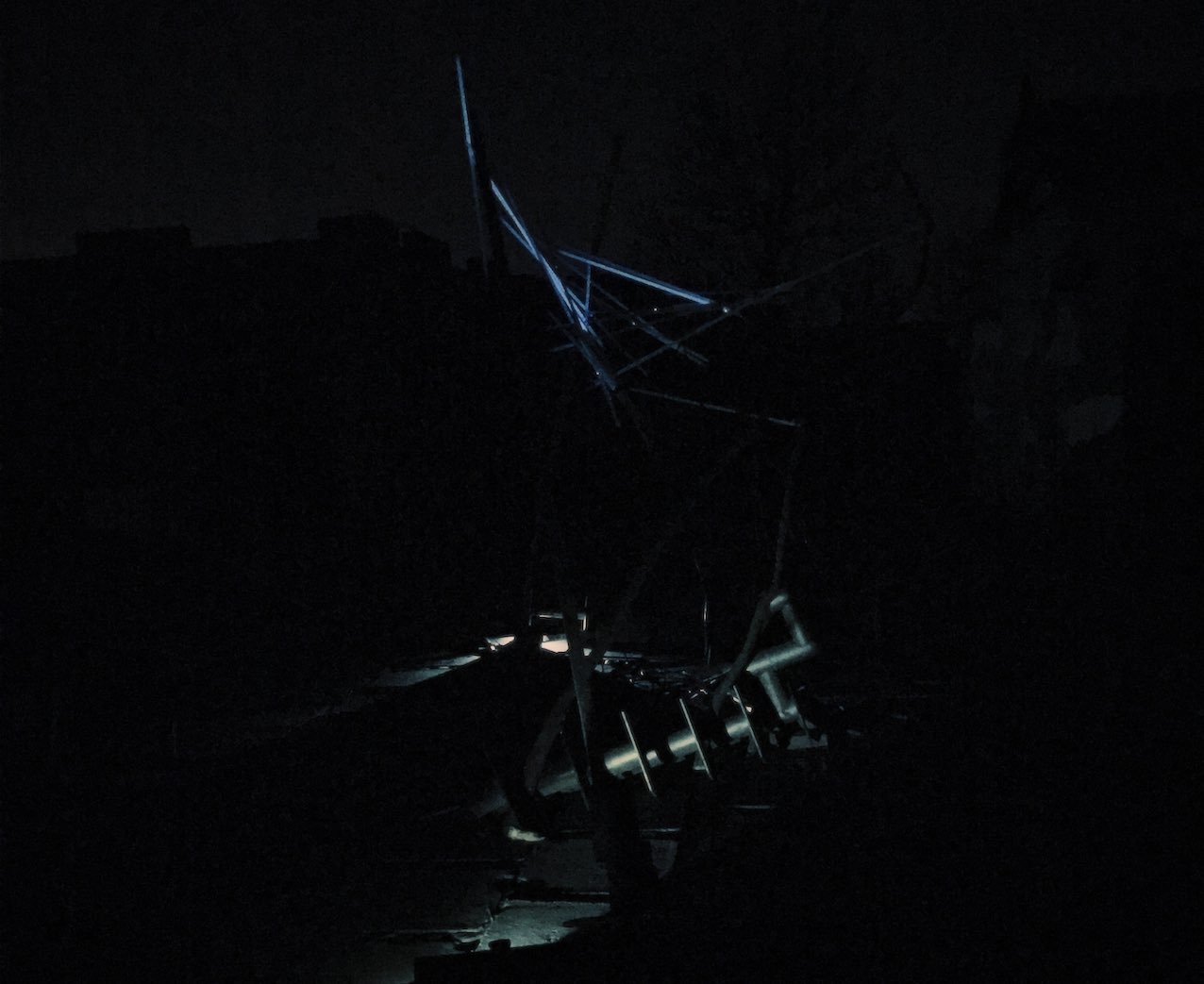
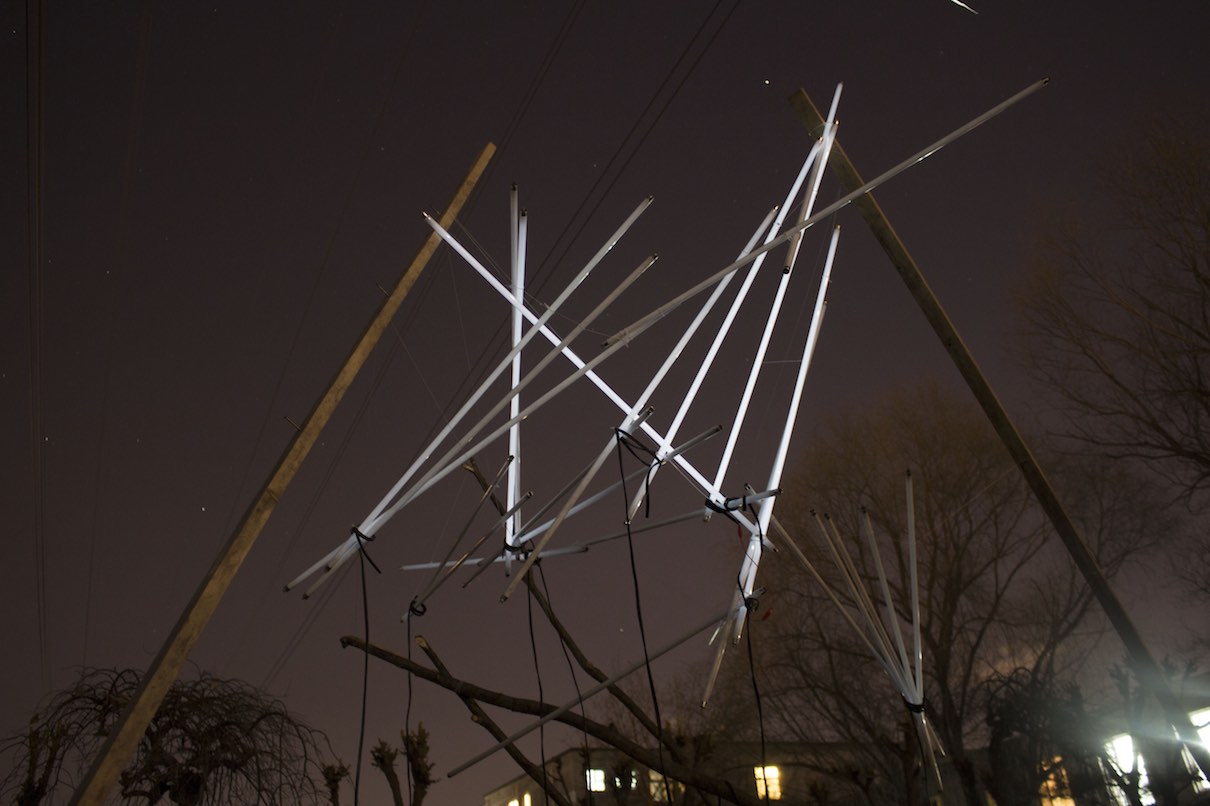
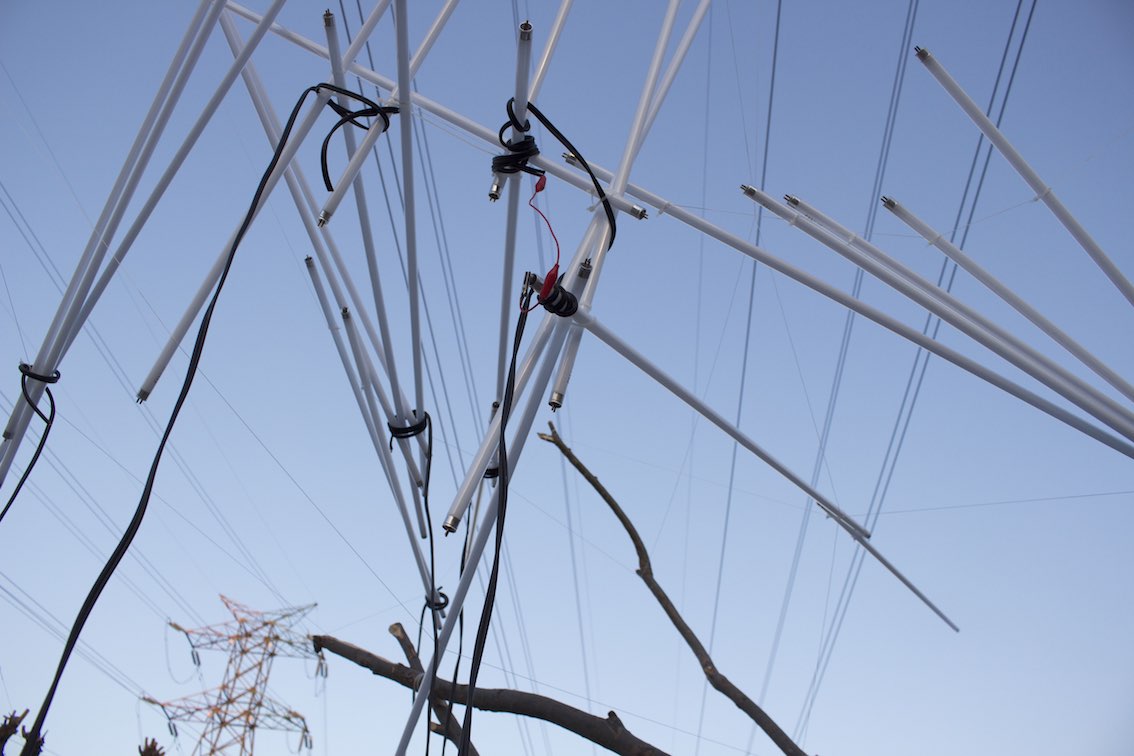
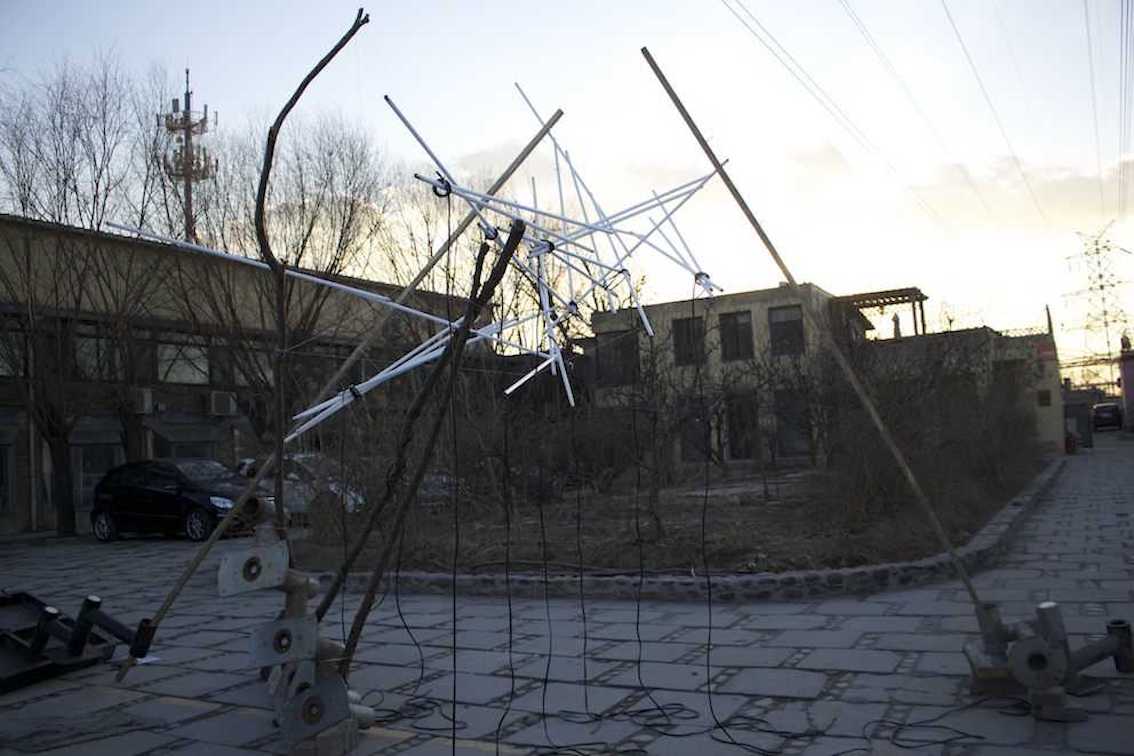
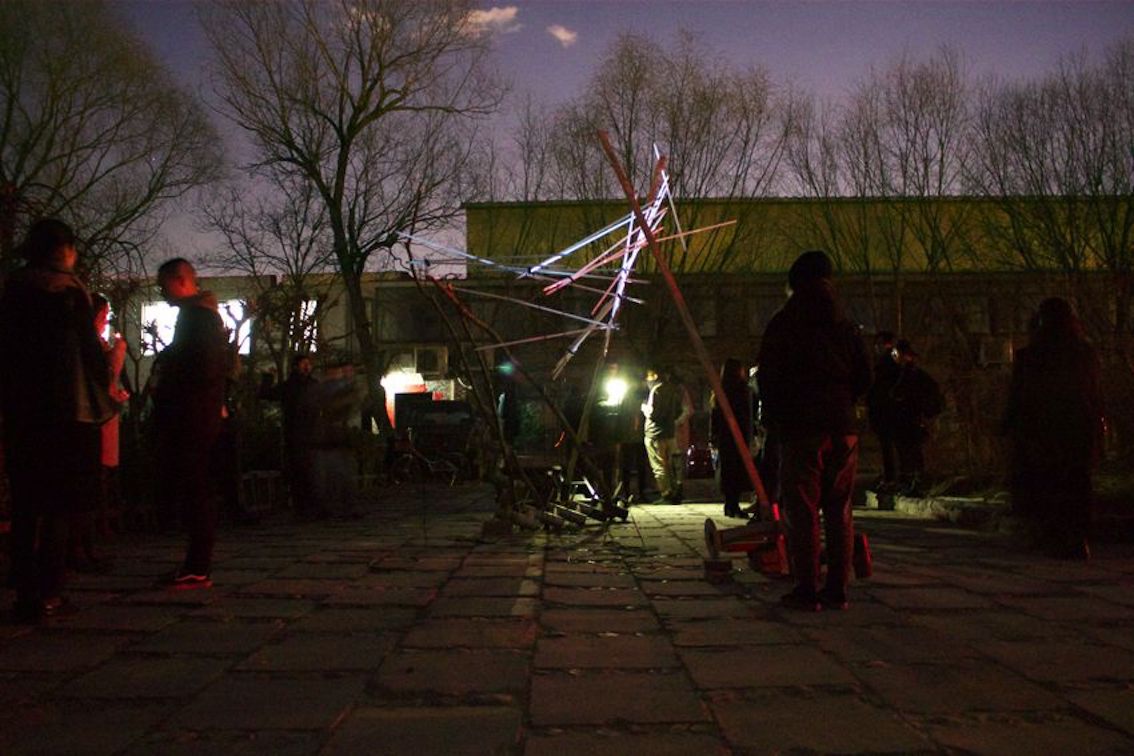

Flash
Triptychon of lost media - II, Flash, AM-Feld / Soviet Noise
Audio Visual Installations, 2016/17
radio, transmitter, electric current, camera flash, micro controller, relais, electromagnetic field
Flash is an audio-visual installation for camera flash, radio transmitter and changing electric current, shown in the last exhibition of Black Bridge artist village in Beijing, before it got abandoned due to re- structuring of the region. The flashes interfere with the electromagnetic field and thereby influence the signals detected by the radio receivers. The fluctuations of the power grid, which occur quite frequently in Beijing, push the radio transmitter out of resonance and produce an unstable field.
The project AM-Feld / Soviet Noise, is a cooperation with Alexander Felch which took place in St. Petersburg. It is the second part of the series ‘Triptychon of lost media’ and concerns the examination of emitter and receiver and explores extended techniques of sound generation and playback. The theme ‘emitter-receiver’ is the conceptual theoretical framework for the work series, but also correlates to the applied techniques of how sound and material are shaped. For ‘AM Field / Soviet Noise’ a radio signal was created to transmit 30 minutes of empty audio tapes, produced 1989. Portable radio receivers where supplied to detect the signals of the audio tapes from the ‘soviet environment’. The work is referencing russian protagonists like Velimir Khleb- nikov (author of the futuristic essay ‘radio of the future’), Alexander Stepanovic Popov (pioneer of radio technology) and UVB-76 (a short wave transmitter, sending a buzz tone since ~1975). There are several portable radio receivers in the room, whose position can also be changed by the visitors. The installation is based on the idea of the Acousmonium, a multi-channel loud- speaker sound system developed by Francois Bayle in the ‘Groupe de Recherches Musicales’ for Radio France 1974. But in contrast to the concept of a composition for fixed loudspeakers, the visitors, equipped with a portable radio receiver, are the players of a ‘loudspeaker orchestra’ themselves. They can move with the radio receivers in the zone of transmission. Several short- range transmitters, all at the same transmission frequency, are positioned at different locations in the room. Each transmitter covers a specific area, which can be received separately, but also modulated by possible interferences. The various transmission distances can be monitored by the movement in the space, thus resulting in a constantly changing configuration.
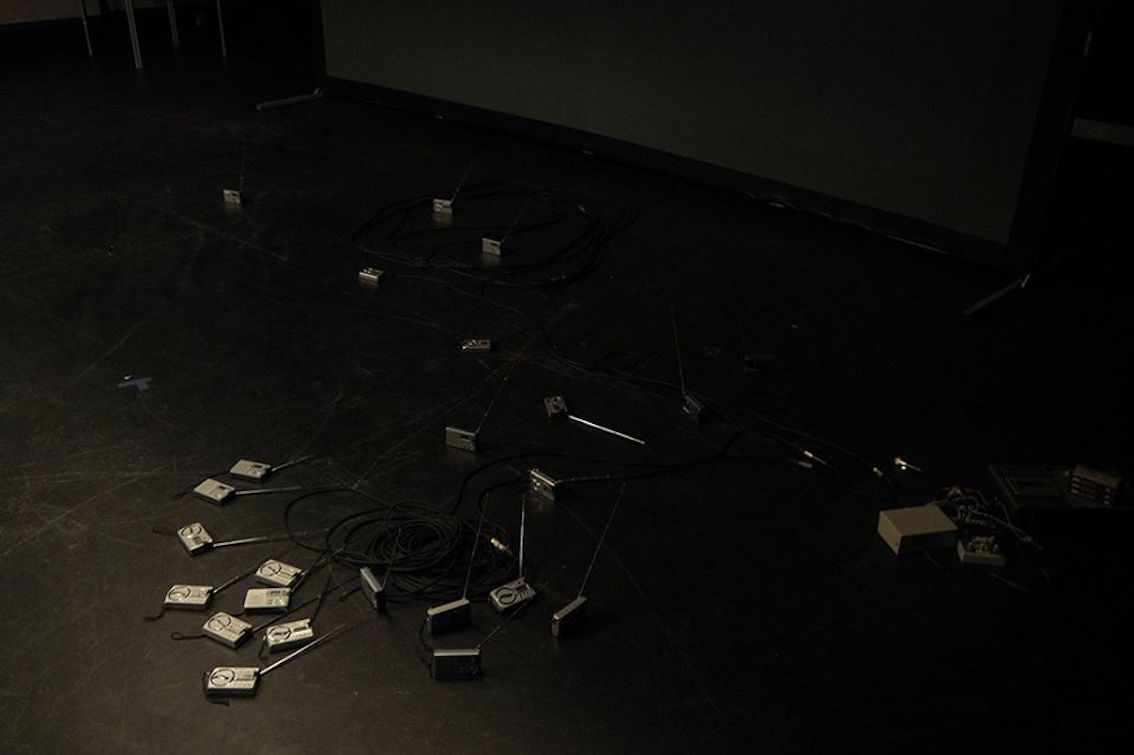
Installation view: AM-Feld / Soviet Noise, Alexandrinsky Theater New Stage, St. Petersburg
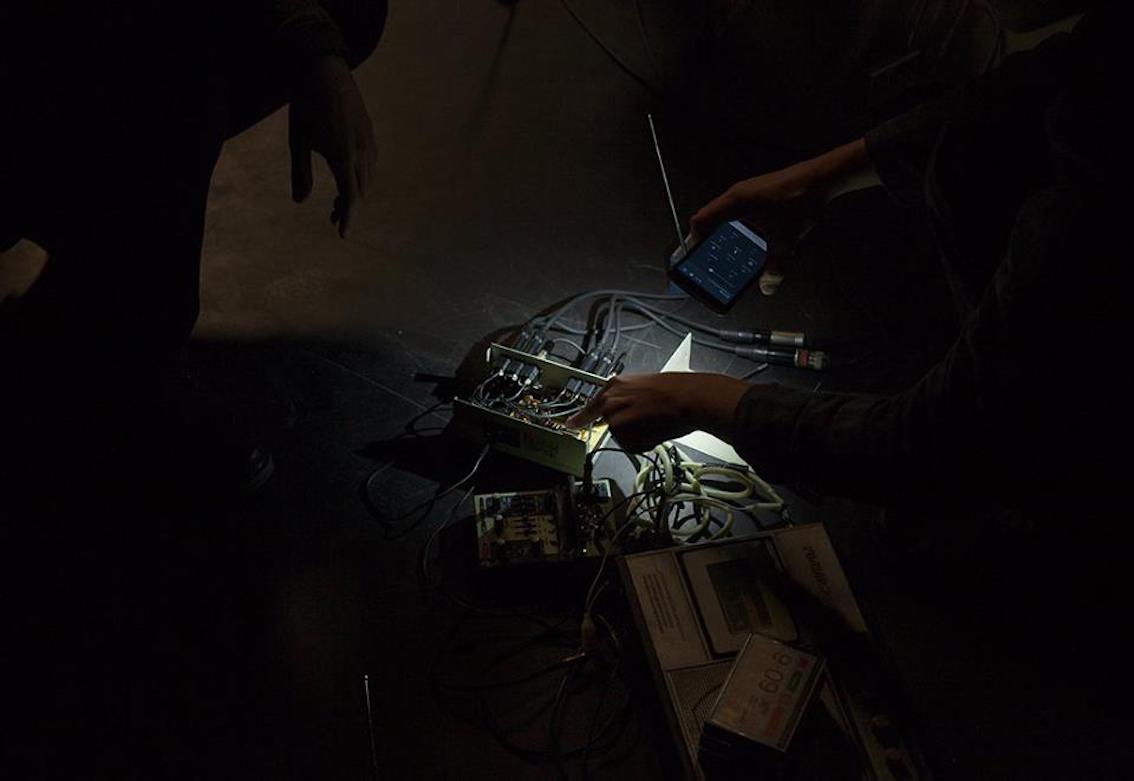
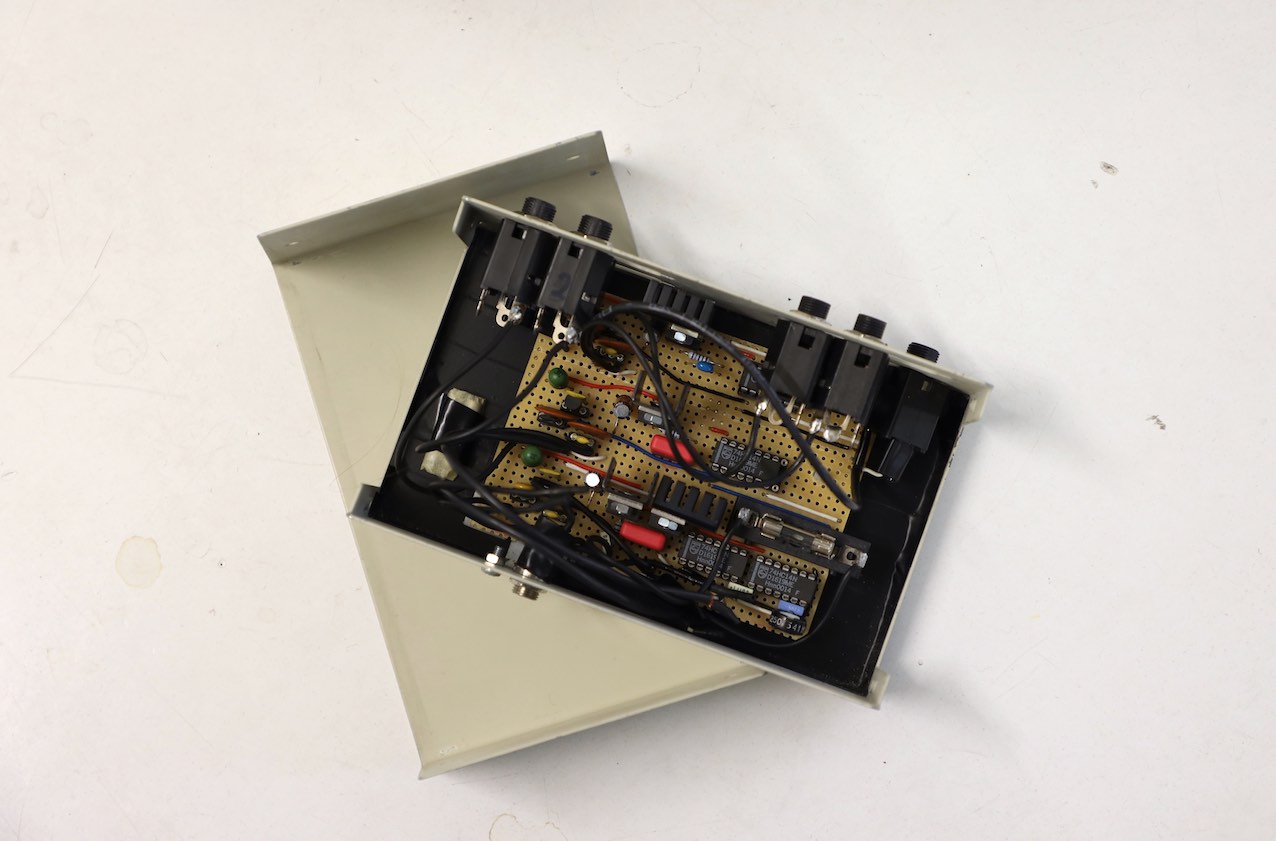
AM Transmitter 1000kHz
Installation view: Flash, Black Bridge Village, Beijing
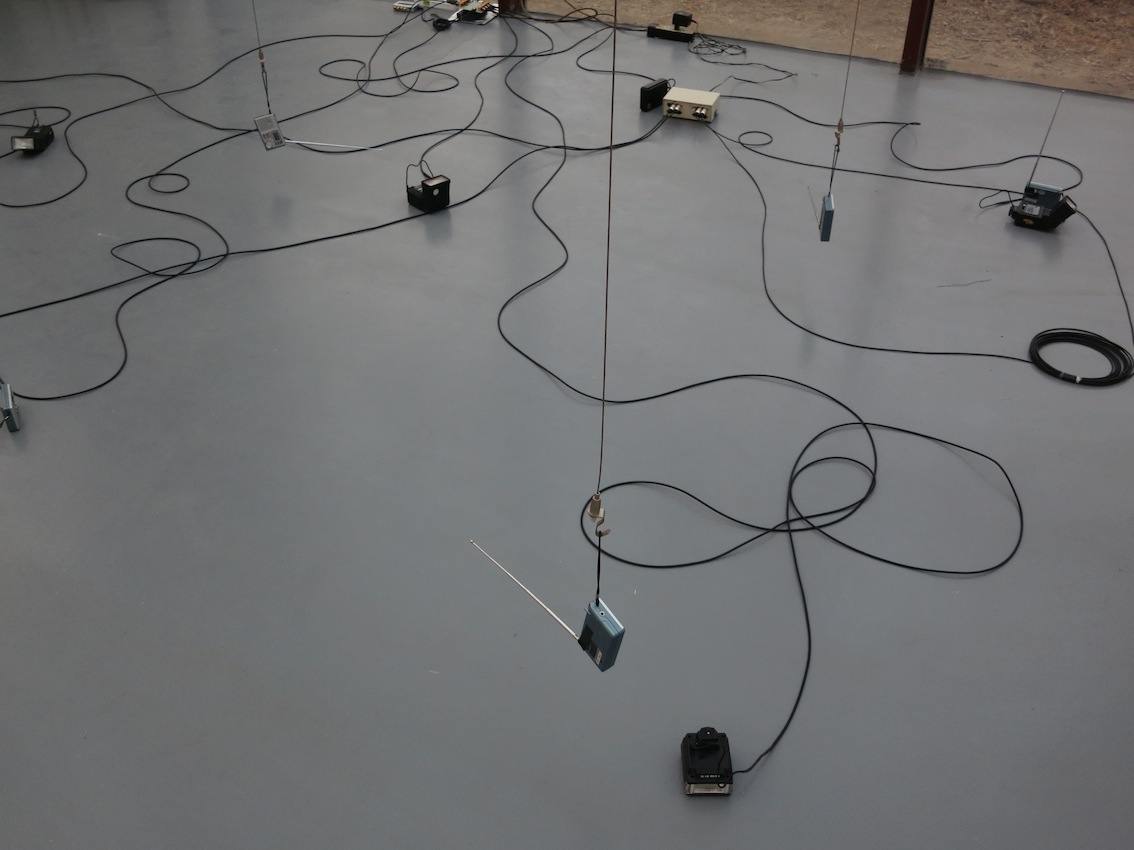
Transient Hole (Variations)
several contributions to the curatorial/artistic Transient Hole (Variations)
project proposed by Alexander Felch
Kanaldeckel
found / removed object, 2017/18
cooperation with Karl Salzmann
for the exhibtion Transient Hole at Zentrale, Vienna
Kanaldeckel is referring to an action that is needed to explore a different layer within the urban landscape, and could stand for an entrance point moving to another dimension in space. Following the slogan: “Unter dem Pflaster liegt der Strand”, a manhole was transferred from its original position, to create a gateway to stroll around for some time.
ST
sound-performance, 2018
After hacking into the radio frequency of the Mercedes Benz car, available at Antwerp gallery fp24, this mobile soundsystem was used to diffuse hidden frequencies, HF-and VLF-signals, and modulated low oscillations.
live concert
Berlin, 2018
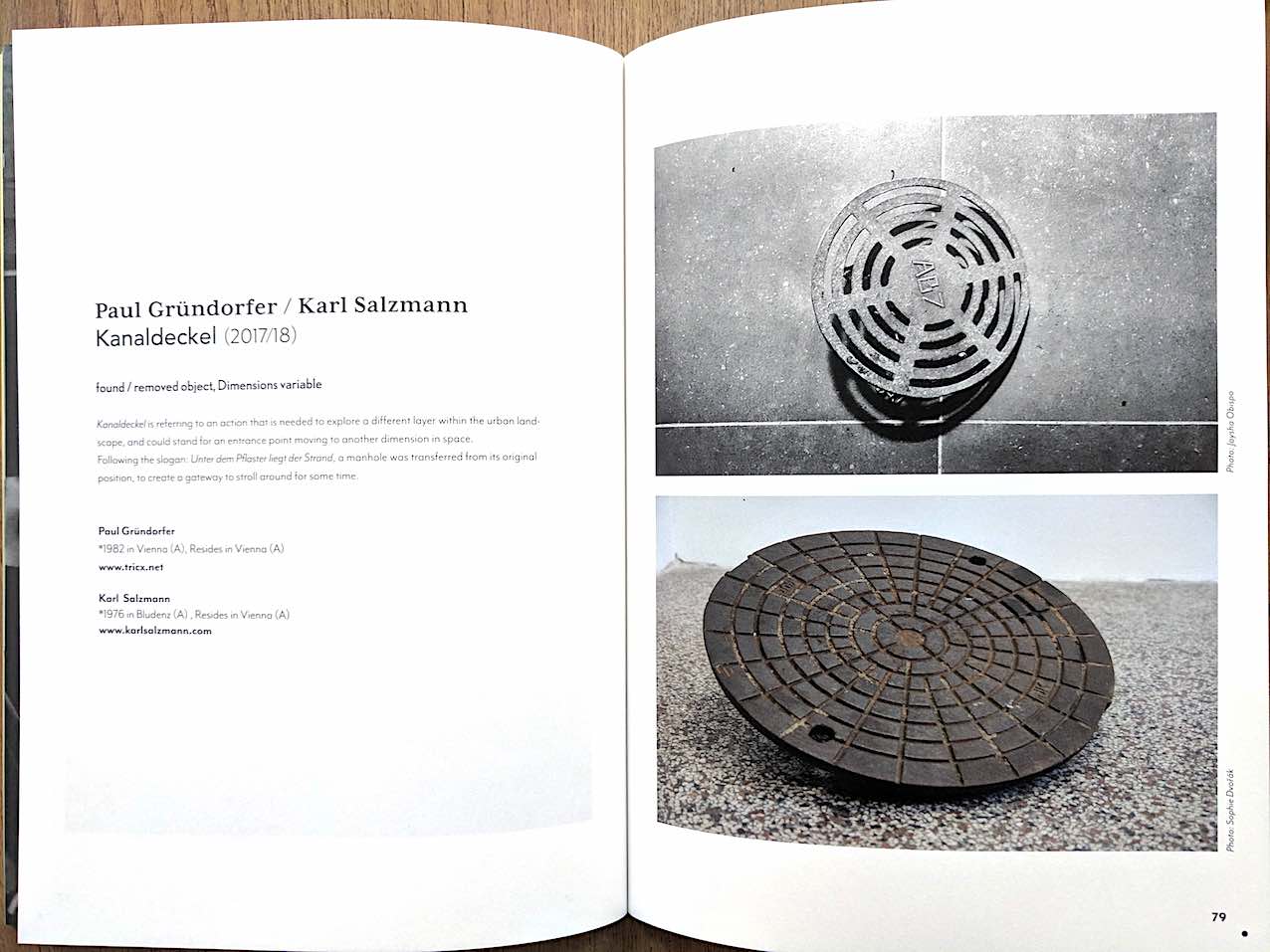
Kanaldeckel
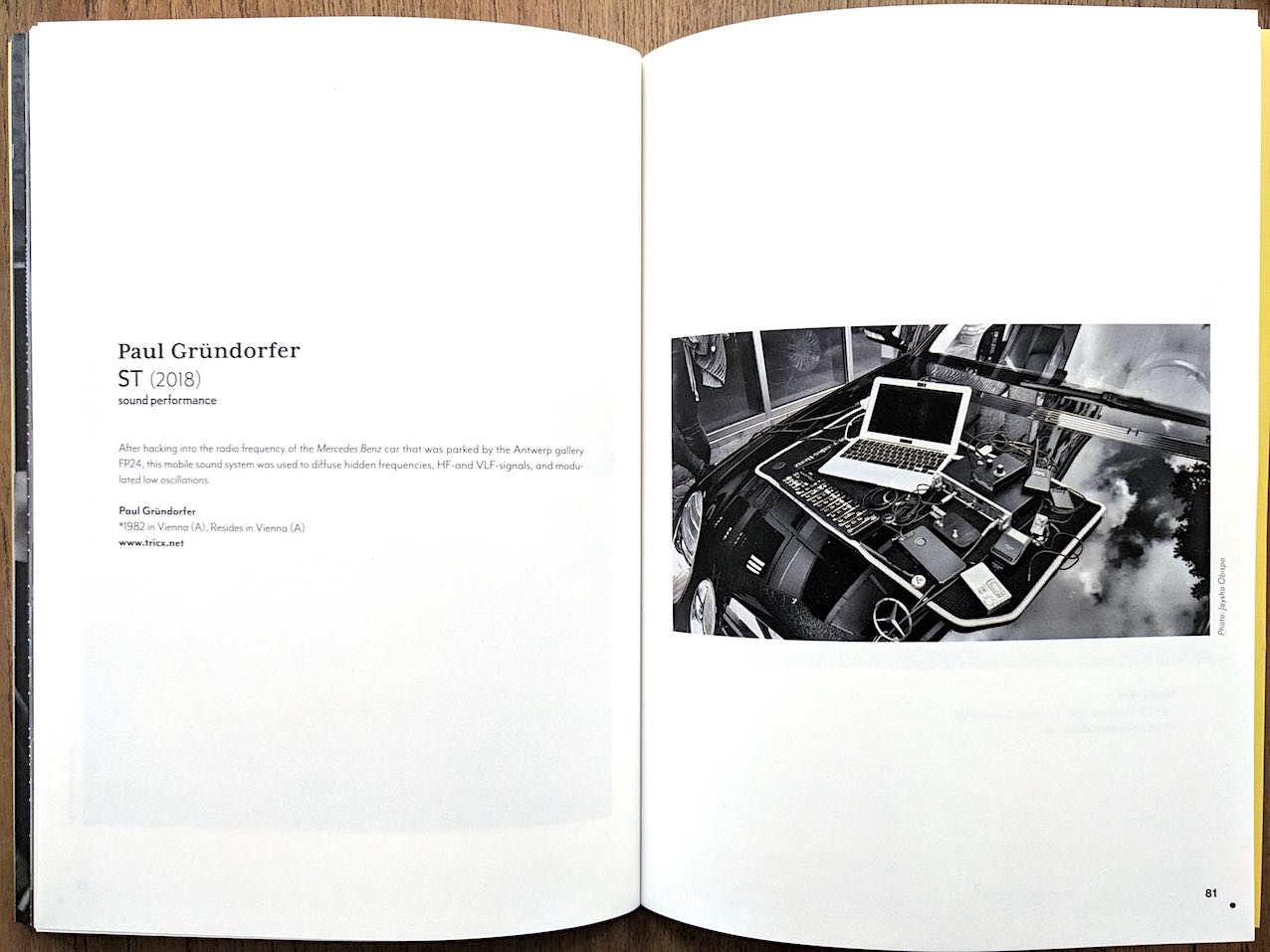
ST
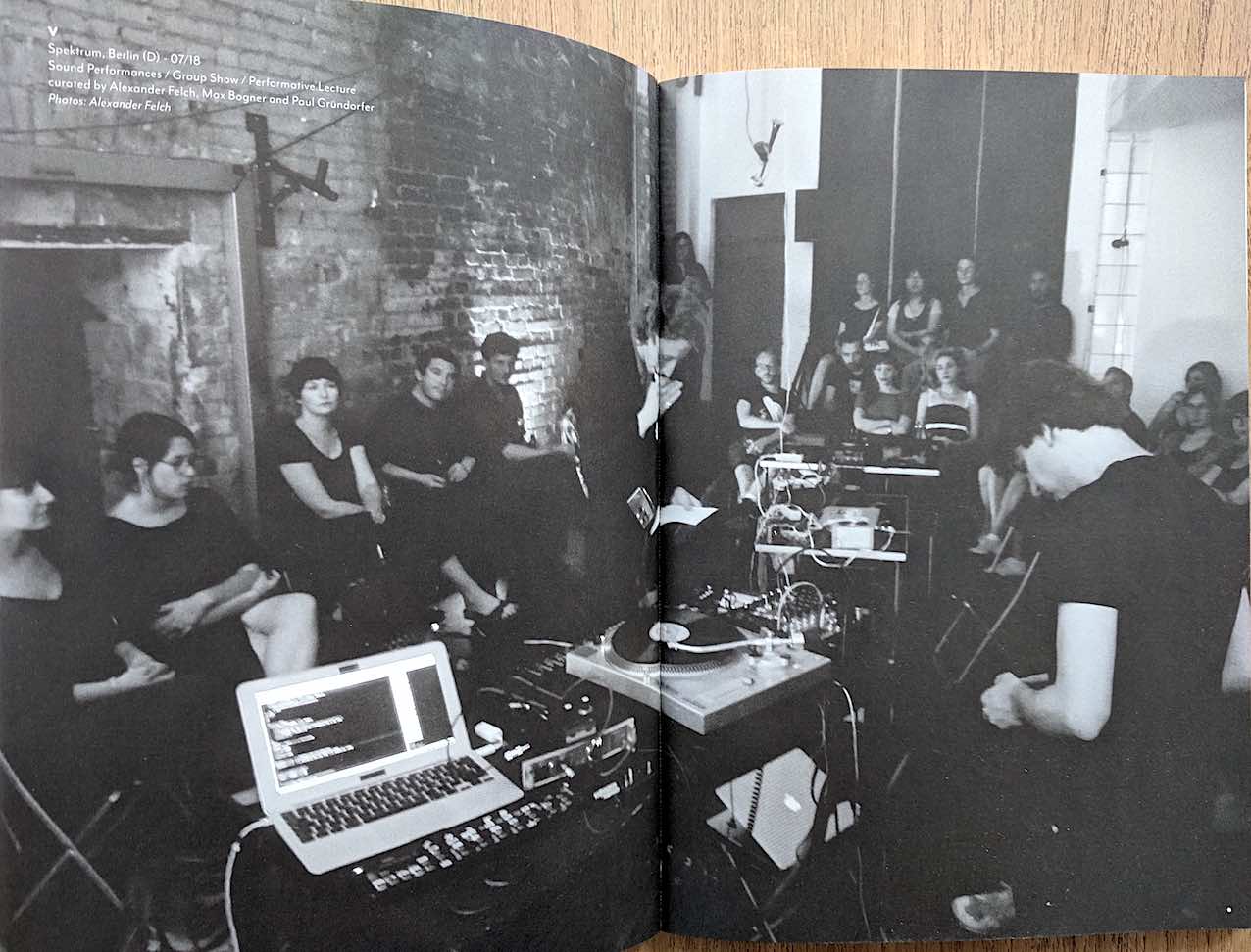
live concert
Triptychon of lost media - I
Sound - Installation, 2015/16
metal plates, contact microphones, transducers generate feedback.
in cooperation with Christoph Freidhöfer
This is the first part of the series ‘Triptychon of lost media’. It deals with the examination of emitter and receiver and explores extended techniques of sound generation and playback. The theme ‘emitter-receiver’ is the conceptual theoretical framework for the work series but also correlates to the applied techniques of how sound and material is shaped.
Metal plates are used as tone generators as well as loudspeakers due to feedback that emerges from applying transducers and contact microphones to the surface. Due to the more or less chaotic vibration of the metal sheets and low amplification, the spectrum moves between the sound of fanfares and thunder. The installation deals with the propagation of sound in space and feedback between transmitter and receiver.
The project was developed for
moe, Schaukasten XII
and took part at the sound-festival
unsafe+sounds
in June 2015.
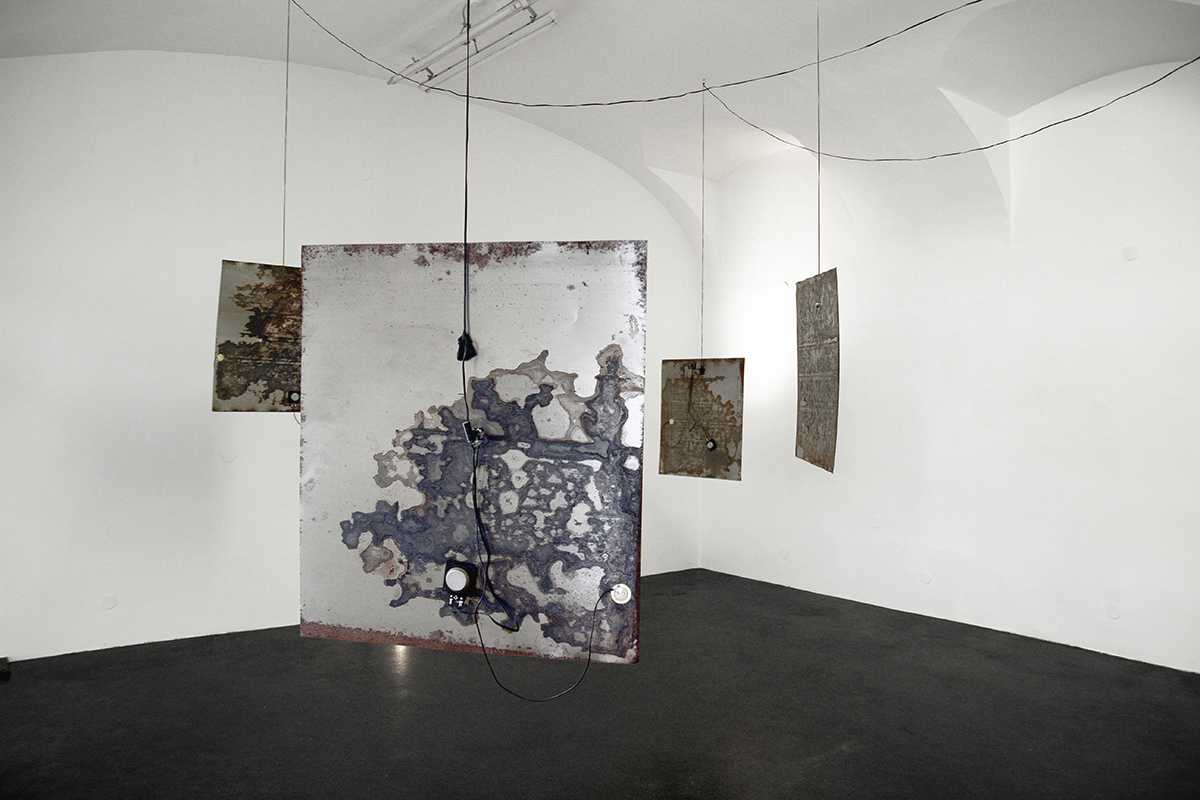
Installation view: MemphisMemphis
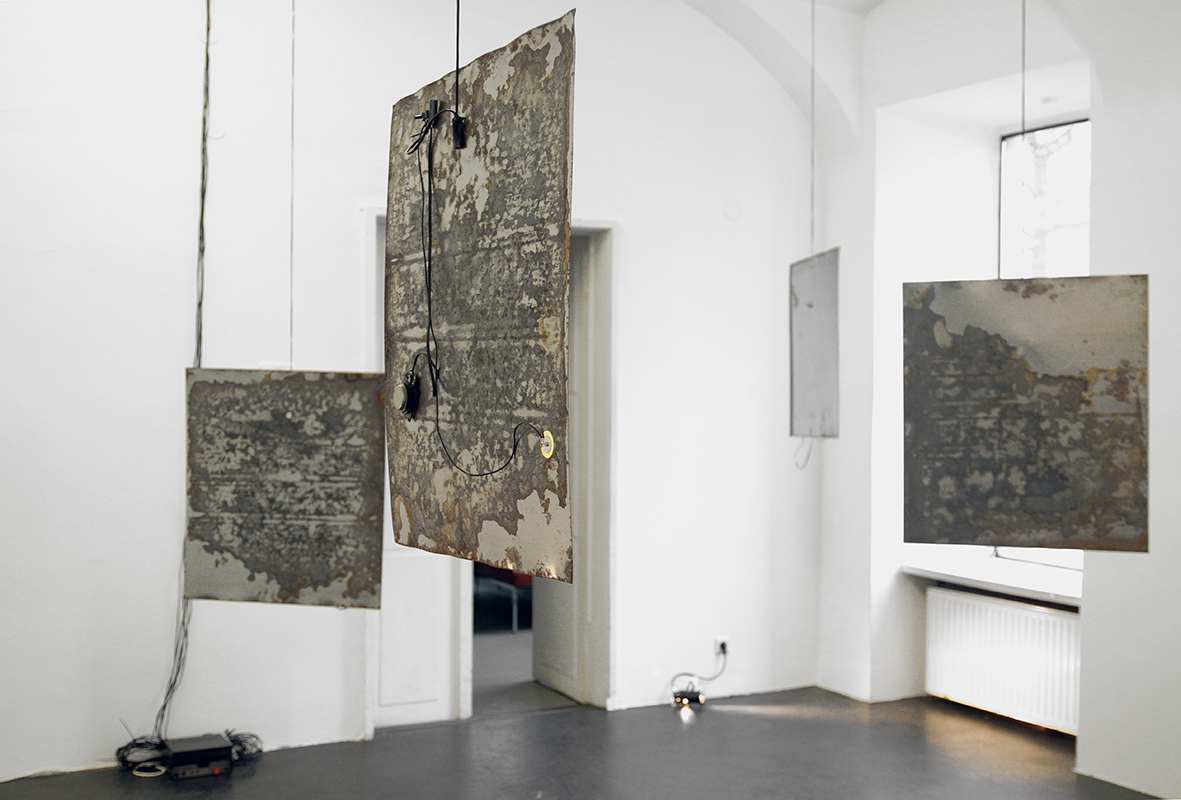 (c) Florian Voggeneder
(c) Florian Voggeneder
Installation view: moe, Schaukasten XII
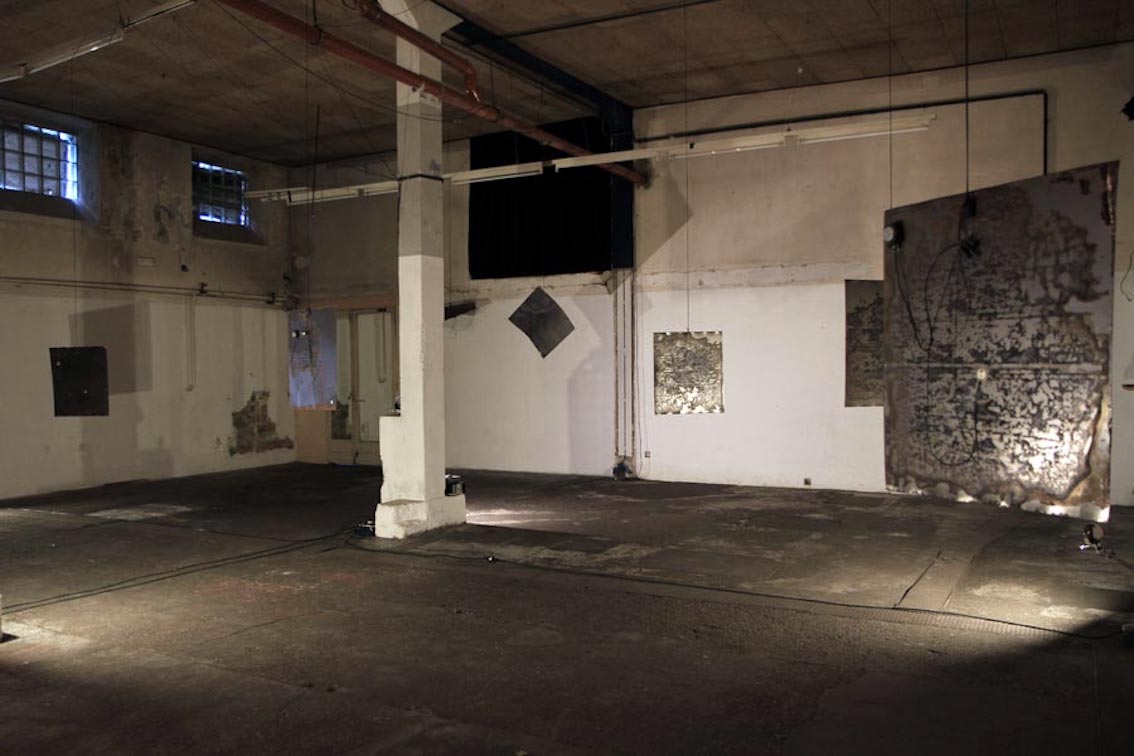
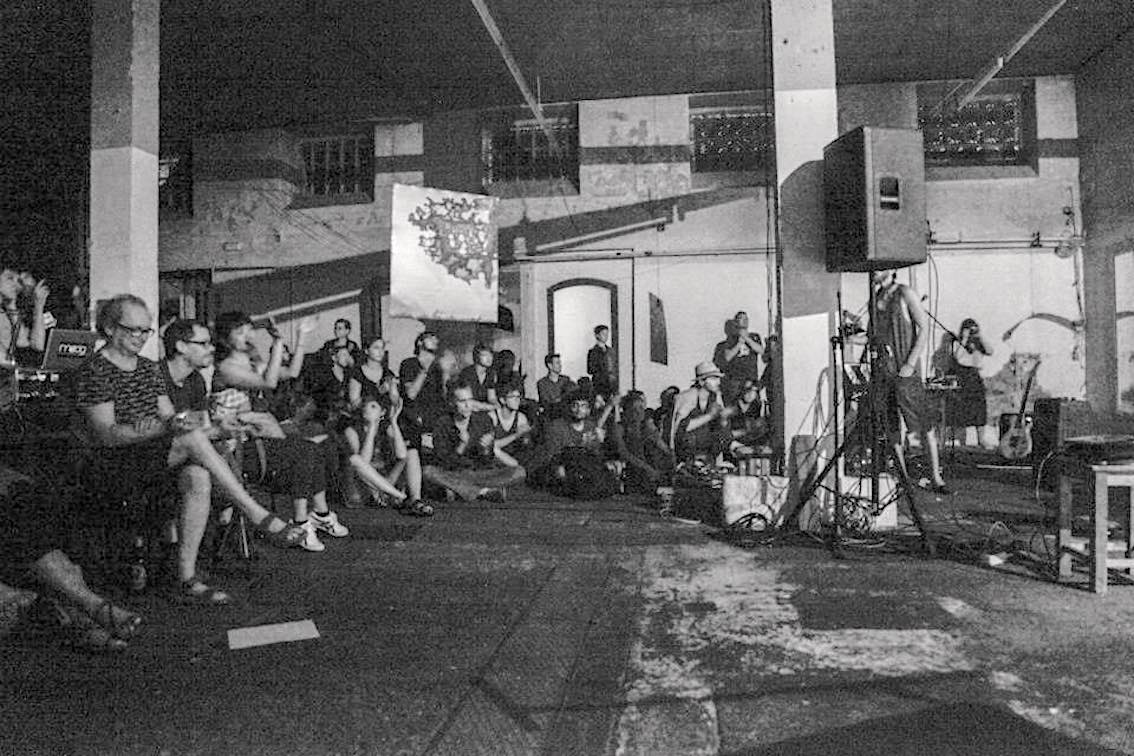
animal-voice-orchestra
live performance / since 2016
amplifiers, filters, analogue modules, real-time audio software / Supercollider / Linux, contact microphones
Electronic circuits are interconnected to cause semi-natural entities, autonomous organisms, half-animals. The electronic machine functions as the mimesis of an organic world, voice and articulation is generated through loops in feedback networks. Continuous ecosystems, archaic animal-noise-transmission, onomatopoeia.
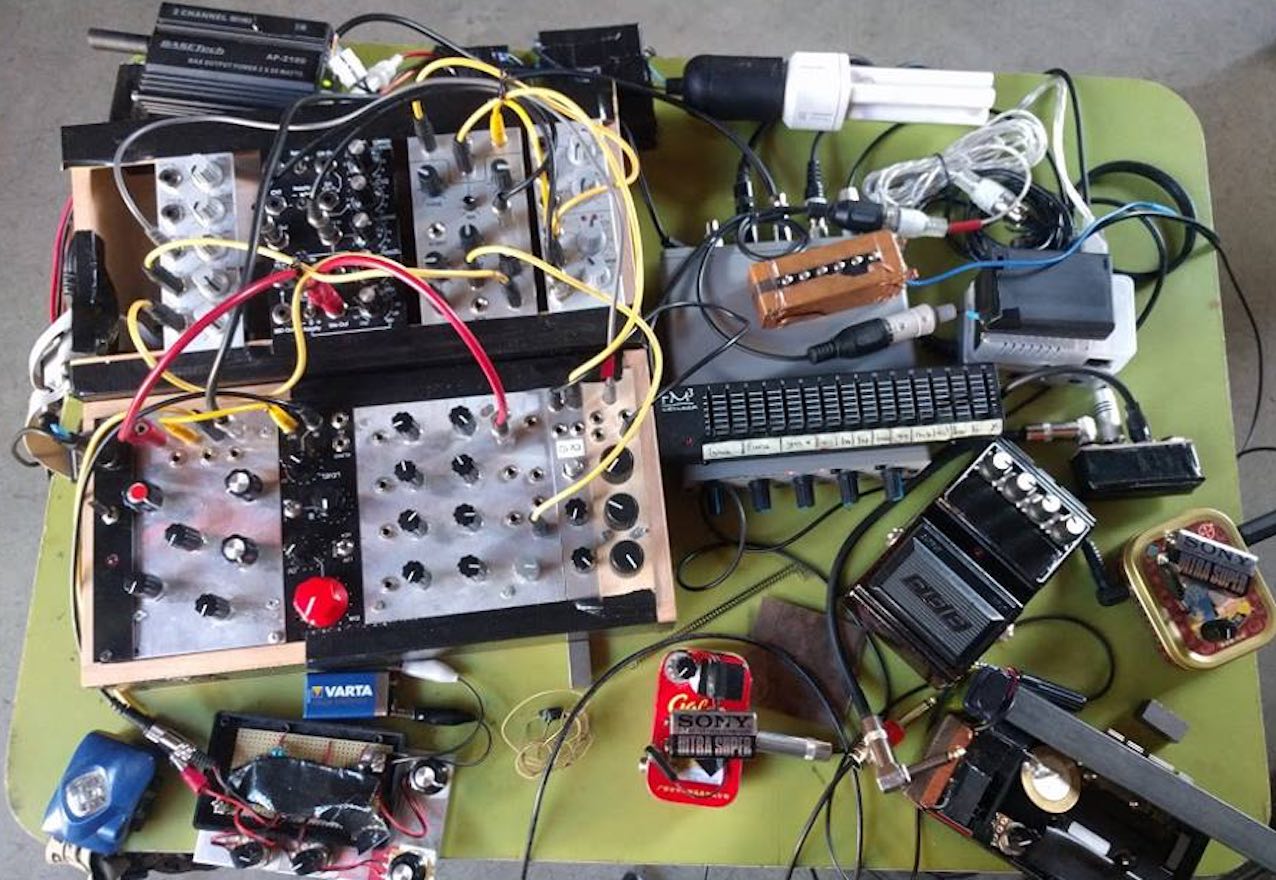
Audio - Visual Performance / Faux Terrain
microscope camera, lichens / organic material, real-time audio software / Supercollider, projektor, soundsystem, 2015/16
in cooperation with Claudia Larcher
- investigation and interaction with audio-visual material. Fragments of organisms such as lichens or tree bines and geological samples of a collection compiled by Claudia Larcher in the border region between Europe and Russia, on the Lithuanian peninsula Neringa, are categorized according to an abstract cartography. The material is re-arranged with the help of microscopes, contact microphones, coils, camera airbrakes, thus surveying the boundaries of scientific, geographical or geological aspects in a different context.
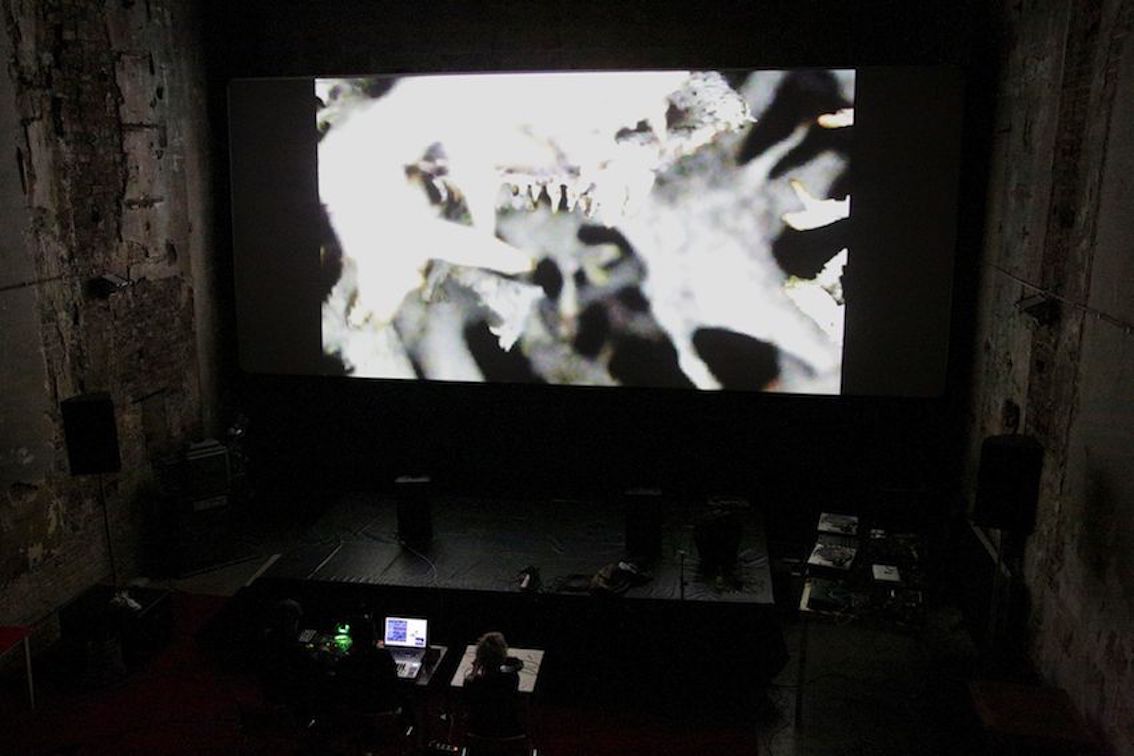
Ottos Mops
Speech - Intervention - Animal, 2013 - ongoing
loudspeaker, parabolic microphones, micro controller, motor
in cooperation with Christoph Freidhöfer
The robot moves around the exhibition space, orienting itself based on the events, records the speech of other visitors and articulates clever sayings. Using its two parabolic microphone ‘ears’ with the help of the shielding function of the foam ‘hairstyle’ it listens to the most interesting events and moves in direction to where it suspects appealing things to happen. There the robot takes on its journey, remembering snippets of conversations. Otherwise it is striking sayings like ‘the most popular occupations for men and women’ or a quote from ‘Alte Meister’ by Thomas Bernhard.
Pachinko
Sound - Installation, 2011/12
photocells, micro controller / arduino, real-time audio software, loudspeakers
Pachinko is played by more than 30% of the Japanese population. It is based on the coincidental spreading of Pachinko balls hitting certain positions, which lead to winnings. A peculiar feature in Pachinko game halls is the volume and the chaotically fluctuating sound. With this automaton the sound of the surroundings and the Pachinko itself is recorded, triggered, generated and manipulated in realtime without the use of prerecorded sounds (except one tribute-soundfile). Controlled by sensors, the Pachinko becomes an uncontrollable and absurd interface, as you never know what the machine will do next.
Undefined Falling Objects
Film - Installation, 2006
super8-loop (3mn10)
The concept for both Super8 Film and Installation settings was developed and realised for one of the rooms of the bunker Flakleitturm Arenbergpark in Vienna.
The film loop shows permanently turning maple seeds, in density and speed variable. The projection can be seen from everywhere in the room on a transparent canvas.
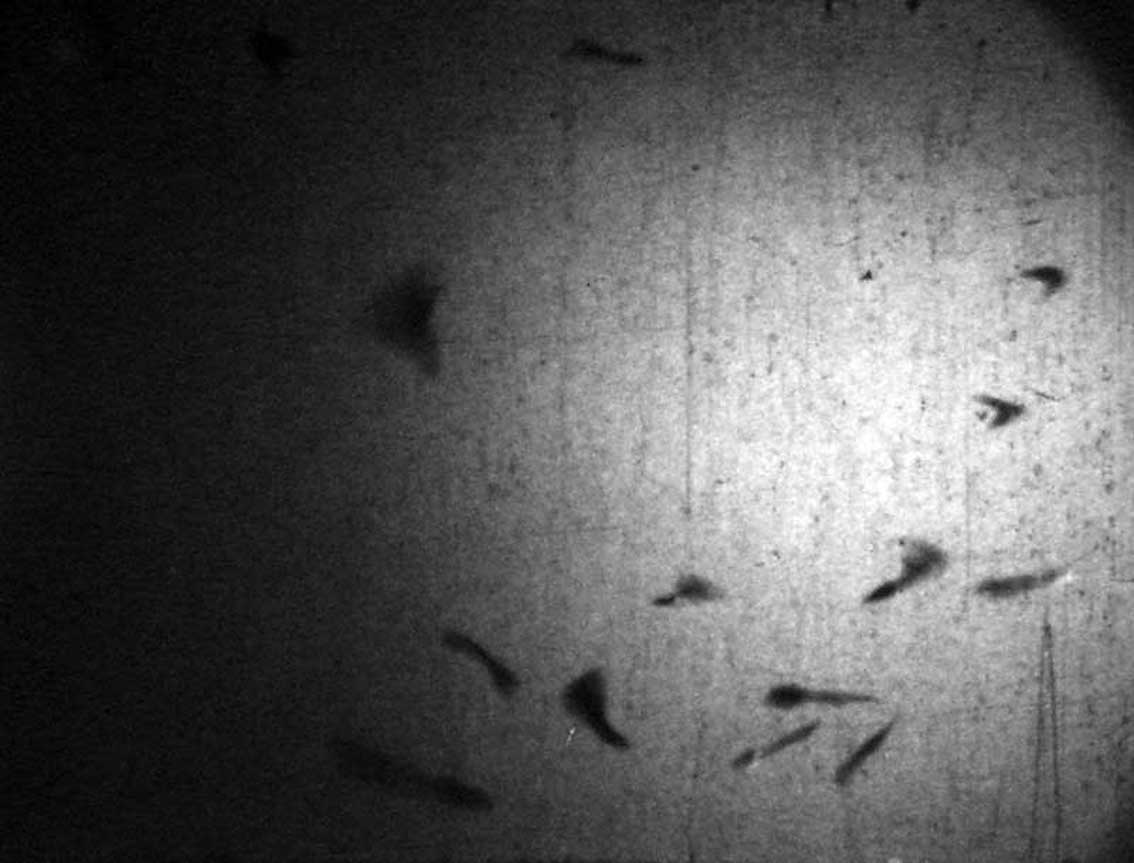
still image
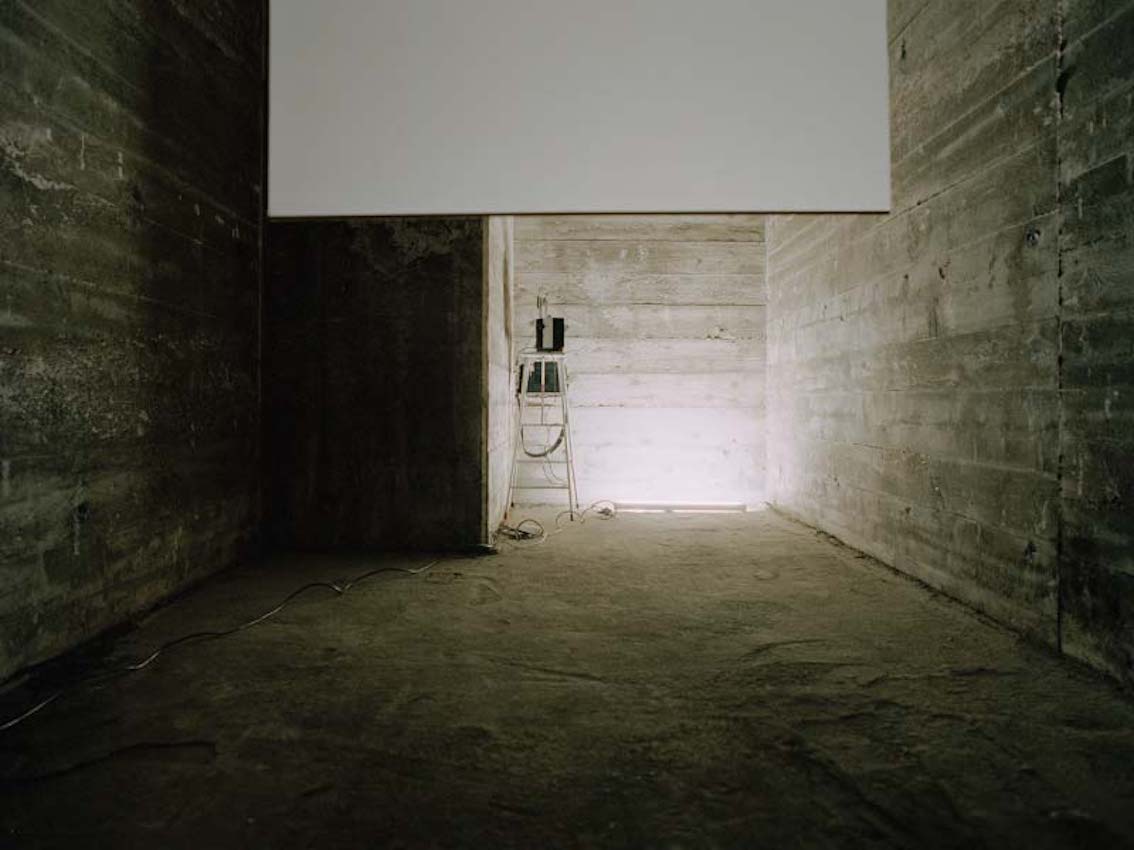
exhibition view (Flakleitturm Arenbergpark):
